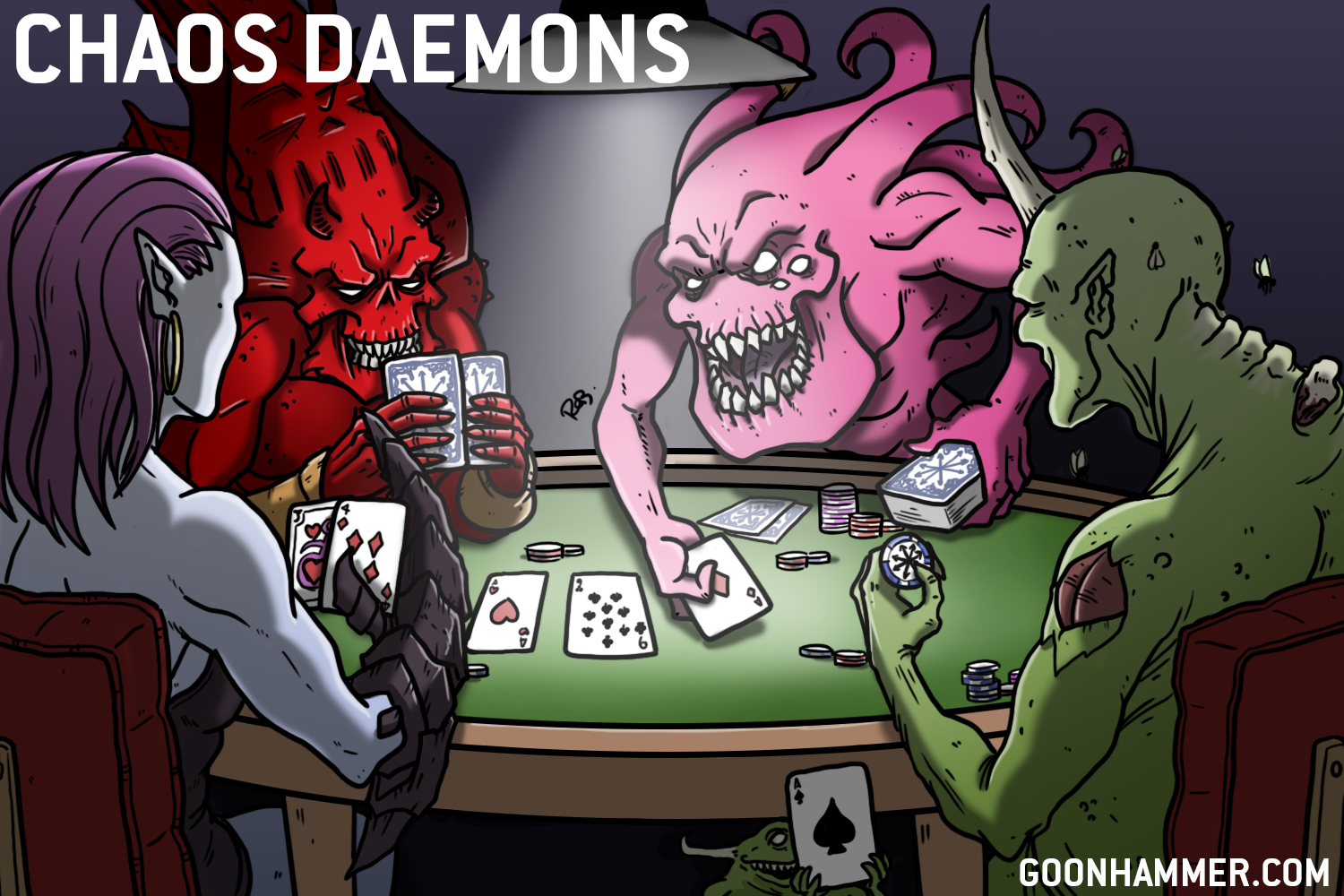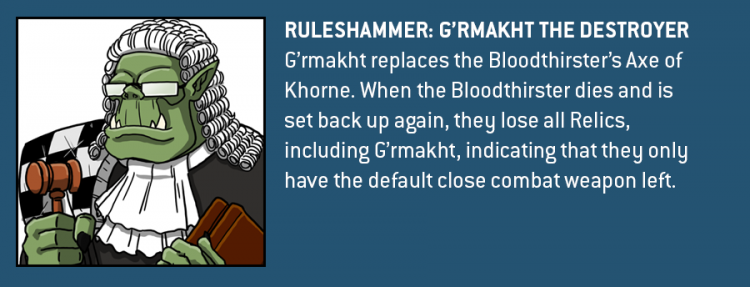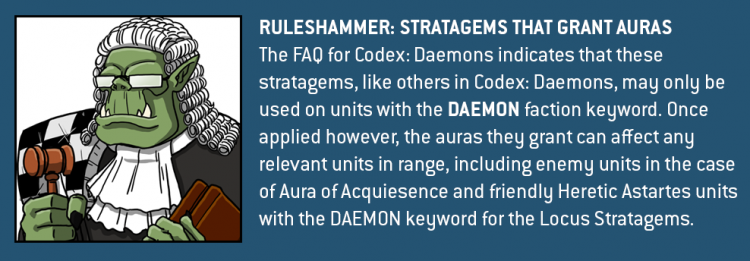This page now references an out of date edition of the game. For Start Competing: Chaos Daemons in 10th edition and onwards, please click here.
Do you like invading realspace with hordes of slavering warp-spawned neverborn? Do you find shooting in Warhammer 40,000 to be kind of a chore, and wish armies spent more time mangling things in melee combat? Does the idea of having to think about armor saves and modifiers rub you the wrong way? Then Chaos Daemons are the army for you friend, and this is your guide to playing them.
A massive thanks goes out to Mike Pestilens, author of the Warphammer blog, for helping write the latest iteration of this Start Competing. Mike was among the top-ranked Daemons players for the 2020 ITC season and writes thoughtful analysis of Daemons on a regular basis. He’s helped write massive sections of this article, and added his own additional thoughts on some units and options.
Army Overview
Chaos Daemons are an army that at first glance, may seem very straightforward and limited. Further investigation reveals a deep, versatile faction that can work well either on its own or as part of a soup army. The core strength of Daemons is in their Greater Daemons and Troops, leading to builds that see players marching hordes of lesser daemons across the table led by towering Monsters… or just pushing a few units of Daemonettes around with as many Keepers of Secrets as they can.
As always, a guide like this represents a time and place. This was written in February, 2021 after the release of the January FAQs and points updates and Codex: Death Guard.
Army Strengths
- Mobility. Daemons have a lot of speed and tricks to show up and move all over the table. Whether it’s teleporting in with Denizens of the Warp, Advancing and Charging with Slaanesh Daemons, Scout-deploying with Nurglings, or making a long charge with the Banner of Blood, you’ve got ways to close the gap and make opponents regret getting too close. This also means you have many ways to get around the table and take objectives.
- Low Cost. Because you aren’t paying for cowardly ranged weapons on most of your units, Chaos Daemons are cheap. Bloodletters, Daemonettes, Plaguebearers, and Horrors are some of the game’s cheapest Troops units, and they receive bonuses for running more than 20 models in a unit which encourages you to take larger squads.
- Melee Combat. Chaos Daemons, particularly on the Khorne and Slaanesh sides of the tetrad, can really put out some hurt in melee that, combined with some of their tricks for getting into melee and their psychic powers, can make up for their lack of shooting.
- Great Characters. Chaos Daemons have access to some great character options for each of the gods. Greater Daemons in particular have improved significantly with the addition of the Exalted rules, but aside from those you have options like Shalaxi Helbane, the Contorted Epitome, the Changeling, and Epidemius, who can help support a variety of strategies.
- Good Troops. The Troop choices in the Daemons army are some of the best in the game. Every one of the options is at least playable, although some are better than others. Nurglings are a standout here, where despite their recent points hike their ability to start the game on objectives can help you get an early start on the primary objectives game.
- Durability: With the Exalted Lord of Change, Great Unclean Ones, and many Nurgle units (especially Beasts of Nurgle) among the most durable units in the game, Daemons are very strong at surviving on objectives. As AP continues to increase across the game, their lack of armour save and reliance on 5++ (or better) invulns has continued to shift from a weakness to a strength.
- Psychic Powers. Daemons – with the exception of those devoted to Khorne – have some decent psychic powers in their arsenal, even if some of them are overcosted. Most HQs in the codex are Psykers, giving the army a way to take plentiful Psyker units to help make up for a lack of shooting and buff the rest of the army. And with the changes to Abhor the Witch, you won’t be feeling the pain of taking 3+ psykers per game quite so severely.
Army Weaknesses
- Shooting. Daemons have very little shooting, and while they have a few longer-ranged options, most of their shooting attacks are short-ranged. If Daemons want to hit at a distance, they typically need to do it with Psychic Powers or add in Chaos Space Marines.
- Open to Secondary Objectives. Although it’s not as bad as it was for Daemon lists before the changes to the Bring it Down and Abhor the Witch secondaries, Daemons lists will frequently leave themselves open to an opponent being able to max out kill secondaries, particularly Assassinate, but Abhor the Witch will also likely still be a viable option against many competitive Daemon builds even if it’s harder to max.
- Warlord Traits. There are some decent Warlord Traits for Chaos Daemons but the faction has no way to give additional Warlord Traits to models.
- Starting CP. Chaos Daemons’ best rules are locked behind stratagems used during list building, and so your typical competitive Daemons list will spend anywhere from 4 to 10 CP before the game even starts, leaving you with fewer options once the first turn begins.
- Blast weapons. While not the bogeyman they were projected to be in 9th edition early on, your large units of troops will make you vulernable to blast weapons. Fortunately changes to morale and your invulnerable saves will mitigate the damage they’re able to do.
Competitive Rating: Top-Tier
While they were a bit underpowered toward the end of 8th edition, the upgrades they got in Psychic Awakening: Engine War and the change to missions and rules for 9th edition – not to mention the recent changes to the Abhor the Witch and Bring it Down secondary objectives – have dramatically improved Daemons’ prowess. The Exalted Lord of Change may be the single strongest unit in the game, and there are multiple builds you can make with Daemons that give you a chance to win major tournaments. They’re nearly neck-and-neck with Harlequins as the game’s top faction, and they work well either as a standalone faction or when combined with some of the mortal Chaos factions.
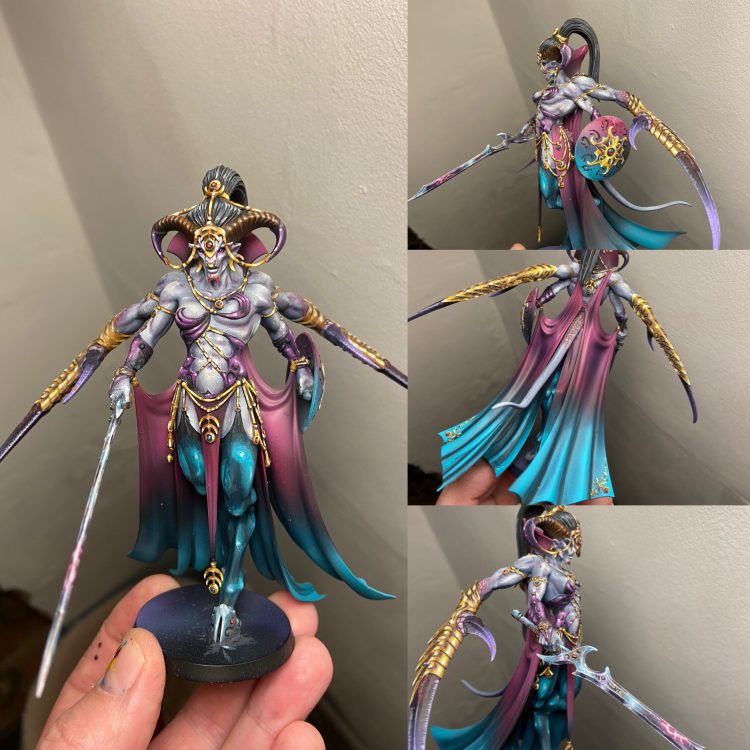
Special Rules
Chaos Daemons don’t have a ton of complicated army-wide special rules, but they make up for it with a lot of complicated special rules on individual units.
Allegiance to the Dark Gods
Most units in the Chaos Daemons army owe their allegiance to one of the four Chaos Gods: Khorne, Tzeentch, Nurgle, and Slaanesh. Think of these as a sort of subfaction, in that most auras, stratagems, and abilities, as well as several detachment bonuses, will only work for Daemons of a specific Allegiance.
Daemonic
Units with this ability have a 5+ invulnerable save. This is the best save that most non-Tzeentch units in the Daemons army have access to, and while it’s useful, it’s not particularly strong. This means that your daemon units are, for the most part, pretty squishy against high volumes of fire unless they’re getting other help.
Daemonic Legions
In a Battle-forged Chaos Daemons detachment, all Troops units gain this ability, which lets them control objectives even if they have fewer models, unless another unit with a similar rule is also on the objective. Every army has some variation of this, but it’s an important ability for holding objectives and it plays to Daemons’ strengths, since some of their best units are Troops choices. Remember that if you have two opposing units with Objective Secured abilities near an objective you revert to the total number of models each player has when determining control.
Gifts of the Gods
Daemons that have an allegiance to one of the four Chaos Gods also get an ability corresponding to that god.
- Khorne: Unstoppable Ferocity. Models with this ability get +1 to their Strength and Attacks characteristics for the rest of the turn any turn in which they charge, are charged, or heroically intervene. Khorne Daemons are at their best in melee combat, and this is one reason why.
- Tzeentch: Ephemeral Form. Models with this ability improve their invulnerable saves by 1, to a maximum of 3+. This means that most Daemons of Tzeentch enjoy a 4+ invulnerable save, which is much more helpful for avoiding death and really helps their smaller units stick around.
- Nurgle: Disgustingly Resilient. When a model with this ability would lose a wound, roll a D6 and on a 5+, that wound isn’t lost. When combined with the fact that Nurgle daemons tend to have a higher Toughness, it makes them frustratingly difficult to move off the table, especially in large numbers.
- Slaanesh: Quicksilver Swiftness. Models with this ability always fight first in the Fight phase. If the opponent has units that have charged, or has other units with a similar ability, then you alternate fighting with these units, starting with the player whose turn it is. This is an ability that got stronger in 9th edition as the changes to combat mean it’s going to be relevant more often, but be mindful that there are now abilities that can turn it off.
Daemonic Ritual
Instead of moving, any CHAOS CHARACTER can attempt to summon a unit of Daemons at the end of the Movement phase by choosing one of the four Chaos Gods (if you have an Allegiance or Mark you can’t choose a God you don’t have allegiance to), and rolling up to three D6. You take a mortal wound if you roll doubles, and D3 of them if you roll triples, but after your roll, you can put a unit of Daemons with power level equal to or less than the result onto the battlefield within 12″ of the summoner and more than 9″ away from enemy units. In Matched play you have to pay the points for these units, but they can be chosen when you summon them and they don’t break anything about your detachment’s rules. This isn’t an ability that sees a lot of play. In part because you usually already know what units you want to play, and in part because you rarely want to give up a character’s movement phase in order to summon. Despite this, there are lists that go in hard on this and use it as a free way to Teleport in a unit that needs to stay hidden until a key turn.
Mike P: The main reason you’ll see summoning used competitively is to get around detachment restrictions on HQ slots, or get around the Rule of 3. Want to run a list with 3 Patrols but need a 7th HQ slot, or want to clog the board up with more than 3 Beast of Nurgle units? You can summon more in once the game starts!
Exalted Greater Daemons
Introduced in Psychic Awakening: Engine War, Daemons now have four stratagems, each costing 1 CP, which can be used to turn a greater daemon for a particular god into an exalted greater daemon. You can only exalt each daemon once, and the stratagem lets you either pick from one of six powerful abilities or roll randomly for two at the start of the game. These are incredibly powerful and you’ll find that you rarely if ever take non-exalted greater daemons again.

The Powers of Chaos
Daemonic Loci
In a Battle-forged army, if a Chaos Daemons Detachment consists only of units with the same Allegiance (see above), then all CHARACTERs in that Detachment gain the corresponding Locus ability. These are essentially auras that improve nearby units (including <God> Daemon units in other Chaos factions), increasing the value of Daemon army HQ choices. That said, while these bonuses are nice, they are usually overpowered by the benefits of mixing and matching daemons of different gods, and so you seldom see them get used at the competitive level, with the exception of Slaanesh detachments, for reasons we’ll discuss in a moment.
There’s one for each Chaos God:
- Khorne: Locus of Rage. Re-roll charge rolls for friendly KHORNE DAEMON units within 6″ of a model with this ability. This is a good ability, but you usually won’t need it since you’ll also be using the Banner of Blood to roll 3D6″ for your charge and using an instrument to get +1 to your rolls. This is more useful if you’re doing some mono-Khorne souping, where it can be used to give units like Warp Talons the ability to re-roll their charges.
- Tzeentch: Locus of Trickery. Roll 2 dice at the start of the Fight phase and discard the highest result. For the rest of the fight phase, any time an enemy unit rolls that number to hit when attacking a TZEENTCH DAEMON unit within 6″ of a Character with this ability, the attack misses. This is the worst of the Loci, where more than one third of the time you’ll find this ability does nothing for you. While taking Mono-Tzeentch detachments is now something you’re likely to do much more often, this still won’t be something to plan for or build around. Just try to remember that you have it if you do take a mono-Tzeentch detachment.
- Nurgle: Locus of Virulence. Whenever you roll a Wound roll of 6+ for a NURGLE DAEMON within 6″ of a unit with this ability, that attack does +1 damage. This is a strong ability, and when you combine it with the fact that Nurglings are the cheapest way to fill out a detachment’s Troop Slots, it’s no wonder that Nurgle detachments were the most common. They’re less common now that Plaguebearers are more expensive, but a 30-model unit within 6″ of a Herald with this ability can still do a lot of damage.
- Slaanesh: Locus of Swiftness. Friendly SLAANESH DAEMON units within 6″ of a model with this ability can Advance and Charge in the same turn. This is very, very useful for helping Daemon units get into combat, and powerful when combined with the high movement value that most Slaanesh units have. It’s the primary reason that Daemon armies running Keepers of Secrets take a separate Slaanesh detachment, even when they’re running undivided or soup lists.
Mike P: While the Khorne, Tzeentch, and Nurgle loci are more “nice to have” than worth building around, the Slaanesh locus is mandatory for lists going heavy on Slaanesh Daemons. The extra d6” threat range gained from advancing and charging gives you the option to semi-reliably make turn 1 charges, and makes it much harder for your opponent to keep units safe all game.
Relics
Chaos Daemons have access to a number of relics, with every god but Nurgle getting four plus another three for each introduced in Engine War that can only be given to Exalted greater daemons. Nurgle only gets 3 base relics, because the followers of Nurgle can’t have nice things.
Note that the Engine War relics have an additional rider on them – they can only be given to an Exalted Greater Daemon if your Warlord is a Chaos Daemon with the corresponding allegiance. Be careful when building your army to ensure that you aren’t accidentally taking a Warlord of a different allegiance and taking a relic you can’t legally take.
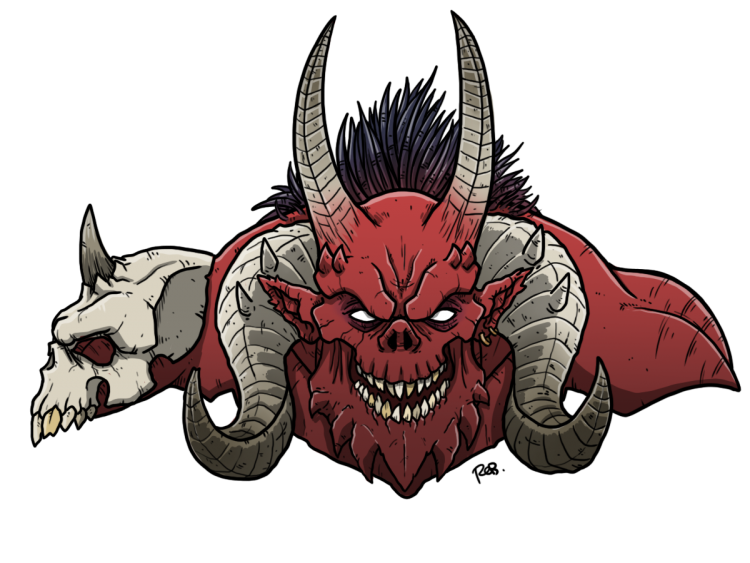
Khorne
The Khorne relics are OK but suffer primarily from the fact that Daemon Princes are massively overcosted for Daemons and Bloodthirsters just don’t have the damage output GW seems to believe they have, making damage upgrades for them kind of mediocre.
- Armour of Scorn – Khorne Monsters only. Gives a model a 4+ Invulnerable save (very useful) and allows them to attempt to deny one psychic power in each enemy Psychic phase (also very useful). A fine upgrade since Khorne Daemon Monsters are essentially glass cannons most of the time. This doesn’t do much for you on a Daemon Prince since you’ll be able to hide him with the “Look Out, Sir!” rules, but is very useful on an Exalted Bloodthirster, particularly given the other defensive buffs you can get for him. B
- The Crimson Crown – Khorne model only. Each time you make a wound roll of 6+ for a friendly KHORNE DAEMON unit within 6” of the bearer, the model that made the attack can make an additional attack with the same weapon (these don’t generate additional attacks). This relic is very strong in lists going heavy on Bloodletter hordes, as the massive amounts of Wounds being rolled all game will consistently generate additional attacks for you. Note that the Crimson Crown is not limited to melee, so it pairs very well with ranged CSM Daemon units like the Khorne Lord of Skulls or Decimators with Soulburner Petards. It is also affected by Wound modifiers like Veterans Of The Long War, so units like Possessed and Warp Talons can generate additional attacks at a high rate. B
- A’rgath, the King of Blades – Khorne model only, replaces a Blade of blood or Hellforged sword. Gives you a S+1, AP-4, D3 Damage sword that can re-roll failed wounds when Targeting a character and if you give it to a monster, its damage improves to a flat 3 damage. It’s… OK. On a Daemon Prince you’re basically looking for this as a potential second relic after you’ve given the Skullreaver to another Daemon Prince but most of the time you’re going to wish you’d just doubled up on talons. Take the Skullreaver before this. On Heralds it’s not really worth spending the relic. C
- Skullreaver – Replaces an axe of Khorne, great axe of Khorne, or daemonic axe. Profile is S+3, AP-4, D6 Damage and against TITANIC units you re-roll failed wound rolls. Additionally, each time you roll a 6+ to Wound, your target takes an extra D3 mortal wounds. Now we’re talking, this thing is great. It’s money on a Daemon Prince of Khorne, though as a result its utility is diminished as they’ve become overcosted. This doesn’t offer enough value over an Axe of Khorne on a Bloodthirster to justify taking it, especially when you have the Engine War version that gives you a damage floor. There’s never a good reason to take this over a Great Axe of Khorne. B+
Engine War – Artefacts of Blood
G’rmakht the Destroyer – Replaces an Axe of Khorne with one has a damage floor of 3. Additionally, when the model is killed you roll a D6 and on a 4+, you stand that model back up with D6 wounds remaining. It loses all Warlord Traits, Relics, and Exalted abilities it had and instead gains Rage Unchained (count as double wounds remaining for profile purposes). If it was your Warlord, your Warlord still counts as having been destroyed. This is a pretty neat suite of bonuses. The damage floor on the axe is pretty great, and helps make non-Insensate Rage Bloodthirsters quite a bit more viable, plus the “get back up again” ability is neat, though standing back up with only the default melee weapon means your Bloodthirster is uh, not going to do that much with, best-case scenario, 7 S7 AP- attacks. That said, note that this interpretation of the rules for “losing the axe” is a bit odd and it’s unclear if “having no weapon” is the intended state when you stand back up versus “having the default axe.” B
Blood-Drinker Talisman – Roll a D6 each time this model kills an enemy model with an attack made by a melee weapon and on a 5+, this model regains 1 lost wound after all its melee attacks have been resolved. You can’t regain more than 8 lost wounds per turn with this. This is a neat little upgrade that combines well with Rage Unchained and Blood-Blessed to make your Bloodthirster much more difficult to kill, and while it doesn’t do much to improve its damage output, it will help you avoid being bracketed. The big issue here is that the Bloodthirster doesn’t have enough attacks to really make this work. It’s only really worth considering on a Bloodthirster of Insensate Rage, where you can double your attacks output by switching to the axe’s Sweeping Blow profile. B-\
Rune of Brass – Enemy Psykers suffer Perils of the Warp on any psychic test where they roll doubles if they’re within 16” of this model, and if they Perils they take flat 3 mortal wounds. This is a neat deterrent but it’s only going to matter in games against multiple psykers and even then it may not come into play given it’s only a 1 in 6 chance and the opponent will opt to re-roll whenever possible. C-
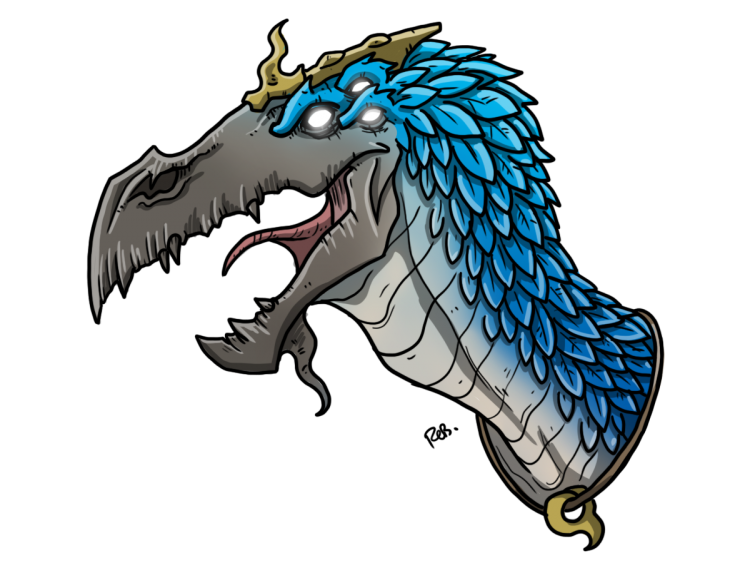
Tzeentch
There are some interesting Tzeentch relics but the primary play here is windmill slamming the Impossible Robe on your Lord of Change. While the good news is that the Impossible Robe doesn’t require a Tzeentch Warlord to take, you’ll probably still want your Lord of Change to be your Warlord so you can give it the Incorporeal Form trait on top of its Robe.
- The Impossible Robe – Tzeentch. Gives a model a 4+ invulnerable save (that will be increased to 3+ with Ephemeral Form), and the ability to re-roll a save once per game, but if you roll a 1 you die immediately. This is great on Daemon Princes and Lords of Change, and combines wonderfully with the new Exalted buffs for the Lord of Change to make nigh-unkillable bird birds. This is basically an auto-include, must-take relic for any army running a Lord of Change. Note that you’ll want to avoid using that re-roll until it’s already a do-or-die situation. A+
- Soul Bane – Tzeentch Heralds only. Replaces a ritual dagger with one that’s Strength: User, AP-5 1 damage and prevents the enemy from taking invulnerable saves. I’m a little unsure why they didn’t just make this do mortal wounds but fine. It can only be taken on models with 2 or 3 attacks with a WS4+, and replaces their melee weapon with a rule that heals them, making it almost worthless. D-
- The Endless Grimoire – Tzeentch Psyker only. Gives you an additional power. This is more useful when you don’t have an army loaded up with Psykers, which means it’s more useful for non-Tzeentch Daemon armies, which will typically have 5-6 psykers and don’t need spells they can’t cast. C-
- The Everstave – Tzeentch only. Replaces a Rod of Sorcery or Staff of Change and gives you +1 to Psychic tests when you attempt to Smite. This is better than the range bonus you’d get, but it stinks that you have to give that up. The ability is OK but there are better things to spend your relic slot/CP on. C
Engine War – Artefacts of Change
Engine War added three relics for Exalted Lords of Change. None of these are particularly relevant in a competitive setting.
- Warpfire Blade – Replaces a baleful sword with one that gives you an extra Strength boost (S+2, AP-3 D6 damage) and loses the -1 to hit, plus unmodified wound rolls of 6 do D3 mortal wounds on the target in addition to the normal damage. This is a pretty tasty melee weapon but you’ve already given your Lord of Change the Impossible Robe. On a second Lord of Change, this is a decent pick. B
- Soul-Eater Stave – Roll a D6 each time this model destroys an enemy model with a manifested psychic power; on a 4+ this model immediately regains 1 lost wound. YOu can’t regain more than 9 wounds per turn with this relic. This is pretty nifty as a secondary way to keep a Lord of Change alive and it can be hilariously demoralizing for an opponent to watch you regain wounds that were very difficult to take off in the first place. That said, it’s never gonna be your first pick over the Impossible Robe and preventing the wounds from being lost in the first place is a much better strategy than potentially regaining them. B-
- The Crystal Tome – At the beginning of your opponent’s turn, pick one enemy Character within 12”. You and your opp roll off, adding the Ld of your models to the rolls. If you equal or beat their roll, then they lose all AURA abilities until the beginning of their next turn. This is pretty neat, and it helps that the Lord of Change has Ld 10, but it requires you to get pretty close to a dangerous model and is still likely to fail you one third of the time against Ld 9 marine characters. C+
Mike P: While realistically none of the codex Tzeentch relics are worth considering over the greatness that is the Impossible Robe on a Lord of Change, all of the Engine War Tzeentch artefacts are worth considering buying with CP if you want to run more than one Lord of Change. A Lord of Change with the Warpfire Blade hits surprisingly hard in combat and is a great target for Boon Of Change, where +1 Attack/+1 Strength/+1 Toughness are all good outcomes from the random buff. The Crystal Tome is relevant often in a world where Marines are often relying on a Bike Chaplain with Rites of War to provide ObSec and reroll auras in the midfield, but it has too many matchups where it won’t have an effect.
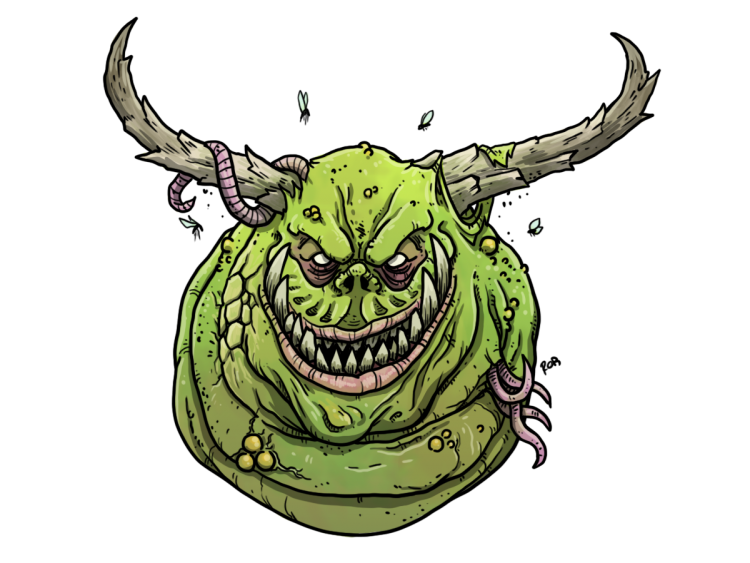
Nurgle
The Nurgle relic options are pretty poor; they don’t really do much for what the army wants to do and there isn’t enough reason to take a Nurgle Daemons Warlord to get even the better options in the Artefacts of Decay.
- Horn of Nurgle’s Rot – Nurgle. Roll a D6 every time the bearer kills an enemy in the Fight phase within 7″ of a friendly unit of Plaguebearers. On a 4+, you get to add a Plaguebearer to that unit. You’ll need to spend reinforcement points if you want to go above the starting total, but this can be OK. The major issue is that Nurgle Daemons tend to rely on their characters for buffs and not kills, and large plaguebearer blobs are a thing of the past. C+
- The Entropic Knell – Nurgle only. Enemy units get -1 Ld within 7″ of the bearer. This effect isn’t strong enough at 21″, let alone 7. D
- Corruption – Nurgle model, replaces a plaguesword, balesword, bileblade, or hellforged sword with one that’s S+2, AP-3 D3 Damage and re-rolls failed wound rolls. It’s OK. Not what you want on a Daemon Prince or Great Unclean One, where the Strength boost is nice but talons and the sword are a better deal, and your Poxbringers aren’t trying to fight anything. C+
Engine War – Artefacts of Decay
- Effluvior – Replaces a Plague Flail with one that’s Assault 6, S+1, AP-3 2 damage. That’s a pretty solid upgrade, since the unsaved damage spills over. The downside is that flail Unclean Ones aren’t really the build right now. B
- Tome of a Thousand Poxes – This model knows one extra power from the Nurgle discipline and each time you attempt to manifest a power, if the roll is 7, then the power can’t be denied. This notably doesn’t let you actually cast an additional power, and while the “can’t deny” clause is neat, your odds of rolling a 7 on 2d6 are only 1 in 6, making it a bit underwhelming. C+
- The Endless Gift – A model with this relic regains one lost wound at the end of each phase in which it lost wounds. This is pretty decent, and combines well with Revoltingly Resilient to make a model that can be an absolute chore to try and bring down. You’ll rarely have a Great Unclean One or Nurgle Daemon as your warlord but if you do, this is probably your best option among the Nurgle relics for them. B+
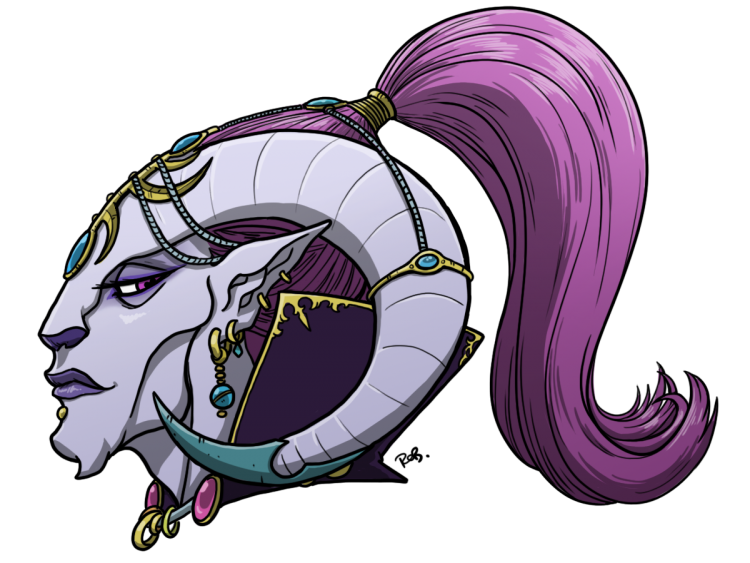
Slaanesh
Slaanesh armies are blessed with the best set of relics of the Chaos Gods, even if none are as singularly good as the Impossible Robe. Slaanesh-heavy builds will frequently be rocking multiple relics, and it’s worth considering a Slaanesh Warlord for Silverstrike if you’re running multiple Keepers of Secrets.
- The Forbidden Gem – Slaanesh. Once per game, you can use the gem to try and hypnotize an enemy character within 12” at the start of any enemy phase. You roll 3D6 and if you roll over their Ld, they can’t act until the end of the phase and their auras are turned off. This is a very powerful effect and one that will succeed most of the time given that an average roll on 3D6 is 10.5 (and that’s before you start factoring in Ld modifying abilities and psychic powers like Phantasmagoria). Speaking of which, it works very well on a Contorted Epitome with said power. A+
- The Mark of Excess – Slaanesh. Gives you +1 Attack and an extra +1 each time you kill a CHARACTER or MONSTER. It’s OK, but it’s not really the effect you want to spend a relic slot or CP on. C+
- Soulstealer – Slaanesh. Replaces a Witstealer sword or Hellforged sword with one that’s S+1, AP-3, 3 Damage and each time you kill a model, you regain a lost wound, plus you re-roll failed wounds against AELDARI units. Going from Strength 8 to Strength 7 on a Keeper of Secrets isn’t great but the ability to regain wounds on a model with a the ability to ignore incoming damage is better than the -1 to be hit in melee. It’s not something every build wants, but it’s worth consideration in the right lists/environments. The big downside is that this has kind of been replaced by Silverstrike, which lets you come in at S8 and 3 damage. The good news is, you probably take both if you’re running Keepers of Secrets. B
- Slothful Claws – Slaanesh Herald only. Replaces their claws with a set that are S+1 AP-2, 2 Damage and go to AP-4 on wound rolls of 4+ instead of 6+. A major upgrade but not something you desperately need on a model whose primary purpose is buffing others. Probably going to give you the most value on a Hellflayer Herald. B
Engine War – Artefacts of Excess
- Silverstrike – Replaces a Witstealer Sword with one that’s 3 damage and when the bearer fights it gets to make 2 extra attacks with this weapon, plus you keep the -1 to be hit by melee attacks from models that have lost wounds to this weapon. The hit modifiers are whatever, but this is on the whole going to be better than the Soulstealer because it lets you keep S8 while adding the 3 damage and 2 extra attacks. It’s a major upgrade and likely to be your first artefact if you’re running Slaanesh Daemons (though taking it and Soulstealer on a pair of Keepers is a fine play). B+
- Whip of Agony – Replaces a living whip with one that’s Assault 6, S6, AP-3, 2 damage and the attacks automatically wound non-Vehicle, non-Titanic targets. This is pretty neat but it’s just never going to be a better option than one of the sword upgrades on a Keeper of Secrets. This also requires you not take the Sinistrous Hand or Aegis, which is another downside. B-
- Jewel of Excess – When a model with this relic takes a Psychic test while attempting to manifest a Slaanesh power, add 1 to the result, and they get +1 on their Deny attempts. This is a strong effect, but suffers from the fact that Slaanesh powers are pretty easy to cast and the fact that most Slaanesh-heavy builds want multiple Keepers of Secrets with upgraded gear and the fact that the Forbidden Gem is going to beat it out. C-
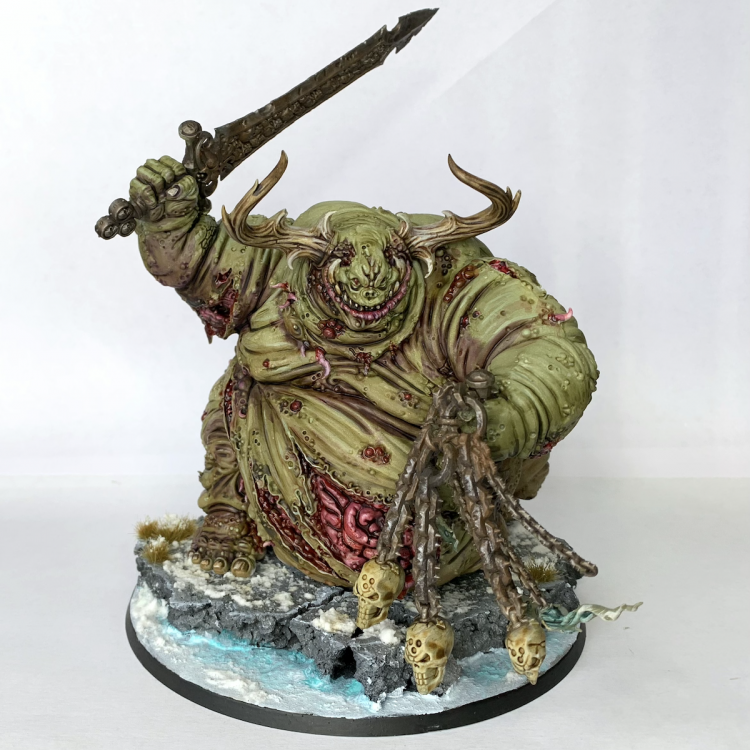
Stratagems
There are seven generic Chaos Daemon stratagems and 3 for each god in the main Codex, while Engine War introduced an additional 20. These stratagems are broken into 4 for each allegiance, and each one affects a specific unit or set of units (such as PLAGUEBEARER CAVALRY). Four of these are the Exalted Greater Daemon stratagems, which upgrade a greater daemon unit in important ways.
Note that, despite the wording on Stratagems to refer to CHAOS DAEMON units, it has been ruled via FAQ that you cannot target other factions’ daemons (such as Thousand Sons Daemon Princes or Myphitic Blight-Haulers) with these stratagems. Other abilities such as auras and unit abilities affect Daemons from other books, though. This is a pretty subtle distinction, so it’s worth keeping in mind – you can’t use a stratagem like Locus of Wrath on a Chaos Space Marines Daemon Prince of Khorne, but once you’ve used it on a Bloodmaster, that aura won’t care what faction the relevant daemons belong to, so the Aura will affect Khorne Warp Talons in range.
General Stratagems
- There are seven stratagems that can be used by daemons of any allegiance. Denizens of the Warp is particularly noteworthy among these, as it’s going to be a go-to way of getting your units into Deep Strike Reserves and will usually be more CP-efficient than Strategic Reserves. For more on Strategic Reserves vs. Denizens of the Warp, scroll down to our section on Power Ratings Updates below.
- Denizens of the Warp (1/2 CP) – Used during Deployment to put a unit of Daemons into Reserves, so they can show up anywhere on the table more than 9″ away from any enemy units. If the power level of the unit you’re putting into the warp is 9+, then this costs 2 CP instead. This is one of the quintessential Chaos Daemon stratagems, used to put powerful units such as Bloodletter Bombs into deep strike so they can show up, activate their banner of blood, and charge the enemy immediately. You’re going to use this stratagem at least once in most games. A
- Daemonic Possession (1 CP) – When an enemy psyker suffers a perils, they take another 1D3 mortal wounds. Remember that death due to Perils causes wounds to nearby units, making this a somewhat rare but fun treat to use when it goes off, and that the very least having it in your back pocket means that your opponent will almost always have to spend a CP to try and avoid a perils. Sometimes the best stratagems are the ones you don’t even have to use. B
- Daemonic Incursion (2 CP) – Played when a non-named Character DAEMON unit is destroyed by a GREY KNIGHTS unit. Return the unit to the battlefield, at full strength, anywhere more than 9″ from an enemy model at the end of the next Movement phase. This doesn’t cost you any points, which means it’s just some hilarious nonsense you can pull if you happen to be up against Grey Knights. This is the balancing factor that makes Grey Knights vs Daemons a competitive matchup. While people may debate whether it’s enough given all of the Grey Knights’ buffs against Daemons, it certainly is an excellent stratagem when relevant. A+ when you can use it, but overall D due to how niche it is.
- Warp Surge (2 CP) – Use at the start of any phase. Improves a unit of Daemons’ invulnerable saves by 1 for a phase (to a max of 4+), but they can’t re-roll any of their saves. Helpful when you need to protect a large unit of Bloodletters, Plaguebearers, or Daemonettes from being shot up. Having to use this at the start of the phase (and before your opponent chooses a target) is a rough downside, but it’s still solid as a deterrent if nothing else. B+
- Soul Sacrifice (2 CP) – Use when a Chaos Character from your army tries to summon a unit of Daemons using a Daemonic Ritual. The character takes D3 mortal wounds, but you can roll 4 dice instead of 3 for the attempt, and while the summoned unit is within 6″ of the summoner, it re-rolls hit rolls of 1. You basically need this if you’re attempting to summon a Greater Daemon, where rolling 14+ on 3D6 just doesn’t give you enough of a chance to make that reliable, but you probably won’t need it otherwise, since 3D6 will do for most anything you’d actually want to summon. That said, it can be solid if you summon a large unit that can benefit from re-rolls, though you typically don’t want to be summoning things thanks to how the rules for summoning work. C-
- Rewards of Chaos (1 / 3 CP) – Extra relic stratagem. You’re going to use this a lot. A
- Daemonic Pact (1 CP ) – Use when a Chaos character summons a Daemon unit to the table with a ritual. They can do a second summoning attempt. You’ll rarely summon one unit, let alone two, but as long as you’re holding a key character in place to summon, this is an option, I guess. C
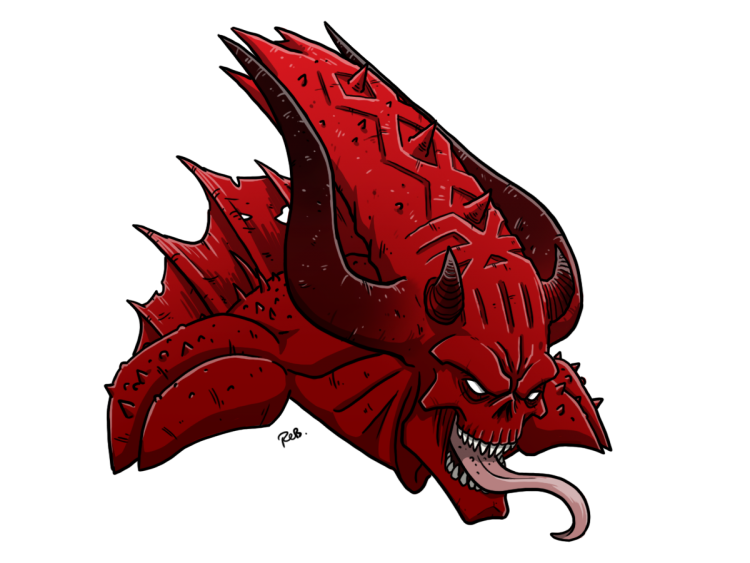
Khorne
As you might expect, the Khorne stratagems tend to focus on melee combat and making your units more deadly. They’re ultimately capped in utility by the fact that most of their units just aren’t that good, though the Banner of Blood is a standout here.
- Banner of Blood (1 CP) – Used before the battle. Upgrades a banner to a Banner of Blood which, once per game, can be activated to let one unit charge 3D6” instead of 2D6”. This is incredibly good, and how you’ll get your Bloodletters into combat the turn they arrive from the warp. Remember that if they’re near a Herald (or other KHORNE DAEMON CHARACTER) in a Khorne-devoted detachment, they’ll also get to re-roll to their charge distance. The average charge distance you’ll roll in those situations is 10.5, more than enough to close the distance. Pretty much the only reason to bring Bloodletters to the table these days. A+
- Locus of Wrath (2 CP) – Used in the Fight phase. You pick a KHORNE DAEMON CHARACTER in your army and until the end of the phase you can re-roll failed hit rolls for KHORNE DAEMON units within 6”. This is OK. The re-rolls are the old type that get messed up by modifiers, but unless you’re fighting Plaguebearers, that won’t matter most of the time in melee. The big problem is that 2 CP is a lot to pay for the effect. B
- Frenetic Bloodlust (3 CP) – The Khorne “Fight again” stratagem. Goes off at the end of the Fight phase. It’s very good, but expensive. Notably has no restrictions on the type of KHORNE units it can be used on, which is just lovely. A
Mike P: This stratagem sounds great in theory, but can be a massive trap for newer Khorne players. Khorne Daemons hemorrhage CP pre-game with all of their Banner of Blood upgrades, paying to deepstrike units, and Exalting Bloodthirsters and buying additional relics. You’ll only be able to use Frenetic Bloodlust once per game, if ever, so you want to make sure it’s in a perfect situation to generate a Victory Point swing. You should rarely be using this for additional damage, instead looking for opportunities to use a second activation to move more Bloodletters onto objectives or into better screening/wrapping positions.
- Rage Eternal (3 CP) – Used in the Fight phase when a model in a Bloodetter Infantry unit is destroyed. Until the end of the phase, each time a model in the unit is destroyed roll a D6; on a 4+ that model isn’t removed until the attacking unit’s melee attacks are resolved, and before you remove it, it can make all of its close combat attacks against the unit that destroyed it and can do so even if it couldn’t normally target that unit. This is a powerful effect that can help punish the crap out of someone counter-charging your glass cannon bloodletter units and 4+ is just good enough to make it worthwhile when you know you’re going to bite it. 3 CP is a lot to spend on this though, so it’s probably going to be something you don’t use often. B-
- Brass Stampede (1 CP) – Use in the Charge phase when a unit of Bloodcrushers (or Skullmaster!) finishes a charge. For each model in that unit, pick an enemy unit within 1” of that model and roll a D6; on a 2+, that enemy unit takes a mortal wound and on a 6, they take D3. If you end up destroying all enemy units within 1”, you can immediately declare another charge. This could be really neat with 9th edition charge rules, where you can pick a sufficiently close unit with a plan to charge “through” them with a big enough charge. The problem is that if the unit has more than 3W worth of models your chances of actually living this dream are pretty small. So it’s more like a way to get a couple of extra mortals on a target. C
- The Scent of Blood (1 CP) – Use in the Charge phase. Pick a unit of Flesh Hounds in your army – that unit can charge even if it Advanced this turn and in addition, it gets +2 to its charge rolls if any enemy non-Vehicle models have been destroyed this turn. This is pretty great–it can slingshot a unit of Flesh Hounds across the table, or with careful planning, let them make a charge out of Deep Strike. It’s a solid ability but the only downside is that Flesh Hounds aren’t very good. B+
- Bound in Brass and Bone (1 CP) – Use this stratagem in any phase when a Bloodletter Chariot is chosen as the target of an attack. Until the end of that phase, halve incoming damage from attacks that are made against that unit (rounding up). This is a great way to protect a Skull Cannon or Blood Throne, with the only downside being that you’re unlikely to be running these units. B
Mike P: Even if deep-striking your Bloodletter bomb into a unit that is giving you -4” to your Charge roll (such as a unit with -2” to Charge that’s also behind Difficult Ground), the unit still has a 60% chance of making the charge between the +1” from the Icon, 3d6” charge from the Banner of Blood, and a re-roll from the Khorne detachment or a CP. The look on your opponent’s face when you needed to roll a 13” charge and calmly spike it is incredible. Just note that the Banner of Blood doesn’t help you get around the requirement that you need to be within 12” to declare a charge.
Exalted Bloodthirster (1 CP)
This Stratagem is used to make a Bloodthirster Exalted. You can choose one of the following upgrades during army construction or roll for two before the battle begins, re-rolling if you get duplicates:
- Hellfire-Wrought Armour: This model has a 2+ save. Great boost to durability. B
- Blood-Blessed: This model cannot lose more than 8 wounds per phase. Very solid way to keep your Bloodthirster on the table, but getting bracketed will reduce your model’s damage output pretty quickly. B+
- Arch-Murderer: Add 1 to the damage characteristic of weapons this model is equipped with. A very solid boost on the sweeping profile of the Great Axe of Khorne. B+
- Slaughterborn: If this model makes a Charge move, is charged, or Heroically Intervenes, it gets +1 Strength and Attacks until the end of the following Fight phase, stacking with Unstoppable Ferocity. The additional Strength is often irrelevant except on Bloodthirsters of Insensate Rage, where the additional Strength gets your main attack up to Strength 16 to crack open T8 Vehicles with ease. C
- Rage Unchained: This model is considered to have double the number of remaining wounds left when determining which profile to use on the damage table. This is a great way to keep your Bloodthirster relevant longer and combos wonderfully with Blood-Blessed and the Blood-Drinker Talisman. B
- Unrivalled Battle-lust: Add +2 to charge rolls for this model and it can Heroically Intervene if enemy units are within 6” and move 6” when doing so. While deepstriking Exalted Bloodthirsters quickly becomes very costly in terms of CP, getting +2” to your charge rolls (which also get free re-rolls in a Khorne detachment) allows you to make charges with your Bloodthirster out of deep-strike at a surprisingly effective rate. B+
These are all pretty good, and only limited by the sad fact that Bloodthirsters just aren’t that great. The best of these are likely Blood-Blessed and Arch-Murderer, but they all help a unit that sorely needs it and if you’re bringing a Bloodthirster it’s worth just rolling for two so you can get as big a boost as possible.
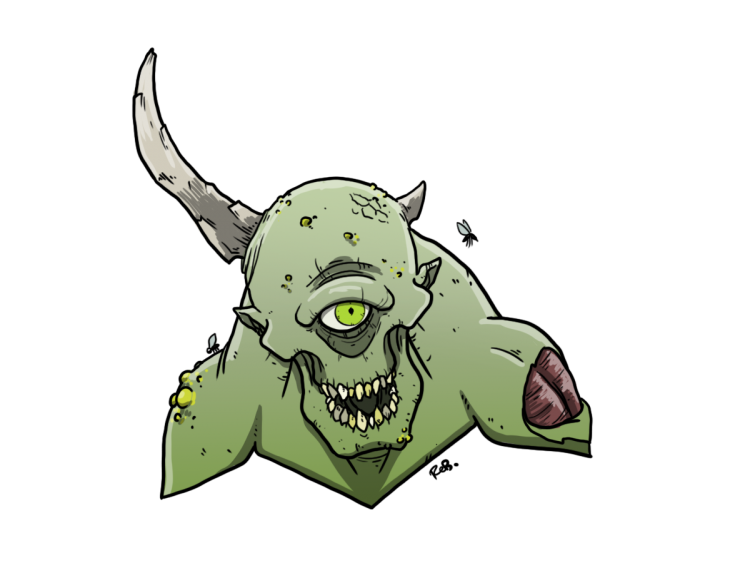
Nurgle
The Nurgle stratagems tend to favor making your units harder to kill. This works well with their stratagem of being annoyingly difficult to remove from objectives.
- Revolting Regeneration (2 CP) – Use at the end of your movement phase to have one model in a Nurgle Daemon unit regain D3 lost wounds. If there aren’t any wounded models, you can get one back with a single wound left. This is too expensive to be something you use often, but the most fun way to use it is to have it bring back a 30+ point model in a squad of Beasts of Nurgle or Plague Drones. Both of those are pretty decent now, particularly the Beasts of Nurgle, and they can be frustratingly difficult to handle once they reach the middle of the table and can start bounding into combats for free. B
- Plague Banner (1 CP) – The Nurgle banner upgrade stratagem. Use pre-game to upgrade a single Icon in a Nurgle unit, then once per game you can activate it to change the damage characteristic of a unit of plaguebearers to 2 until the end of the phase. This is really good, but tied to the utility of large units of Plaguebearers, so suffers a bit as their point costs have been brought up. Still, while it’s not super competitive, suddenly giving a squad of 30 of those things D2 weapons that re-roll wounds is incredibly nasty and when paired with their other buffs, can make them capable of taking down a surprising amount of units. B-
- Locus of Fecundity (2 CP) – Use at the start of any phase to give a Nurgle Daemon character in your army an aura that allows friendly Nurgle Daemon units within 6″ to re-roll DIsgustingly Resilient rolls of 1 for that phase. This can be useful for protecting your units in an early shooting phase, but it’s an expensive stratagem to roll out and the bonus isn’t typically worth it unless you’re going to be giving it to a lot of models. But it’s a useful tool to have. Unfortunately the new changes to Disgustingly Resilient for Death Guard means that this will lose a lot of synergy since it’ll no longer work on the likes of Plagueburst Crawlers and Death Guard Daemon Princes. B-
- Rust and Decay (1 CP) – Use in the Fight phase on a Plaguebearers Infantry unit. Until the end of the phase, when you make an attack with a model in that unit, an unmodified hit roll of 6 automatically hits and wounds the target (no roll required). This is just OK. It’s a neat bonus for large units of Plaguebearers, but it doesn’t combo with Locus of Virulence or Virulent Blessing, which proc off wound rolls. That’s largely OK if you aren’t going Mono-Nurgle, but you’ll also rarely take large blobs of Plaguebearers to make use of this anyways. C-
- Putrid Demise (1 CP) – Use when a Plaguebearer Cavalry is destroyed. Roll a D6 for every non-NURGLE unit within 6”; on a 2+, that unit takes a mortal wound. This is pretty neat for spiting your opponent, and is a bit better now that Plague Drones got 5 points cheaper in the January 2021 update. B
- Acidic Slobber (1 CP) – Use in the Fight phase. Pick a Beasts of Nurgle unit in your army. Until the end of the phase, when resolving attacks made by a model in tha tunit, an unmodified wound roll of 6 does an extra mortal wound to the opponent. Like all of these stratagems, this one mostly depend on having high volumes of attacks to make anything useful come of it. Fortunately, units of 9 Beasts of Nurgle are surprisingly viable (to the point that you might take more than one!), and throwing out 35 attacks with a unit of 10 is likely to net you 3-4 mortal wounds thanks to the ability to re-roll failed wounds. The key situation for using this is when you have a large unit of beasts stuck in combat with a tough unit like Vanguard Vets or Terminators which could otherwise tarpit them forever. B
- Nurgling Infestation (1 CP) – Use at the end of any phase except Morale. Pick a unit of Nurglings and roll a D6 for each model in that unit that was destroyed that phase. For each 5+, return a destroyed model in that unit to the battlefield with all its wounds remaining, making sure it’s in coherency. This is a pretty nifty way to punish an opponent for leaving a single Nurgling base alive after taking down a few, but it won’t be worth it to use most of the time unless you’ve lost 2 or more units in a phase. Still, Nurglings are pretty good and can be terribly annoying to remove, and this can be nasty when used at the right time. B+
Mike P: Revolting Regeneration is rarely worth it to heal Wounds except on a Great Unclean One, but bringing back a model is great. Especially since the model returned with one wound can immediately be healed in the Psychic Phase with Fleshy Abundance, and you can also gain a ton of movement for your Beasts or Plague Drones by being added in front with their large base. Rust And Decay is a complete miss as with built-in Wound re-rolls and damage bonuses based on Wound rolls, spending a CP for a small chance to skip your Wound roll isn’t what Plaguebearers needed.
Exalted Great Unclean One (1 CP)
This Stratagem is used to make a Great Unclean One Exalted. You can choose one of the following upgrades during army construction or roll for two before the battle begins, re-rolling if you get duplicates:
- Bloated with Corruption: This model becomes Toughness 8. This is a big boost in a bolter and melta meta, but it’s not quite as good as Revoltingly Resilient. A
- Revoltingly Resilient: Add 1 to all Disgustingly Resilient rolls made for this model. This is the clear winner of the bunch, and the one you want to pick every time, effectively giving you a GUO with 36ish wounds. A+
- Avalanche of Rotten Flesh: When a charge roll is made for this model, add 1 to the result and this model’s Crushing Bulk ability inflicts D3 mortal wounds on a 2+, instead of 1 mortal wound on a 4+. This is kind of mediocre, since your GUO is pretty slow to begin with. C
- Living Plagues: When resolving a melee attack from this model, a successful hit roll scores 1 additional hit if the attack’s Strength is at least twice the target’s Toughness characteristic. It’s good with the Bilesword since you’re likely to be going up against a lot of T4 targets but at S8 you’re going to be limited in what it’s useful against. C+
- Gift of Bountiful Vomit: In each of your Shooting phases, you can pick one enemy unit visible to this model and roll one D6 for each model in that unit within 12” (to a max of 7 dice). For each 3+, that unit suffers 1 mortal wound. This is a pretty strong attack, and being able to toss out 3-4 mortal wounds per Shooting phase is very solid. B
- Hideous Visage: Enemy units within 12” get -1 Ld and -2 within 6”. This is just not what you want from an Exalted greater daemon, and most of the reason you don’t want to roll for Great Unclean Ones. D
Several of these are decent, but they aren’t all winners and the clear choice among them is Revoltingly Resilient. In serious settings you’ll want to go ahead and opt for that rather than chancing it on rolls (though it’s amazing when you can live the dream of having a 4+++ and Toughness 8). That said, if you’re taking several of these it may behoove you to pick Revoltingly Resilient on one and roll for the rest.
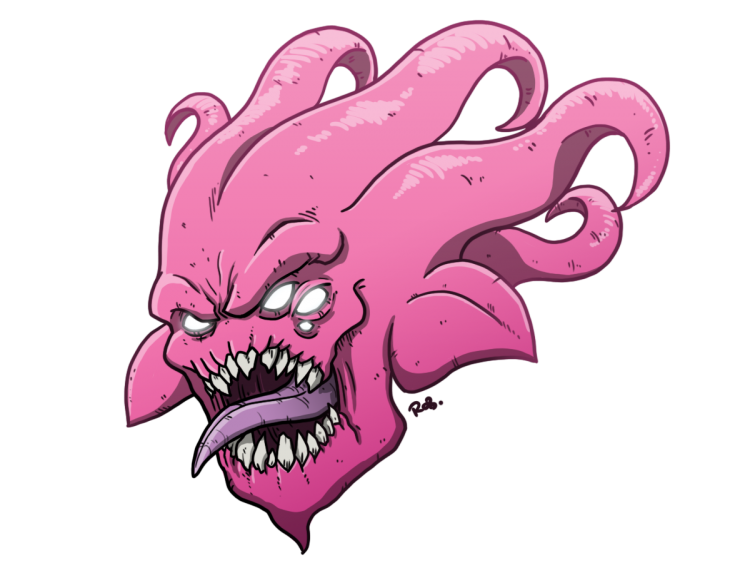
Tzeentch
- Blasted Standard (1 CP) – The Tzeentch icon upgrade. The Blasted Standard can be activated once per game and when you activate it, you roll 9 dice and for each roll of 6, the closest visible enemy unit takes a mortal wound. So on average, you’ll get 1-2 mortal wounds with this, which just isn’t enough to make this worth using. It’s the only banner that sucks. D-
- Magical Boon (1 CP) – Use at the end of your Psychic phase and pick a Tzeentch Daemon Psyker from your army; it can immediately attempt to manifest an additional power this turn. Helpful when you need to throw out one extra power to set something up or dish out some mortal wounds. B+
- Locus of Conjuration (2 CP) – Use at the start of your Psychic phase and pick a Tzeentch Daemon character from your army. For the rest of the phase, you can re-roll failed psychic tests for friendly Tzeentch Daemon units within 6″ of that model. This is a really good power that’s helpful for pushing through all of those high-cost powers in the Tzeentch Discipline. Oh and also the Discipline of Change that Thousand Sons Daemon Princes have access to – like the other auras, you can’t use this to give a Thousand Sons Daemon Prince an aura, but they can benefit from it if it’s on a Chaos Daemons unit. B
- Minions of Magic (1 CP) – Use at the start of your psychic phase. Pick a Horrors Infantry unit from your army. The first time that unit attempts to manifest a psychic power this phase, don’t roll any dice for the test, instead assume a 9 was rolled for the test. This is pretty solid – it’ll help you power out a Smite in a pinch, but the real value here is that it works on The Changeling and Changecasters, who can power out much better spells for free, specifically very difficult-to-cast spells like Boon of Change, Bolt of Change, Infernal Gateway, and Treason of Tzeentch. B+
- Warp Jaws (1 CP) – Use in the Fight phase. Pick a unit of Screamers and they get +1 to wound against MONSTER or VEHICLE units. Screamers have been a bit underrated but can pack a surprisingly strong punch with their Lamprey Bite and getting +1 to wound really helps make them viable against more targets. B+
- Flames of Mutation (1 CP) – Use in the Shooting phase. Pick a FLAMER unit from your army. Until the end of the phase when resolving attacks for the unit an unmodified wound roll of 6 does a mortal wound to the target in addition to other damage. A-
Mike P: Flames of Mutation and Warp Jaws really help Flamers and Screamers hit harder than people expect. Opponents have to play around the fact that you could easily roll hot and decimate a unit like Custodian Guard or Vanguard Vets with Mortal Wounds that would otherwise be safe from high volumes of low AP fire. Magical Boon is also handy if you’re bringing a Herald or Lord of Change in Undivided soup, as they each know one more power than they can cast. To maximize your Mortal Wound output, you can use Magical Boon to cast Infernal Gateway and Bolt of Change, following up with an additional Smite at +2 at the end of the Psychic Phase.
Exalted Lord of Change (1 CP)
This Stratagem is used to make a Lord of Change Exalted. You can choose one of the following upgrades during army construction or roll for two before the battle begins, re-rolling if you get duplicates:
- Mastery of Magic: This model knows an extra power from the Tzeentch discipline, and can attempt to manifest an extra power in each of your Psychic phases. This is solid, and gives you some extra damage output and flexibility. This is a little more helpful if you’re rolling for Exalted abilities, because it will let you choose a new power before the game starts (though it may not matter much in many games). A-
- Spell-thief: When this model successfully denies a psychic power, the PSYKER unit that attempted to manifest that power loses it and cannot attempt to manifest it again this battle. This is a pretty hilarious ability and can be downright nasty against armies that rely on specific powers like Warptime or Doom, but psykers aren’t really “in” right now and that limits its usefulness. It would also be funnier if it turned off psychic actions, but sadly it does not. B-
- Lord of Flux: When an enemy unit suffers mortal wounds as a result of a psychic power manifested by this model, that enemy unit suffers 1 additional mortal wound (so for example, Smite will do D3+1 mortal wounds). This is a very solid boost to have, but won’t be your first pick. B+
- Nexus of Fate: If this model is on the battlefield at the start of your turn, roll a D6; on a 1 or 6, you gain 1 Command Point. This is OK – a 1 in 3 chance to get a CP isn’t too shabby, and it’ll likely refund whatever you spent on this Stratagem over the course of the game, plus another point. That said, this isn’t ever going to be something you pick, it’s more like a nice bonus on top of something else when you’re rolling for abilities. C+
- Aura of Mutability: When this model would lose a wound as a result of an attack, roll a D6; on a 6 that wound is not lost. After a unit has finished resolving all of its attacks against this model, this model regains one lost wound for each wound negated because of this ability. This is just insanely good, giving your already difficult-to-kill Lord of Change a functional 20% increase in wounds before you factor in the healing and adding in some incidental healing on top of that. Even more hilarious when you realize it’s possible to shoot a Lord of Change, do 1-2 damage to it, and watch it end up with more wounds than before you started shooting at it. This is your go-to pick for the Lord of Change in a competitive list. A+
- Architect of Deception: When resolving an attack made with ranged weapons against this model, subtract 1 from the hit roll. This is also a strong defensive boost, particularly on a model as big as the Lord of Change, but not quite as good as the Aura of Mutability due to the fact many tables will have Dense Cover to provide the same effect. You’ll be living the dream if you manage to roll and get both, however. B+
All of these are pretty good, but the Aura of Mutability is so good with the other Lord of Change buffs – the Impossible Robe and the Incorporeal From Warlord Trait, specifically – that it’ll be your go-to pick for making a very difficult-to-kill Warlord. Still, the list is good enough that rolling for two isn’t so bad, since your chances are about 60% that you’ll end up with either of Aura of Mutability or Architect of Deception, and 7% of the time you’ll get both. Worst-case you get Nexus of Fate and Spell Thief, though. Any time you’re bringing two Lords of Change you’re going to give one Aura and roll for the other, though.
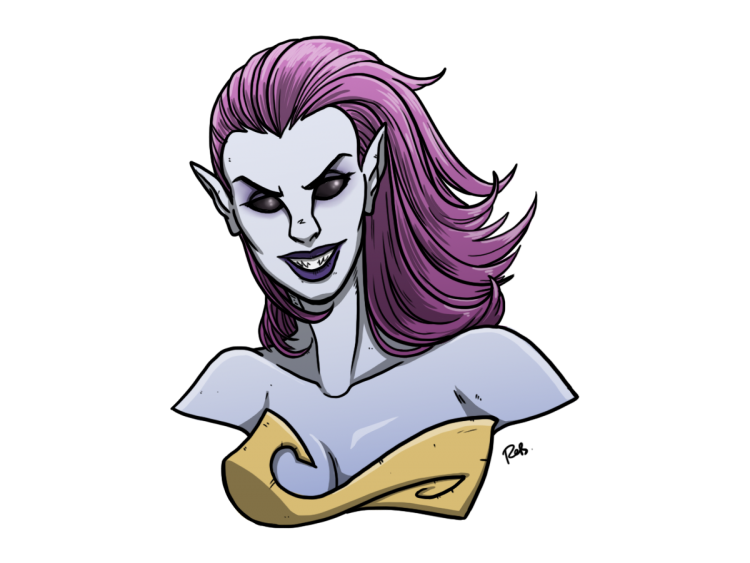
Slaanesh
- Locus of Grace (1 CP) – Used at the start of a Fight phase to give a SLAANESH DAEMON CHARACTER from your army an aura that gives all SLAANESH DAEMON units within 6” of that character the ability to make an additional attack each time they roll a to wound roll of a 6+. This can be a big boost on a large unit of Daemonettes, or it can help Slaanesh Warp Talons coming in with an absolute ton of attacks. B-
- Aura of Acquiescence (1 CP) – Use at the start of the Fight phase. Pick a Slaanesh Daemons unit in your army, and units within 3” of that unit get -1 Attack (to a minimum of 1) for the rest of the phase. This is a great way to protect your units in combat against units of marine sporting a crapload of attacks, and because it’s a 3” aura, it’s can really help make large squads of Daemonettes and Seekers work, allowing them to both protect their fragile bodies and also spread out and protect other units by giving their combat opponents an extra -1 Attack. You’ll be using this almost every turn in the White Scars, Bloody Rose Sisters, Custodes, and many other matchups. A+
- Rapturous Standard (1 CP) – Used at the start of the battle to upgrade a Daemonic Icon to a Rapturous Standard. The Rapturous Standard is an Icon with the normal ability and once per battle you can activate it before the bearer’s unit fights to give the unit the ability to re-roll all failed hit rolls until the end of the phase. It’s no 3D6” charge, but it’s a very fine ability to have, and will benefit you more on larger squads. B
- Razor-Sharp Caress (1 CP) – Used in the Fight phase to improve the AP of melee weapons for models in a unit of DAEMONETTE INFANTRY by 1 for the phase. This gives them a -2 by default and a -5 when they roll a 6+ to wound. That’s a massive boost and goes a long way toward making Daemonettes pretty nasty. It’s decent whether you’re doing squads of 10 or 30. A
- Sinuous Undulation (1 CP) – Used in the Opponent’s Shooting phase when a DAEMONETTE CAVALRY unit is picked as the target for an attack. Until the end of the phase, incoming attacks get -1 to hit. This is OK, though not nearly as good in the post-9th edition world where to hit modifiers cap at -1. Would be more useful if Seekers were better but it’s great for protecting your Contorted Epitome. B
- Song of Discordant Despair (1 CP) – Use at the start of the Morale phase. Pick an enemy unit within 6” of a FIENDS unit and that unit gets -2 to its Ld until the end of the phase. This one is much more useful than your average Ld modifier, in part because units within 12” of Fiends already get -1 to their Ld. Dropping -3 on a unit is pretty nasty, and you can wait for an opportune moment to do it and either force your opponent to spend 2 CP or lose some models. The downside is that there’s always a 1 in 6 chance this does nothing. A
- Flensing Impact (1 CP) – Used in the Fight phase. Pick a Daemonette Chariot unit in your army that made a charge this turn and until the end of the phase, when they make an attack an unmodified hit roll of 6 scores an additional hit. Slaanesh Chariots just aren’t good enough to field before this and they don’t really have enough attacks to make this worth it – on average you’re going to see 1-2 extra hits from this, and the weapons generating those hits are mostly 1 damage weapons. C+
Mike P: Sinuous Undulation is great for protecting your Contorted Epitome (which is, surprisingly, Cavalry) from sniper fire. Between access to this stratagem and the 2+ save against Mortal Wounds, the Contorted Epitome survives sniper fire very well and serves as a great caddy for the Forbidden Gem relic.
Exalted Keeper of Secrets (1 CP)
This Stratagem is used to make a Keeper of Secrets Exalted. You can choose one of the following upgrades during army construction or roll for two before the battle begins, re-rolling if you get duplicates:
- Realm-Racer: Add 2” to this model’s Move characteristic and 1 to its Advance and charge rolls. This is a big boost that can help Keeper of Secrets rush across the battlefield and make turn 1 charges. With a 14” move, this gives them an average threat radius of 38.5” in a Slaanesh detachment where they can advance and charge. A
- Quicksilver Reflexes: This model has a 4+ invulnerable save. This is wonderful for protecting your greater daemons both from firepower on the approach and while in combat, improving their longevity significantly. A
- Blessing of the Dark Prince: When resolving an attack made with a ranged weapon against this model, subtract 1 from the wound roll. Another great way to boost your durability, and wound modifiers aren’t that common in 40k. It’s also great because it improves your durability to Overwatch. The massive volumes of bolter or flamer shots that armies like Ultramarines or Salamanders can throw out in Overwatch also get their damage output halved with the -1 to Wound. A
- Lightning Flayer: When resolving an attack made by a melee weapon by this model, an unmodified hit roll of 6 causes 1 additional hit. This is probably the worst of the list, and it’s still good for an extra 1-3 hits per combat, which isn’t too bad. B-
- Fear-Seeker: Once per Morale phase, after an enemy unit fails a Morale test but before any models flee, this model can move as if it were your Movement phase (i.e. make a Normal Move, per the Core Rules FAQ) so long as it ends up closer to the unit that failed the test. In addition, each time an enemy model flees from a unit while it is within 6” of this model, it regains 1 lost wound. This can be deceptively good, giving you a free extra move if you aren’t in combat toward an enemy unit, which will then lose at least one model and regain you a wound (and you may get more if they fail Attrition tests). This combos well with Fiends and the Song of Discordant Despair Stratagem. B-
- Battle Rapture: This model can perform a Heroic Intervention if there are any enemy units within 6” at the end of the charge phase and can move up to 6” instead of 3” when it does so. Also it consolidates D3+3”. This is also very good, but harder to make use of if you aren’t familiar with combat movement in 40k. The combination of a larger Heroic Range + fight first is huge, and this ability essentially lets you treat the Fight phase like a kind of second Movement phase. A-
This is a great list of Exalted traits. Each of these is useful, and while you will generally want to pick Quicksilver Reflexes followed by Blessing of the Dark Prince as your first and second picks for your Keepers of Secrets, rolling for two traits for the KoS is more than reasonable, and many lists that take three Keepers opt to either give one Reflexes, another Blessing, and roll for the third, or just roll for all three. There really is no way to go wrong with multiple Exalted Keepers of Secrets!
Mike P: Quicksilver Reflexes and Blessing of the Dark Prince are both really strong, so which is better really comes down to personal preference and a meta call. Blessing Of The Dark Prince is my main preference because it makes the main counter to invulns (and danger in Overwatch), high volumes of mid-strength firepower, half as effective if they go from 5+ to 6+ to Wound. It also counters things like Wrath of Mars or snipers which do Mortal Wounds on modifiable 6+ to Wound. Fear-Seeker is just so matchup dependent. It can occasionally produce a great play, but in many matchups like Custodes, Marines, or Orks it will almost never come into play when it matters.
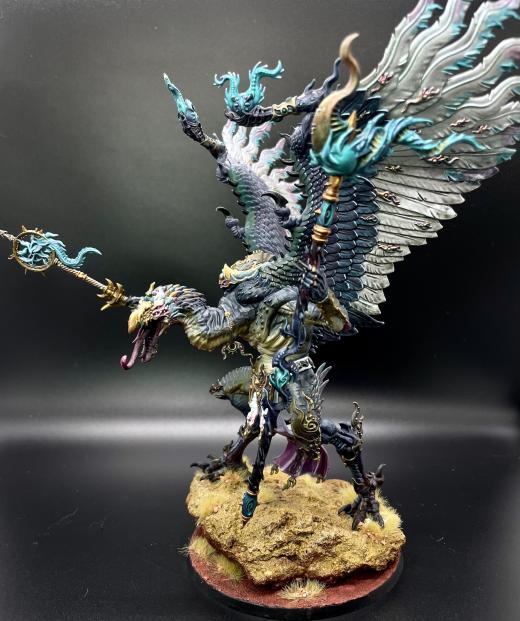
Warlord Traits
Chaos Daemons’ warlord traits are split across the four Chaos Gods, so a given Chaos Character will have access to six traits that correspond to the god they are dedicated to. For the most part, these traits are pretty good, though you don’t have any way to get more than one and typically your warlord will either be a Lord of Change or Keeper of Secrets if you’re monofaction daemons.
Khorne
- Aspect of Death – Each time an enemy model fails a Morale test within 8” of your warlord, they lose an additional model. This doesn’t matter against big hordes and high-value targets probably won’t fail morale tests. D
- Glory of Battle – Add 1 to your Warlord’s Attacks characteristic whilst there are more enemy models within 8” than friendly models. A very situational way to get +1 Attack. C
- Oblivious to Pain – Roll a die each time your Warlord loses a wound. On a 6, they don’t lose the wound and you can re-roll failed hit and wound rolls for your warlord until the end of your next turn. This one’s OK for boosting the survivability of a Bloodthirster warlord and getting yourself some re-rolls isn’t too bad, either. B
- Immense Power – Add 1 to your Warlord’s Strength characteristic. Helpful on a few specific Khorne characters, where you can get to S16 on a Bloodthirster of Insensate Rage’s cleave attacks or get to S9 on a Daemon Prince’s Talons. C+
- Devastating Blow – Every time your Warlord fights, it can trade all its attacks for a single attack that does D3 mortal wounds. This will rarely be more efficient than just throwing out the 7 to 13 attacks you’ve carefully engineered to happen. D-
- Rage Incarnate – Re-roll hit rolls of 1 for friendly KHORNE DAEMON units that charged this turn and are within 8” of your Warlord when they fight. This ability doesn’t do much for Daemon Princes but it’s great on a Bloodmaster paired with a large blob of Bloodletters and solid on a Bloodthirster, who lacks a re-rolls aura. B
Tzeentch
- Boon of Sorcery – Add 1 to the result of the first Psychic test made for your Warlord in each psychic phase. Having +1 to cast is always useful, but what you’ll typically find is that Tzeentch Daemons don’t need the bonus to cast all that often. B
- Incorporeal Form – Reduce all damage inflicted on your Warlord by 1 (to a minimum of 1). This is absolutely money on an Exalted Lord of Change, combining with the Impossible Robe and Aura of Mutability to create a monster that is depressingly difficult to kill. In most competitive armies, this is your Warlord Trait. A+
- Warp Tether – Re-roll failed morale tests for friendly Tzeentch Daemon units within 9″. A longer range than these abilities normally have, and potentially useful when you’re fishing for a Reality Blinks result, but not good enough to make it worth taking over the other options. C-
- Lorekeeper of Tzeentch – Add 6″ to the range of the first psychic power your Warlord manifests each psychic phase. Another boost to only your first power, which is an odd restriction to force. This isn’t as good as the +1 to cast, particularly given that many of the Tzeentch powers have Warp Charge 8. it’s otherwise useful on Bolt of Change, but even there you’ve got 18″ to work with, typically on models with lots of Movement. C
- Tyrant of the Warp – Roll a D6 each time your Warlord suffers a Perils of the warp; on a 2+ they don’t Perils. This just isn’t very good. You won’t perils enough in an average game to make this worth it, and most of the time a CP re-roll will get you out of trouble without costing you a Warlord trait. This could have been “you can’t Perils” and it might have been a bit more worth considering, but the fact that you can still perils on a 1 makes it pretty pointless. D
- Daemonspark – Re-roll wound rolls of 1 in the Shooting phase for friendly Tzeentch Daemon units within 9″ of your Warlord. Tzeentch shooting isn’t entirely amazing, but a bonus to Wound is a big deal and it combines with the Flickering Flames psychic power to boost daemonic shooting, even for Pink Horrors, to respectable levels. If you could take a second trait, this might be worth looking at. B
Slaanesh
- Celerity of Slaanesh – Add 3″ to your Warlord’s Movement. This is pretty solid on an Exalted Keeper of Secrets (and would be on a Winged Daemon Prince if they weren’t overcosted), where suddenly the jump to 17″ of Movement combines with the ability to Advance and Charge and smaller table sizes to make turn 1 charges a near inevitability (average threat range: 27.5”). If you’re running triple Keepers, this is your go-to Warlord Trait. A
- Quicksilver Duellist – Re-roll failed hit and wound rolls against Characters in the Fight phase. Shalaxi Helbane has to take this. It’s OK but narrow, and both Shalaxi and Keepers of Secrets already re-roll wound rolls of 1 and hit on a 2+, making it less important to take. Helps against a lot of specific things like the Silent King, but often by the time your Keepers of Secrets are in combat with Characters the game is already decided. B-
- The Murderdance – Gives your Warlord +D3 Attacks on the charge. Has a cool name, and is great for winning decisively, which you’ll want to do most of the time. This would be great on Syll’Esske, but they have to take Bewitching Aura instead. B
- Fatal Caress – Each time you make a wound roll of a 6+ for this Warlord in the Fight phase, the target takes a mortal wound in addition to any other damage. This is a nice add-on ability to have for units like Daemon Princes with Malefic Talons and Keepers of Secrets who can throw out a large number of attacks. The only problem is that Slaanesh daemons don’t really have many ways to break this and improve their wound chances. C
- Savage Hedonist – Add 1 to your Warlord’s Attacks characteristic. Not particularly flashy or bad, but not particularly good, either. C
- Bewitching Aura – Non-Vehicle enemy models get -1 Attack while they are within 6” of your Warlord. Really wish that Vehicle clause wasn’t there, because taking away an attack from a Dreadnought or other melee vehicle could be very helpful. As-is, it’s a solid defensive boost and being a 6” aura means it can help nearby friendly units. Syll’Esske has to take this trait, and it’s a decent one to have. Note that you can stack this with the stratagem Aura of Acquiescence to to give enemies -2 Attacks, which can completely neuter the output of units like Bloody Rose Repentia that might otherwise cut down your Keepers of Secrets with ease. A
Nurgle
- Blessed with Corpulence – Your Warlord gets +1 Wound. This is just kind of whatever. It’s OK on a smaller character or Daemon Prince, but near-meaningless on a Great Unclean One, where even with the extra boost from Disgustingly Resilient, adding 1 wound onto 18 doesn’t do all that much for you. C+
- Acidic Ichor – Each time your Warlord loses a wound in the Fight phase, roll a D6. On a 4+ the unit that inflicted the wound takes a mortal wound. This is a solid upgrade that’s great for improving your Warlord’s damage output in melee and really punishing enemy units for having the nerve to inflict damage on him. B
- Plaguefly Hive – Your opponent must subtract 1 from all hit rolls when targeting your warlord if the unit making the attack is within 7″. This is a better way to increase your Warlord’s longevity than +1 wound, making him harder to hit in melee combat. Unfortunately, it no longer combines with Miasma of Pestilence. On the whole, this doesn’t really help solve the problem of your Great Unclean One being shot off the table. C+
- Virulent Touch – Add 1 to Wound Rolls for your Warlord in the Fight phase unless it’s targeting a Vehicle. This one isn’t particularly useful, given that you can get both GUOs and Daemon Princes to S8 attacks pretty easily with the support of a herald, at which point you’re wounding most infantry on 2+ and also probably re-rolling failed saves. Where you really need this is for taking down vehicle targets – the one place it doesn’t work. C-
- Impenetrable Hide – Your Warlord has a Save characteristic of 4+. This might have been vaguely useful in the days before Combat Doctrines, but now there’s so much AP-1 and AP-2 shooting out there that you’ll be taking your 5+ invulnerable save all the time anyways. This needed to be a 3+ or 2+ to really create value. C-
- Pestilent Miasma – At the start of your turns, roll a D6 for each enemy unit within 1″ of your Warlord. On a 4+, that unit suffers a mortal wound. While on the surface this seems like it has more potential for mortal wounds than Acidic Ichor, Acidic Ichor is easier to make work and creates a disincentive for hitting your Warlord, which this one doesn’t do. C-
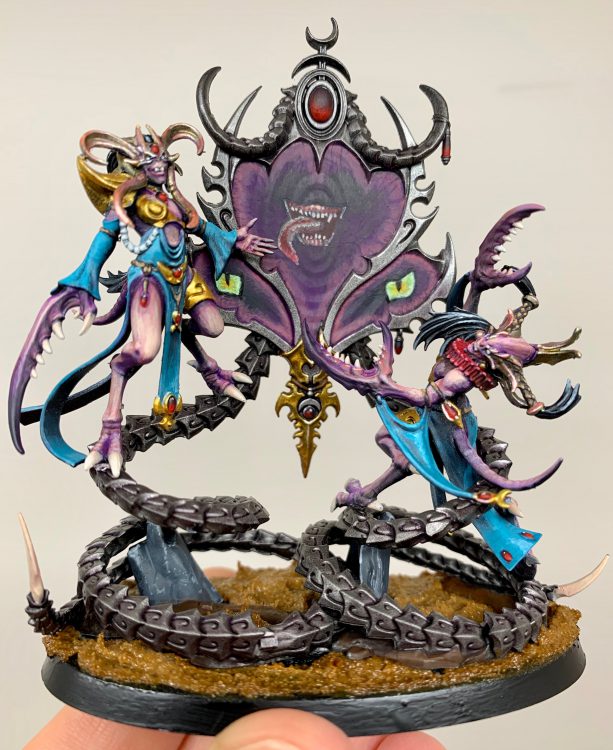
Psychic Powers
Every Chaos god save Khorne (who is not about all that magic stuff) gets a set of six psychic powers to work with. These disciplines are pretty good, and each one has some good powers worth using.
Disipline of Tzeentch
For the “Great Sorcerer,” Tzeentch got kind of shafted on powers in Codex: Chaos Daemons. The Discipline of Tzeentch has some OK powers, but most of them are just more ways to throw out mortal wounds. That’s OK though, since they can give you a nasty targeted punch and help make up for your army’s lack of shooting, softening up targets on objectives before you move in. The biggest downside is that they tend to have pretty high Warp Charge costs, but the Lord of Change’s built-in bonus to cast will help mitigate those.
- Boon of Change (WC 7). Pick a friendly TZEENTCH DAEMON unit within 18” and roll a D3 to determine what bonus that unit gets until your next psychic phase. 1 is +1 Attack, 2 is +1 Strength, 3 is +1 Toughness. These bonuses are all pretty decent, but still disparate enough that you won’t want to use this most of the time. You mostly want this if you’re taking a large unit of Horrors, Screamers, or Lord of Change with the relic Warpfire Blade. C+
- Bolt of Change (WC 8). Pick a visible enemy unit within 18”. It takes D3 mortal wounds. If you kill a character with this, you can add a Chaos Spawn to your army. The Spawn costs you reinforcement points, so be mindful of that potential bonus – Spawn can be a hilarious distraction unit in 9th edition. That said, the Spawn gimmick means this spell is clearly overcosted for a simple targeted Smite in lists that don’t leave points for the potential Spawn, but you don’t have many other options for targeted mortal wounds. B-
- Gaze of Fate (WC 6). You can re-roll a single die later during your turn. This is deceptively good, basically trading a single power for a CP. Very useful for smoothing out key rolls, and helping you avoid bad rolls when you’ve spent all your CP on other things. You should be casting this every turn at the start of your Psychic Phase. A
- Treason of Tzeentch (WC 8). Pick a visible enemy character within 18” and roll 2D6. If you roll over their Leadership, you can treat the model as if it were friendly in your Shooting, Charge, and Fight phases. At the end of the Fight phase, it goes back to normal. This is a very powerful effect, but with few ways to modify the Ld roll, it can be difficult to make this work, even after you’ve cast it. So it’s an A+ effect with a D- cost/reliability. C+
- Flickering Flames (WC 5). Pick a friendly TZEENTCH DAEMON within 18”. Until your next psychic phase, add 1 to wound rolls made for that unit’s shooting weapons. This is OK for Chaos Daemons, where you’ll use it to buff large units of Pink Horrors. It’s got some extra utility when you’ve allied in Thousand Sons and Chaos Space Marines where you can use it to boost Daemon Engines like the Heldrake, Defiler, or a Forgefiend. B+
- Infernal Gateway (WC 8). Pick the nearest visible enemy model within 12”. That model’s unit, and every unit (friend or foe) within 3” of that model suffers D3 mortal wounds. If you manifest this power with a roll of 12+, those units take D6 moral wounds instead. This is potentially a large effect, albeit one that can be a bit difficult. It’s also hard to cast, which combined with the need to put some range on it means it’s only really an option for the Lord of Change. That said, this is so spectacularly deadly when it works that it’s going to go on your invincible Lord of Change 100% of the time and is one of the reasons the LoC is so scary in 9th edition. A
Discipline of Nurgle
The Nurgle powers have a great mix of buffs and damage-dealing spells, and they’re all pretty easy to cast. Nurgle’s discipline has some of the best powers for cross-faction synergy.
- Stream of Corruption (WC 5). The closest visible enemy within 7″ of the psyker takes D3 mortal wounds, or D6 if the unit has 10+ models. The range on this stinks, but it’s a solid replacement for Smite when you’re in close. C+
- Fleshy Abundance (WC 5). Pick a friendly Nurgle Daemon unit within 18″ and one model in it regains D3 wounds. Helpful for healing up Exalted Great Unclean Ones or, in a soup list, fixing up Daemon Engines. It’s also one of the only ways to heal Mortarion. B+
- Nurgle’s Rot (WC 7). Roll a D6 for every non-Nurgle unit within 7″ of the psyker. On a 4+, the unit takes D3 mortal wounds. This is another power with short range, but it can be devastatingly powerful with enough units around you, especially if you’re near a bunch of characters and other single model units. Doesn’t work in practice as often as you would hope. C+
- Shrivelling Pox (WC 6) – Pick a visible enemy unit within 18″. Until your next psychic phase, subtract 1 from its Toughness characteristic. This is a nasty debuff that can really hurt a unit if you can drop its toughness below a specific threshold. Any Death Guard player will tell you this is very useful. Especially useless in Undivided lists, where you can get Bloodletters near a Herald wounding Dreadnoughts on a 4+ or Daemonettes near a Herald wounding Intercessors on a 3+ B
- Virulent Blessing (WC 7) – Pick a friendly Nurgle Daemon unit within 18″. Add 1 to wound rolls made for that unit in the Fight phase, and wound rolls of 7+ do double damage. This is pretty nice on large units of Plaguebearers or Beasts of Nurgle, even if it doesn’t combo with Acidic Slobber. A little worse in 9th since wound roll modifiers are capped at +1 and it no longer combos with Veterans Of The Long War on Possessed. B+
- Miasma of Pestilence (WC 6). Pick a friendly Nurgle Daemon unit within 18″. Until your next psychic phase, enemy units attacking that unit get -1 to hit. This is a very useful power, all the time. It’s easy to cast and a great way to protect key units. Works in shooting and in melee. A
Discipline of Slaanesh
Slaanesh Daemons get access to 6 psychic powers, one of which (Delightful Agonies) shares a name with the Chaos Space Marines’ Slaanesh power, though each has different rules (they still count as being the same power for the purposes of the Psychic Focus rule). These powers are all pretty good! Even Phantasmagoria, which would normally be a marginal effect at best, has real value on a Contorted Epitome. Because Slaanesh lists tend to end up with 2-4 Keepers of Secrets, you’re likely to end up with all of these in your list anyways. Symphony of Pain is your go-to here for a Keeper of Secrets most of the time, alongside Delightful Agonies to make your models as unkillable as possible. It may even be worth your while to double up on this pair of powers if you’ve got other psykers who can cast Hysterical Frenzy (which you’ll also want 1-2 models to have).
- Cacophonic Choir (WC 6) – Roll 2D6 and add 2 if your test result was 10+. The closest visible enemy unit within 18” takes one mortal wound for each point this exceeds their highest Leadership value by. We covered the probability of getting out mortal wounds with this power in our Diet Smite Hammer of Math series, and it just doesn’t stack up as a power, even with boosts. You’ll seldom be so loaded up with powers in a Slaanesh Daemons list that you want this over a 2nd or 3rd Smite attempt. D
- Symphony of Pain (WC 6) – The nearest visible enemy unit within 18” gets -1 to all hit rolls until your next Psychic phase. A very solid power, and while the nearest clause isn’t amazing, you can work around it thanks to the visibility restriction. Giving a unit -1 to hit is always useful and at WC 6, you’ll get this off most of the time. A-
- Hysterical Frenzy (WC 8) – Pick a friendly SLAANESH DAEMON unit within 18” that is within 1” of an enemy unit. That unit can fight as though it were the Fight phase. This power is incredibly good, giving you a free additional Fight phase that occurs before the Charge phase, allowing you to clear your way for another charge or just get in an extra round of damage before your opponent has a chance to hit you again. The only downsides are the need to have a unit in combat and the WC 8 cost, but the Contorted Epitome can help make this a more reliable cast. B+
- Delightful Agonies (WC 5) – Pick a friendly SLAANESH DAEMON unit within 18” of the Psyker. Until your next Psychic phase, roll a D6 each time they take a wound and, on a 6, they don’t lose it. A strong buff, though easier to cast (WC 5 vs 6) and less powerful (ignore wounds on a 6+ instead of a 5+) than the CSM version. Still worth taking and very easy to cast. B+
- Pavane of Slaanesh (WC 6) – Pick a visible enemy within 18” and roll a D6 for each model in the unit. That unit takes a mortal wound for each 6 you roll. This is going to do work against units of 15+ models. Take it if you think you’ll be up against those often, otherwise leave it. B-
- Phantasmagoria (WC 6) – Enemy units subtract 1 from their Ld while they are within 12” of your Psyker until your next Psychic phase. This is bad on most casters but very good on the Contorted Epitome, where it makes the Horrible Fascination ability that much more potent. Making it a 12” aura helps a lot here. A (Contorted Epitome) / D (Everything else).
Mike P: Hysterical Frenzy plays right into the Slaanesh playstyle of trapping units in combat. If you’re still in combat in your turn, use Hysterical Frenzy to fight your way out and charge something else in your Charge Phase. Phantasmagoria also is key for helping your Forbidden Gem roll succeed, and fits best on whichever model you have carrying the Forbidden Gem. Pavane of Slaanesh really helps turn the (silver) tide against Necrons, as softening up blobs of 20 Warriors with 3-4 Mortal Wounds and a few Smites makes it much easier to finish them off in one-shot later.

The Power Ratings Update
Early in 9th edition, Games Workshop released a Power Ratings update that set new Power ratings for every unit in the game. Generally Power Ratings are thought of as narrative tools, they’re very important for Chaos Daemons, who depend on them for some rules, such as the Denizens of the Warp Stratagem and summoning with Daemonic Ritual. These values were further tweaked in the January 2021 Power Rating update. As such, it’s worth noting the following Power Rating shifts that have been made in these updates and where they matter. The big thresholds we’re worried about here are at the 8 PL to 9 PL jump, where Denizens starts costing 2 CP, and anything that drops a bigger daemon’s PL lower and closer to 10.5, the average roll on 3D6. There’s also a mythical threshold at 9 PL, where a unit (or collection of units) is cheaper to put in Strategic Reserves than in the Warp, but there are only a couple of units for which that’s the case.
Khorne
- Bloodthirsters dropped substantially – the Wrath of Khorne Bloodthirster is now only PL 12, while the Unfettered Fury is 13 and the Insensate Rage is 14. This drop from 17 makes Bloodthirsters much, much easier to summon, though you’ll now face the challenge of getting off a successful charge with them the turn they arrive. Skarbrand dropped by 2, making him easier to summon but still so difficult that you probably wouldn’t bother unless you had 4 dice or a re-roll going.
Nurgle
- Plaguebearers got completely hosed by the PL updates, and are 5 PL base, and 10/15 as the unit increases in size. This means that a squad of 20 costs 2 CP to put into reserves with Denizens or to outflank with Strategic Reserves, so you’ll still end up using Denizens to get them anywhere deep on the table, which doesn’t keep upscaling on cost.
- The Great Unclean One dropped to PL 14, making it substantially easier to summon one of these big lads, and the same thing happened to Rotigus. Our boy Epidemius went up by 1, so you’ll definitely be throwing 3 dice to summon him to make sure he comes out.
- Beasts of Nurgle held firm, so if you’re planning an army that revolves around summoning a bunch of them mid-table, you’re still good to go.
- Plague Drones were updated to be PL 5 / 10 / 15, down from their codex cost. They’re an interesting option for Strategic Reserves but having a 10” move and some solid resilience means you’re more likely to keep them on the table.
Tzeentch
- The Lord of Change is now PL 14, making them substantially easier to summon, while Kairos Fateweaver dropped by 5, making it possible to summon him now on 3D6 with no modifiers.
- Flamers and Screamers both dropped by 1 PL each, making them trivially easy to summon a base unit on 2D6 and potentially worth looking at a larger unit size on 3D6.
Slaanesh
- The Keeper of Secrets went up to 12 PL (from 11) and Shalaxi Helbane went up to 13 PL, making them a little more difficult to summon. Syll’Esske went up by 1 PL as well.
- Most importantly, the Contorted Epitome went up from 10 PL to 11, making it a bit less likely you’ll summon one on a standard roll of 3D6. It’s not devastating, but it’s something to keep in mind if that was part of your strategy (the average roll on 3D6 is 10.5).
- Daemonettes and Fiends held pat, while Seekers went up by 1. All three Herald options from Engine War went up by 1, though the Infernal Entrapturess stayed put.
Undivided
- Soul Grinders’ PL went down by 3 to 9, making them reliably easy to summon on a 3D6 roll and making them one of the rare units that you’ll want to put into Strategic Reserves instead of the Warp, since doing so with 1 will cost you 1 CP.
- Furies dropped by 1 PL.
- Daemon Princes still cost 8 PL, but now adding Wings will give them +2 PL instead of the +1 listed in the codex, making them the single unit in the army that had 9 PL in some configuration and would have been cheaper to put in Strategic Reserves rather than Denizens. Now you’ll want to use Denizens instead since they both cost 2 CP for a Winged Daemon Prince, if you’re going that route. You shouldn’t though, because a winged daemon prince can hide from danger using the Look Out, Sir rule.
The Units
For each class of units in the Chaos Daemons codex, there’s typically at least one unit choice for each of the four gods, though there are a few extra unaligned daemon choices available to players. Because each god has multiple heralds and greater daemon builds, there are more HQ options for Chaos Daemons than any other slot.
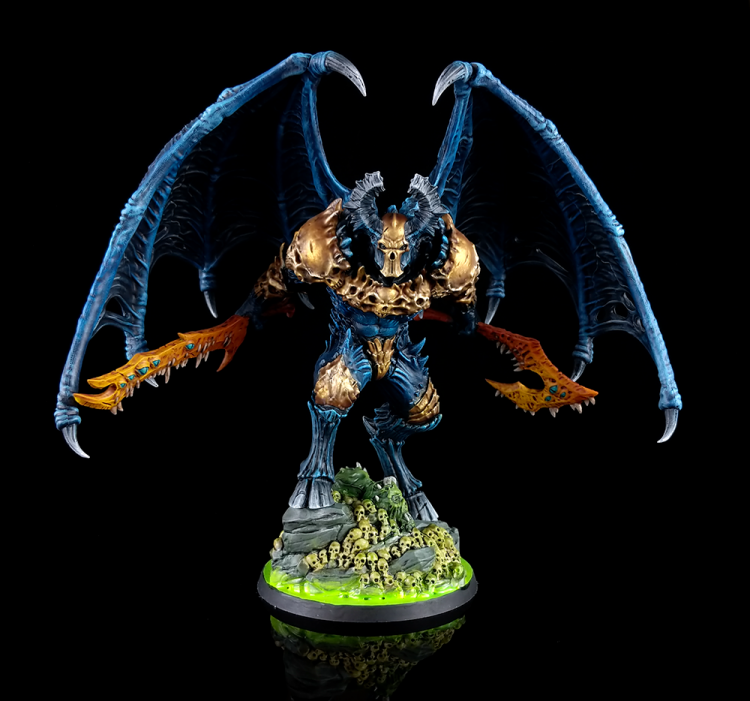
HQ: Daemon Prince of Chaos
Formerly the core HQ choice in the Chaos Daemons army, Daemon Princes were some of the big casualties of the 9th edition points update, where they got a massive points hike because Games Workshop felt they needed to cost the same as their Heretic Astartes counterparts despite having worse saves, wargear, stratagems, auras, and warlord traits. These days only the Death Guard and Thousand Sons Daemon Princes are worth fielding, since they essentially stayed the same cost going from 8th to 9th. Now they’ve been eclipsed by the greater daemons as HQ choices.
Despite this, Daemon Princes are still OK, just massively overcosted. They’re fast, tough, they can dish out in melee combat, they’re psykers, and they have fewer than 10 wounds, so you can easily protect them with infantry until you need them to plow forward and destroy something.
Weapons-wise, you will generally want to give your daemon prince a pair of malefic talons, in order to max out the number of attacks they get, or give them a sword + talon to keep them as cheap as possible now that the sword is free, unless there is a specific piece of wargear like Skullreaver that you plan to give them.
HQ: Greater Daemons
Each Chaos God has a greater daemon that essentially acts as the largest, most impressive daemon in that god’s arsenal (though there’s a special character variant of each as well, and those are generally stronger). Greater Daemons look fantastic on the table and thanks to the Exalted Greater Daemon stratagems in Engine War, are all pretty nasty. The Lord of Change and Keepers of Secrets are the most viable, though there are lists that have been successful running the Great Unclean One. The poor Bloodthirster hasn’t quite gotten there, but has shown up in lists that have been successful at the RTT level.
Note that we’ll be talking in each section about Exalted Greater Daemon variants. You should basically always be using the stratagems to exalt your greater daemons. Do not take un-exalted greater daemons.
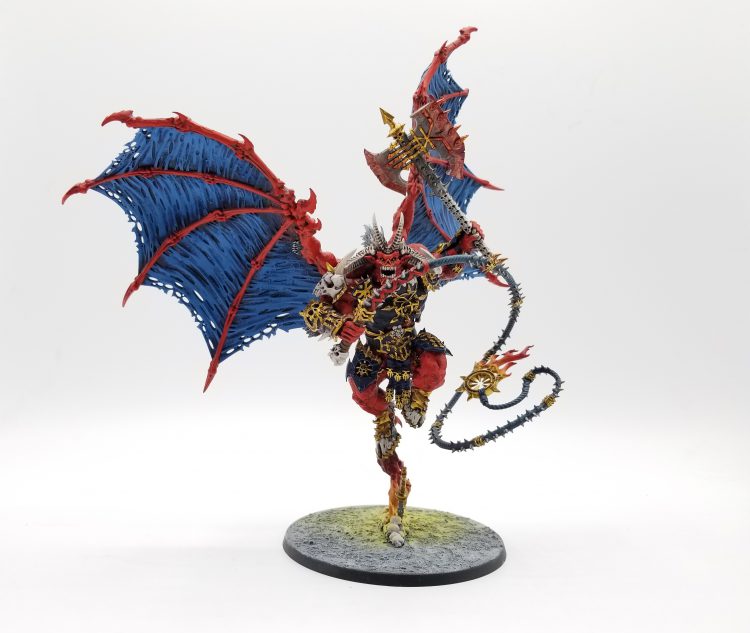
Bloodthirster
Oh you poor, rage-filled children. Bloodthirsters have a great model and look terrifying on the table (even though they now sit somewhere on the smaller end of Greater Daemons), but they’re the worst of the four greater daemons by a considerable margin (though that doesn’t stop them from costing the same as a Keeper of Secrets). The big problem is that they lack the resilience of the other three Greater Daemons without Exalted buffs, and they’re frankly just not as terrifying as they need to be in melee – having 6 attacks (7 on the charge) isn’t really a lot, and the Sweeping blow on the Great Axe of Khorne only gives you 2 attacks per with a steep tradeoff of dropping you to 1 damage per attack.
Still, with the right Exalted bonuses, even these can edge close to respectability. There’s no reason to take any variants other than the Bloodthirster of Insensate Rage (the one with the big axe), as the ability to double your attacks against smaller targets is invaluable, especially if you end up with the +1 damage Exalted bonus. Because Bloodthirsters need the help so badly, you’re almost always going to be better off rolling for two exalted abilities on them instead of one. Your aim with the Bloodthirster should be to keep him as cheap as possible. If you do give him a relic, the Armor of Scorn is probably your best bet, though if you’re going with a non-Insensate Thirster, G’rmakht the Destroyer isn’t a bad pick. If you want to go all-out as Khorne, running three Exalted Bloodthirsters isn’t particularly competitive, but it’s not terrible either.
Insensate Rage, Wrath of Khorne, or Unfettered Fury?: Insensate Rage
Mike P: There is a real argument to be made for the Wrath of Khorne Bloodthirster compared to the Bloodthirster of Insensate Rage. It’s true that the Rage Bloodthirster has a sweep attack, but the Wrath of Khorne has 1 + d6 additional attacks from shooting which isn’t too far off. But the main issue is that the Rage Thirster has a horrifying degradation table, losing WS in addition to lost Attacks which is… not ideal when you’re an expensive melee unit. Continuing to hit on a 2+ in combat until his final wound (with an additional cheeky re-roll 1’s against Characters!) is a big mark in favor of the Wrath Thirster. There’s arguments to be made for both, and it’s close enough that sometimes I’m fine with shrugging and taking the 20 points saved by picking the Wrath variant.
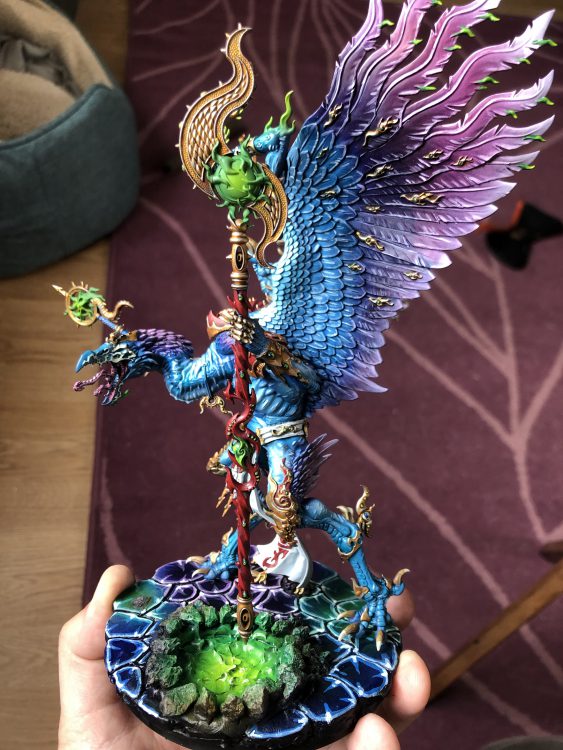
Lord of Change
With the addition of Engine War the Lord of Change has gone from “very close to playable” to “Perhaps the single most powerful unit in the game.” When you combine the defensive buffs you get from the Impossible Robe relic, the Incorporeal Form Warlord Trait, and the Aura of Mutability Exalted ability, you end up with an incredibly difficult to kill character who can zip around the board throwing mortal wounds out and take units off objectives. Both the sword and the staff are fine options for the Lord of Change, though since getting Chaos Spawn with the latter requires reinforcement points, don’t plan on ever seeing that upside – the big draws for the staff are the flat 3 damage and not taking -1 to hit, but the S7 bonus on the Sword and additional AP make it mostly a wash, even with the additional points cost. With +2 to cast at full health, the Lord of Change makes the perfect caster for Infernal Gateway. If you’re taking more than one Exalted Lord of Change, you can get away with rolling for two traits on them.
Sword, Staff, or Rod? Either Sword or Staff is fine. Skip the rod.
Psychic Powers: You’ll want Bolt of Change and Infernal Gateway most of the time for the raw targeted mortal wounds output they can do. After that Gaze of Fate and Treason of Tzeentch are both good picks depending on your meta and game plan.
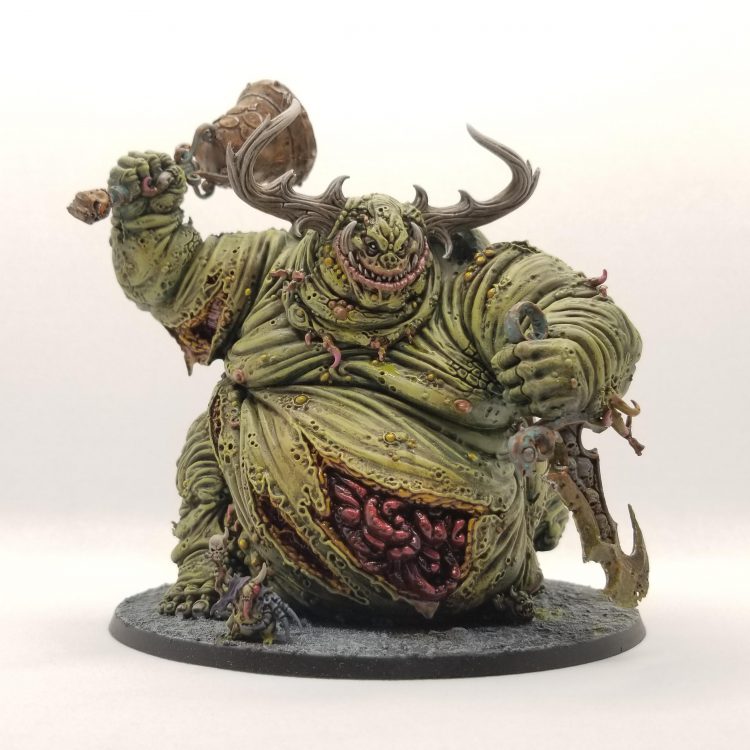
Great Unclean One
With T7, 18 Wounds, and Disgustingly Resilient, Great Unclean Ones have a strong claim to being the toughest of the Greater Daemons. Unfortunately having 18 Wounds is also a massive detriment, as it means they can be seen through Obscuring terrain, making them extremely shootable. And there’s plenty of shooting in the meta that can take one down, since everything in the game seems tuned to take down a knight-sized target (and Great Unclean Ones aren’t usually as tough as a knight).
Still, the Great Unclean One is a potent psyker, and has a few neat tricks he can pull out. The Exalted Great Unclean One can be extremely tough to take out, especially if you get lucky with the T8 and 4+++ abilities, but generally you want to just opt for Revoltingly Resilient on him to guarantee he’ll be a chore to kill. The big competitive play for the Exalted Great Unclean One is arming him with a bell and setting him up with 2-3 squads of Beasts of Nurgle or Myphitic Blight-Haulers. As multi-model units of expensive, multi-wound Daemons, the ability to bring these models back makes the Great Unclean One a potentially insane threat, able to recur hundreds of points per game. This kind of forces an opponent to deal with him first, which takes a lot of firepower and ensures it isn’t hitting your other units.
Bell or Sword? Bell.
Psychic Powers: Miasma if you don’t already have it on something else; Virulent Blessing, Shrivelling Pox, and Fleshy Abundance are all good picks.
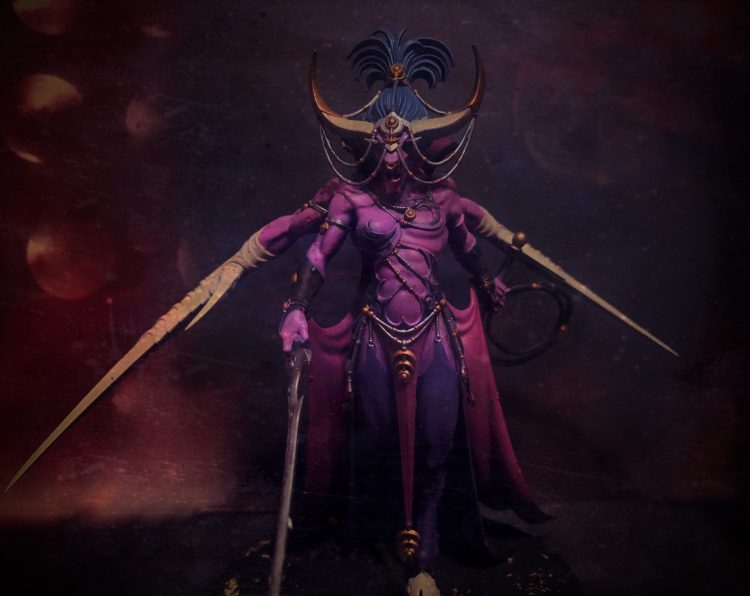
Keeper of Secrets
After being stuck with a dopey metal model and mediocre rules for the better part of three editions, Slaanesh’s greater daemons finally made a comeback in 2019, with a new model that demanded new rules. The Keeper of Secrets got a huge size boost and a profile boost to give them higher BS, more Wounds, and a higher Movement attribute, helping the KoS get into combat quicker. That’s good because the Keeper of Secrets is going to be safest when it’s locked in combat, preferably with either Fiends or a Contorted Epitome nearby to help you trap opponents in combat.
Unlike the other three Greater Daemon options, the Keeper of Secrets really needs to be in a Slaanesh-aligned detachment in order to get the Locus of Swiftness bonus, allowing them to Advance and Charge in the same turn. That’s fine because you’ll almost always want 3 to 4 Keepers of Secrets (the fourth being the named Keeper of Secrets, Shalaxi Helbane), helping you fill out those slots, and Daemonettes are pretty points-efficient.
Because a Keeper of Secrets has 16 Wounds and a degrading profile, there’s a ton of value to be had in taking the Shining Aegis on your Keepers in order to boost their survivability by giving them additional protection against incoming wounds and mortal wounds. That said, the extra damage output you get from the whip is also worth considering, and current consensus comes down to about 50/50 for the aegis vs. the whip – it’ll largely depend on what you’re up against and whether you think you need more damage or survivability. If you make one your Warlord, giving it the Celerity of Slaanesh Trait is probably the best move, since it helps guarantee a turn one charge, especially with the Locus of Swiftness active.
Exalted Keepers of Secrets are pretty great, and while there are very few bad abilities you can roll, you’ll generally want to give at least one Blessing of the Dark Prince and another Quicksilver Reflexes so you can maximize your Keepers’ survivability. If you’re going to make a Keeper your Warlord with Celerity, make it one of these – you don’t want to give Celerity to a random traits Exalted Keeper, as having Celerity and Realm-Racer on the same model is kind of a waste.
Shining Aegis, Sinistrous Hand, Living Whip, or Ritual Knife? Either the Shining Aegis or the Living Whip, depending on what you need. The Sinistrous Hand is also OK.
Psychic Powers: Typically you’re bringing 2-3 Keepers so you’ll cover the whole list but start with Delightful Agonies if you didn’t take the Aegis. Then Symphony of Pain, Phantasmagoria, and Pavane of Slaanesh are all solid choices. Hysterical Frenzy belongs more on a Contorted Epitome due to its high cast difficulty (WC 8).
Mike P: My personal favorite loadout for a Keeper of Secrets is taking the Bewitching Aura trait so you can stack it with Aura of Acquiescence for -2 Attacks and -1 to Hit for opponents in melee. This makes it an absolute terror in melee matchups to try to remove. In terms of wargear, the Aegis is great but the Whip provides an incredible amount of value too (it’s basically 6 additional attacks against a lot of common profiles like Vanguard Vets with Shields or chaff). The Shield is probably the best pick and the one most commonly seen in competitive lists, but all the options are honestly great besides the Knife.
HQ: Named Characters
Skarbrand
The special character Bloodthirster. With no ability to become Exalted and lacking FLY and the 12” Movement that other Bloodthirsters enjoy, Skarbrand has a tough uphill battle when it comes to viability. He’s not any tougher than a Bloodthirster of Insensate Rage, so the real value he’s bringing to the table is his Rage Embodied aura, which has two benefits:
- Gives all units +1 Attacks within 8” (including enemies)
- Any unit that attempts to Fall Back within 8” of Skarbrand has to roll 3D6 and if it rolls over its Ld value then it can’t Fall Back.
These abilities are more cute than legitimately powerful. The +1 Attack is strong, particularly on large units of Bloodletters (It also ensures that a full health Skarbrand has 8 Attacks on the charge, plus he scores 2 hits when he rolls 6s to hit), but you better be sure to wipe out your opponent or you’re going to feel it when they retaliate. The ability to trap units in combat is also neat, and more valuable in 9th edition where players can use the Desperate Breakout Stratagem to get out of wraps and they no longer have the ability to CP re-roll a die on the 3D6 vs. Ld roll. Still, it’s also going to fail you at a key moment at some point or another. Note that this no longer causes AIRCRAFT to crash – they just make a Normal Move to get away; they don’t have to Fall Back. There’s a bloodletter-heavy list you can build around Skarbrand that isn’t going to be top-tier competitive, but won’t be terrible, either. Just watch out for getting charged by models that get +1 Attack from your Skarbrand.
Karanak
An HQ special character Flesh Hound, whose deal is having three heads. Karanak’s got the ability to mark an enemy character at the start of the game and get +1 to hit and wound rolls against them, and he’s got 5 S6, AP-2, 2-damage attacks on the charge. His biggest asset however, is being able to attempt to deny two psychic powers per enemy psychic phase. His biggest disadvantage is that he’s the third-most useful HQ in the Khorne Daemons cupboard, and so he’ll usually get squeezed out by Exalted Bloodthirsters and a Bloodmaster. That said, his ability to deal with psychic powers can be a huge boon for a Khorne-heavy army, where powers like Death Hex or Null Zone can ruin your day. Karanak’s ability to deny two powers per turn combined with his mobility makes him a useful deterrent, and he’s not bad in combat, where throwing out 5 S6 AP-2 2 damage attacks on the charge can kill a few marines or munch up weak HQs.
Skulltaker
The special character Herald of Khorne. Comes with an extra wound, an extra attack, and a better sword, and the ability to re-roll failed hit and wound rolls against CHARACTERS. He’s also got a different aura, giving +1 to hit rolls for friendly BLOODLETTER units within 8”. This is a tasty ability, but not one that standard Bloodletters really need if they’re sitting on 20+ models and already hitting on a 2+ for Murderous Tide — ultimately they need the +1 Strength more. Where it does have value is on Bloodcrushers, who have the BLOODLETTER Keyword in their most recent datasheet (Engine War). If you’re taking them, it’s worth considering Skulltaker with them, as he’s got an extra 1” of Movement and can mostly keep up with them.
Kairos Fateweaver
The special character Lord of Change. Kairos is better at casting than the Lord of Change, with the ability to cast 3 and deny three powers each psychic phase (and he knows all of the Tzeentch powers), and a better fighter, since he doesn’t need a Rod of Sorcery to get his cast bonus and the Staff of Tomorrow has a better profile than the Staff of Tzeentch. But he’s also much more fragile, since he can’t be Exalted, nor can he be given The Impossible Robe or Incorporeal Form as a Warlord Trait (he’s stuck with Tyrant of the Warp). This means that Kairos is incredibly powerful but likely to be shot off the table on the first turn. Kairos gives you an extra D3 Command Points if he’s your warlord, but Tyrant in the Warp is a bad enough trait that you’re likely better off making something else your warlord. Kairos is neat but too expensive for how fragile he is.
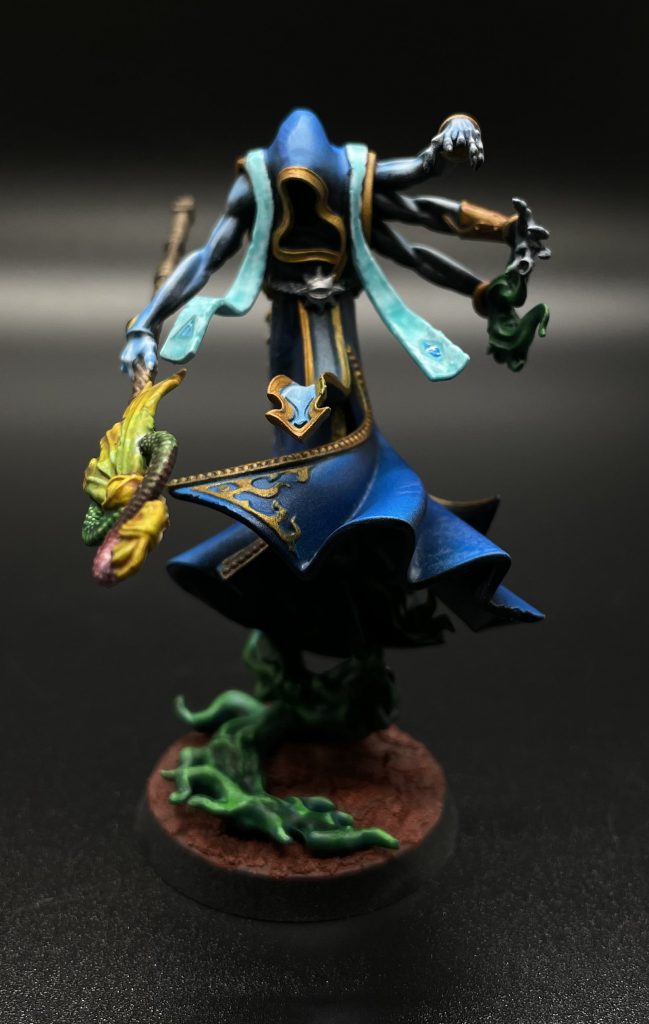
The Changeling
The special character Herald of Tzeentch, The Changeling is one of the most hilarious, well-designed units in the game and still worth consideration in Tzeentch-heavy Chaos Daemons armies. The Changeling’s core abilities are the Locus of Transmogrification, which gives Tzeentch Daemons models within 9″ (great range) the incredibly useful ability to ignore wounds on a 6+, and the ability to copy any unit and weapon within 1″ of it in the Fight phase via the Formless Horror rule and The Trickster’s Staff. In practice, this means that the Changeling has the best profile and melee weapon of any INFANTRY model within 1″ of it, making it potentially a very dangerous unit in the game when it comes to Heroic Interventions. Oh, and also the Changeling is a psyker that can cast/deny one power. That’s pretty crucial, because the Changeling also has the HORROR and INFANTRY keywords, giving it access to the Minions of Magic Stratagem, allowing it to spend 1 CP to automatically generate a 9 for its attempt to manifest a power. The Changeling has a lot to offer but his strongest ability is the Locus of Transmogrification, which makes him a great partner to large units of Horrors and Soul Grinders. He is also a great ingredient in Chaos soup, where giving units like Magnus or Daemon Engines a Feel-No-Pain provides another layer of durability.
Psychic Powers: The Changeling makes a great caster for Gaze of Fate to generate free re-rolls and also makes a great caster for attempting Psychic Actions.
The Blue Scribes
A couple of Horrors riding on a Disc of Tzeentch who aren’t technically psykers themselves, but can disrupt nearby psykers, giving enemy psykers within 12″ a -1 penalty to their tests and any time those psykers fails a test within 12″ of the Scribes, they can’t attempt to manifest it again for the rest of the battle. This is hilarious and can absolutely wreck an opponent’s day if they are relying on repeated casts of a difficult power. Additionally, the Scribes automatically manifest a random Tzeentch psychic power on every one of your turns, plus Smite if they ate a power from an enemy pysker the turn prior (these can’t be denied). Note that, per the FAQ, while they can manifest something that has already been cast or attempted, the same is not true for the rest of your army, so you ideally want to use their random cast after your other psykers to avoid locking yourself out of key casts. Sadly, the Scribes are more interesting than useful — not enough of your opponents will rely on psychic powers so heavily that the disruption matters (though it can be useful for stopping Null Zones), and the random cast is fun but not incredibly useful.
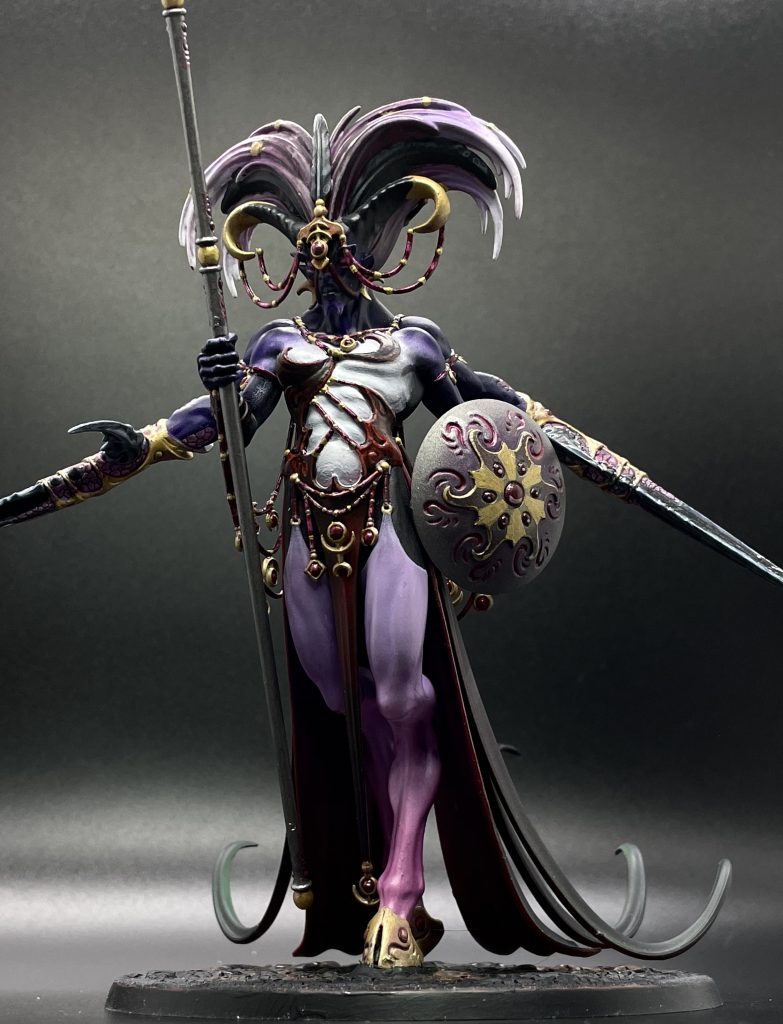
Shalaxi Helbane
The named character variant of the Keeper of Secrets, Shalaxi trades out the Keeper’s Wistealer Sword for the Soulpiercer spear, which allows it to attack at S12 AP-4 and do D6 damage, upgraded to 6 against Characters on a 6+ to Wound. This makes Shalaxi the ideal fighter for targeting Character Knights, Lords Discordant, Chaplains, and other nasty combat characters, especially when you factor in the Mesmerizing Aura it shares with Keepers of Secrets and the Cloak of Constriction, which gives incoming melee attackers -1 to Wound. Shalaxi can also move 6” when Heroically Intervening near Characters, allowing you to play some truly nasty tricks (in combination with fighting first) if opponents aren’t paying attention.
Although Shalaxi can’t be Exalted, they make a great addition to a Slaanesh-heavy army as a third or fourth Keeper of Secrets, bringing enough to the table without the Exalted bonus to be worth fielding. Unlike with the Keeper of Secrets, you’ll want to consider giving Shalaxi the Living Whip to maximize their damage output. This is mostly because the Aegis by itself isn’t enough of a survivability to boost to make up for the loss in damage output you get from keeping the whip, plus you’ve already got two or three other Keepers of Secrets taking the heat off Shalaxi. The Aegis isn’t a bad play here, but the successful competitive lists we’ve seen running Shalaxi do so with the whip.
Living Whip or Shining Aegis? – Living Whip, but either works.
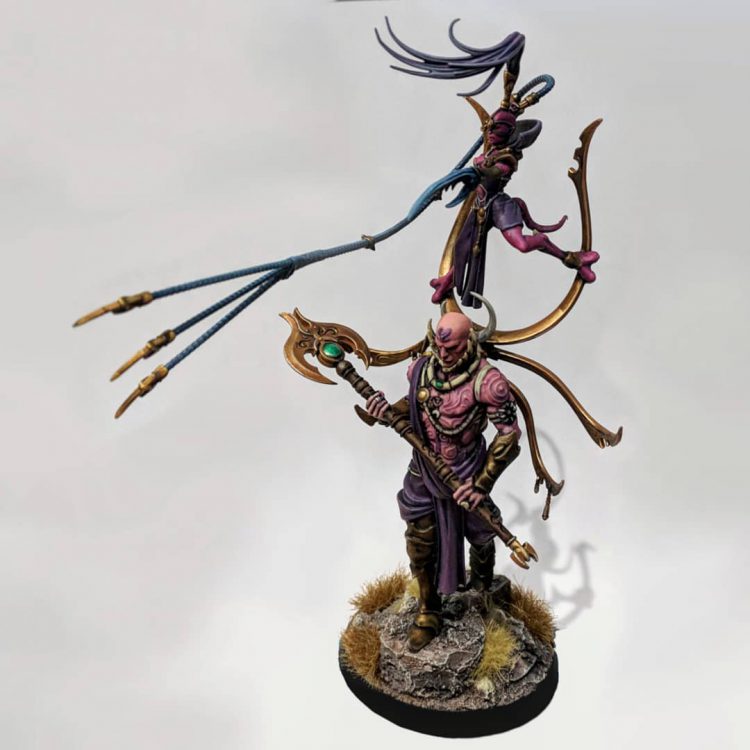
Syll’Esske
Almost literally a Herald of Slaanesh Voltron-ed with a Daemon Prince, Syll’Esske, The Vengeful Allegiance carries a similar statline to a Daemon Prince only with double the attacks, plus both the Daemon Prince and Herald aura buffs in addition to a unique morale aura buff. Though at 230 points, you’re certainly paying for those benefits. While Syll’Esske lacks wings and the FLY keyword, they do have the ability to fight twice every turn, once with each of its two weapons (the Axe of Dominion hits at S8, AP-3, 3 damage, while the Scourging Whip hits at S5, AP-1 1 damage and makes D3 hit rolls for each attack made instead of 1). This essentially gives the model a large amount of additional movement in the Fight phase, albeit with some restrictions. The lack of FLY does mean that Syll’Esske can’t jump over screens and so Syll’Esske will do better in armies where you have the ability to clear a path beforehand.
Syll’Esske’s 8W and 4+ save aren’t great, but as a character you can use the Look Out, Sir rules to protect them until you need them in combat, and then use Fiends or the Epitome to keep units locked in combat until you want to leave. Because of the volume of attacks they can throw out with the whip, Syll’Esske makes a good target for Locus of Grace.
Competitively, Syll’Esske is a solid unit and very playable in the right competitive builds – some high level lists have seen success taking them, and generally what will happen is that Syll’Esske takes the place of a Keeper of Secrets in a Daemonette-heavy Slaanesh Daemons list, where the pair of aura abilities make it more valuable than a third or fourth Keeper and having the DAEMONETTE keyword means benefitting from your other force multipliers.
The Masque of Slaanesh
The other named Herald of Slaanesh, the Masque of Slaanesh is a decent melee combatant whose primary benefit are two auras, one that makes Daemonettes harder to kill in melee by giving them -1 to be hit if they’re within 6” of the Masque and the other that lets you pick an enemy unit within 1” during the Fight phase and all attacks get +1 to hit against it. These are OK, and solid enough effects in a Daemonette-heavy army to make the Masque borderline playable at higher competitive levels, especially given its 85 points cost. It’s also a unit you’ll likely want to consider summoning so you can drop down its abilities as a surprise. The Masque combines very well with Syll’Esske, thanks to the latter having the DAEMONETTE keyword.
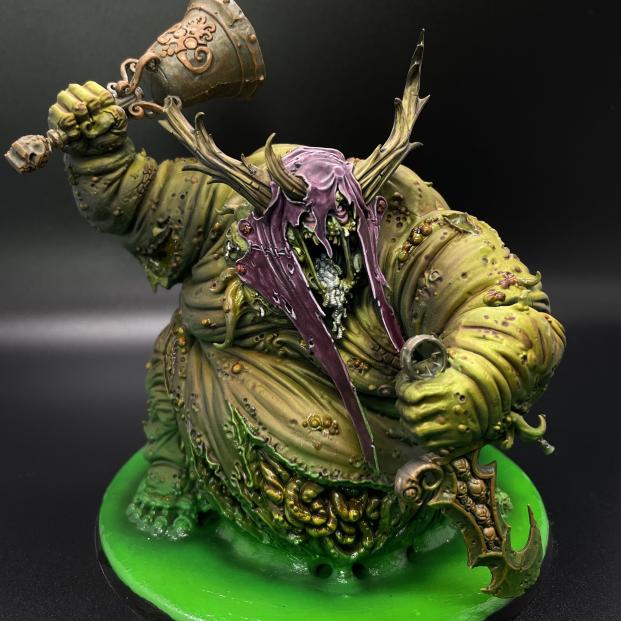
Rotigus
The special character Great Unclean One. Rotigus shares the GUO’s issues but is slightly better in melee thanks to some extra attacks from his uh, arm mouth. Unfortunately Rotigus shares the same problem as the other named greater daemons in that he can’t be exalted and his abilities aren’t good enough to make him worth taking over an exalted Great Unclean One. Rotigus has a nifty flamer-type weapon in the Streams of brackish filth, which is a Strength User AP-3 1 Damage weapon that does 2D6 auto hits within 7″ and re-rolls wound rolls. That can do some real damage in a pinch and is good for attacking flyers that get too close thinking their To Hit modifiers and inability to be charged will save them. Rotigus is also a capable caster, and can dole out extra mortal wounds when he rolls a 7 to cast. But at 270 points, he’s not an option you should be looking at for your army.
Epidemius
The special character herald for Nurgle. Tougher than a Poxbringer, and with more wounds, but without the Poxbringer’s +1 Strength aura. Instead, Epidemius counts up a tally every time a NURGLE DAEMON unit destroys an enemy unit, and as the counts go higher, you start to score better and better bonuses, gaining re-rolls to hit, improving Strength and Toughness, and Attacks. The abilities are neat because they’re army-wide and not locked to the Chaos Daemons faction, meaning that they can be pretty nasty buffs for a Nurgle Soup army packing daemon engines Defilers, Plagueburst Crawlers, and Myphitic Blight-Haulers. You lose the nifty Death Guard contagions rules if you add or summon Epidemius, but the potential tradeoff of having him give all of your daemon engines re-rolls to hit and extra Toughness is pretty big. It’s mostly a gimmick, but it’s a pretty strong one all things considered.
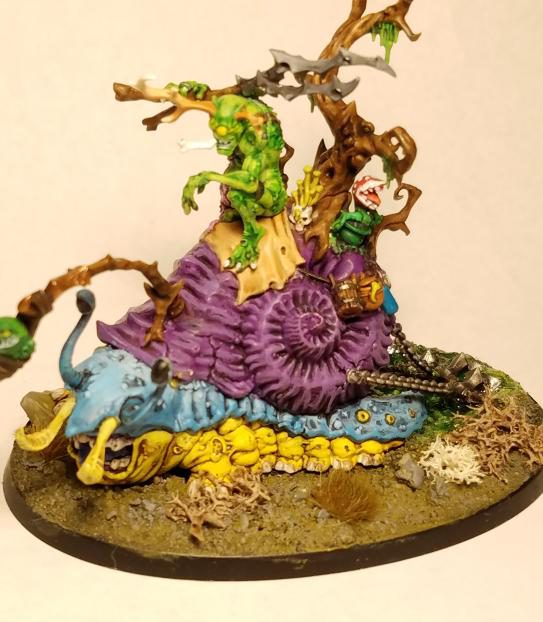
Horticulous Slimux
Another special character Herald, Horticulous’ primary abilities are being an OK melee combatant and buffing nearby Beasts of Nurgle, giving them +1 to hit within 12″ and re-rolled Charge distances within 6″ while being incredibly durable himself. While Slimux was pretty bad in 8th, Beasts of Nurgle becoming a strong unit in 9th has pushed him to be more of a borderline competitive play in the right list. And by “the right list” I mean “a list running 15+ Beasts of Nurgle.” At 160 points Slimux is a bit pricy, and is less valuable with the change to While We Stand We Fight making it tougher to select him as a candidate.
Be’lakor
The only unaligned named HQ in Codex: Chaos Daemons, Be’lakor is basically a unique Daemon Prince who comes with a very, very good sword (S+1, AP-5, 3 Damage), Wings and a 14″ movement, 6 Attacks, and the ability to cast two powers per phase (though the powers he knows come from a stripped-down version of the Dark Hereticus discipline), plus an aura that gives re-rolls on hit rolls of 1 to all friendly Daemons within 6″. He’s a little more survivable than the average Daemon Prince as well, with the ability to re-roll all failed saves, which makes his 5+ re-rolled invulnerable save slightly better than a 4+ (he’ll save about 56 percent of the time). Taken on its own, this all seems pretty good, but Be’lakor’s got three knocks against him: The first is that he can’t take a Warlord Trait from the Codex, which leaves him with the garbage one in the Core Rules. The second is that he breaks mono-God detachment rules for loci for every god. The third is that he costs 220 points when he should really be more like 185. Powers-wise, you’re pretty much always going to give him Death Hex and Infernal Gaze, which at the very least gives him a little extra utility.
Competitively, Be’lakor’s biggest value may be that he gives daemons – including Greater Daemons – of every god the ability to re-roll 1s to hit, making him a bit more useful in undivided lists and a possible fringe play.
Mike P: Be’lakor is one slight points drop away from being very good. One of the main benefits he brings to mono-Daemons armies is a second targeted Smite in the form of Infernal Gaze. Infernal Gaze combines with Bolt of Change on a Lord of Change to create a critical mass of targeted Mortal Wounds that requires your opponent to hide their squishy support Characters. His universal re-rolls make him worth consideration if you’re building a Chaos Undivided style list.
HQ: Heralds
Each god has a collection of Herald options you can take that will provide buffs to nearby Daemon units. Generally, the value of Heralds is tied to the value of a faction’s Troops and how much you need them to get Strength buffs.
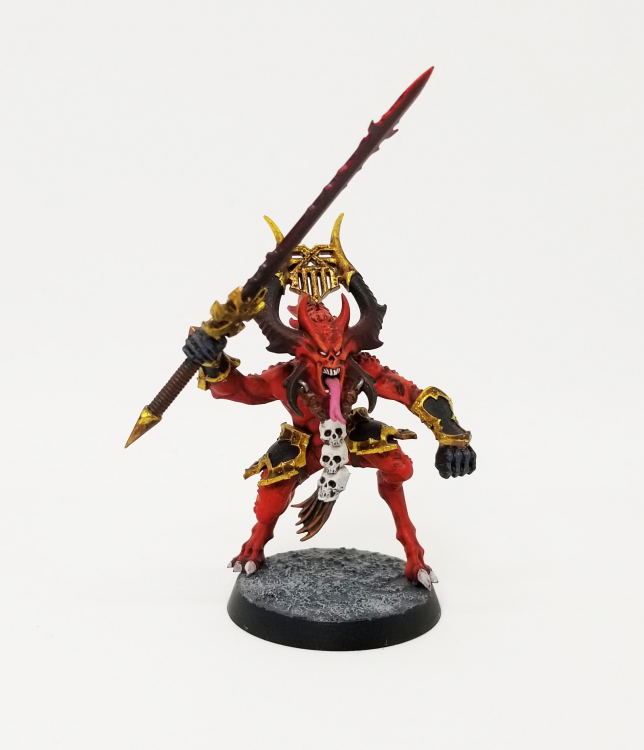
Heralds of Khorne
Heralds essentially come in three varieties: Bloodmasters, your bog-standard Heralds, Skullmasters, your Heralds on Juggernauts, and Blood Thrones, your Heralds on a Chariot. All three have the Locus of Khorne aura, which boosts nearby KHORNE DAEMONS within 6” by giving them +1 Strength. This is pretty strong and also works on Chaos Space Marine Daemon units. Unfortunately while Bloodletters still have decent play, they don’t really need Heralds and are likely to leave them behind anyways when charging from Deep Strike.
Bloodmasters
By far the most useful of the three herald varieties, clocking in as the cheapest HQ you can take for a Khorne army. Their Locus of Khorne aura is very useful for buffing Bloodletter bombs and their upgraded swords are great. Note that on the charge, these guys are S7. They can deal more damage than you’d expect and their +1 Strength aura is solid but as mentioned above, they’re likely to be left behind if they try to accompany a Bloodletter Bomb onto the battlefield and the 9th edition rules for targeting characters mean they’ll be unprotected unless you leave a few models waaaay behind to babysit them.
Skullmasters
Skullmasters are the Juggernaut variety of Herald. They’re more reasonably costed than they used to be, but are only going to show up in casual lists as Bloodcrushers are neither Bloodmasters nor Bloodcrushers are good enough right now.
The Blood Throne
This is the largest, beefiest version of the Herald of Khorne. Bigger and tougher, but it’s only got 6” Movement. It’s still sitting under 10 Wounds so it’s got some protection but ultimately it’s neither cheap enough nor deadly enough to justify taking. Do note that it is a valid target for the stratagem Bound In Brass And Bone to take half damage for a phase, making it a surprisingly durable Crimson Crown caddy.
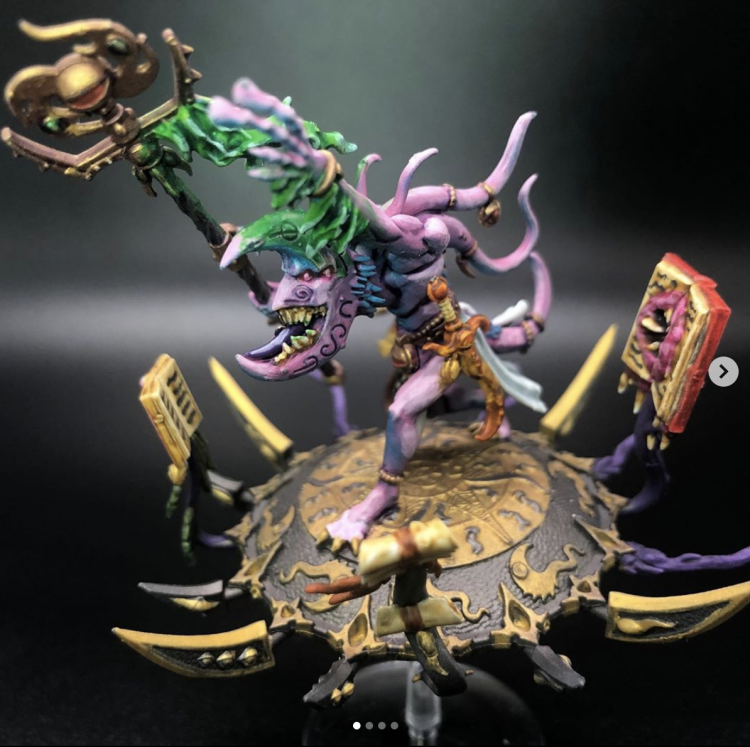
Heralds of Tzeentch
Changecaster
The standard Herald of Tzeentch, with a Locus ability that gives +1 Strength to friendly Tzeentch Daemon units within 6″. This is super relevant both for buffing the shooting attack on Horrors and Flamers, where both have attacks that hit at Strength: User and benefit tremendously from a +1 bump. Changecasters also have the option of taking a Staff of Change, which ups their Smite range to 24″, but is generally not worth the points on something you want as a cheap caster. As a HORROR INFANTRY unit, the Changecaster is a target for the Minions of Magic Stratagem, allowing it to auto-cast a key power.
Changecasters are borderline units but worth bringing in lists that run large blobs of Horrors.
Powers: Because you want the Changecaster in a Horrors- or Flamers- heavy army, Flickering Flames is a great pick for the Changecaster. After that, any mortal wounds power will do as a backup.
Fluxmaster
Basically a Changecaster on a Disc. Makes him faster and better-suited to keeping up with fast units that want his +1 strength aura like Screamers, but the downside is losing the ability to auto-cast.
Fateskimmer
A Changecaster on a Burning Chariot. The Chariot gives him FLY, 5 Toughness, 8 Wounds, and 6 extra S7, AP-3, 2 damage attacks every time he swings, turning him into kind of a kind of poor man’s Daemon Prince that has a +1 Strength aura instead of a re-roll 1s aura and a worse Weapon Skill. These are just way overcosted for what they do.
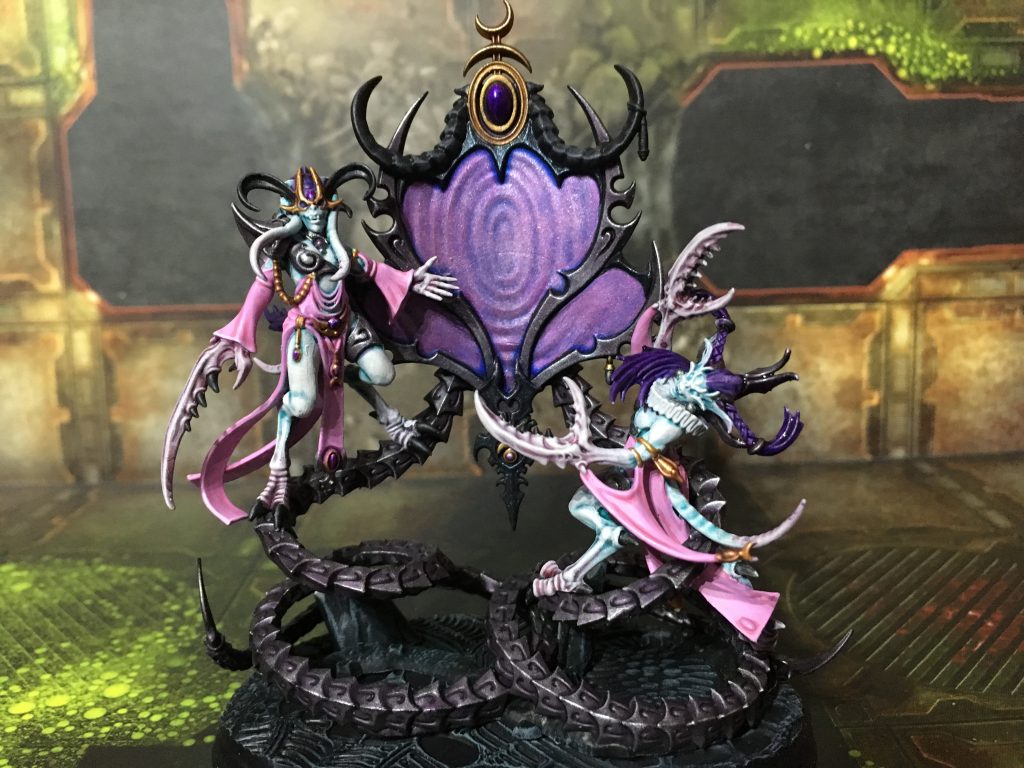
Heralds of Slaanesh
The Contorted Epitome
One of the most powerful tools in the Chaos Daemons’ arsenal, the Contorted Epitome is a mainstay of competitive lists running heavy or mono-Slaanesh. It’s a decent melee unit on its own, sporting a 12” Movement, 8 Attacks with claws and two more with its 3-damage coiled tentacles, and with a +1 Strength aura from the Locus of Slaanesh. But where it really shines is as a force multiplier – it’s an amazingly good psyker, with two casts, two denies, and +1 to attempts at either, and its Horrible Fascination rule prevents units within 6” from making a Fall Back move unless they can roll under their Ld characteristic on 3D6 first – only a 26% chance for Ld 9 units and 16% for units with Ld 8. This makes the Epitome a great companion to Daemonettes, Seekers, Keepers, and any other unit you want to protect in melee. It’s also a great unit to give the Forbidden Gem relic to. The Epitome is pretty much a must-take in a mono-Slaanesh list, but you only need one.
Powers: Because it gets +1 to cast, you almost always want to put Hysterical Frenzy on your Contorted Epitome to bump that to a 7+. Phantasmagoria is your other go-to pick since it’s both easy to cast and combos well with Horrible Fascination and the Forbidden Gem.
Infernal Enrapturess
The Enrapturess has a modified Herald statline that exchanges the +1 Strength buff for improved summoning, a wide aura that causes Perils of the Warp on any doubles for an enemy psyker, a 1 in 6 chance to return an entire model to a unit of nearby Slaaneshi Daemons, and a mid-ranged shooting attack with two modes. The Enrapturess doesn’t really do much for Slaanesh strategies; the vanilla +1 Strength aura is arguably more helpful when you’re running Daemonettes or Possessed, and her aura to mess with Psykers rarely has a meaningful impact on the game. Note that her ability to resurrect Slaanesh Daemons models on a role of a 6+ is limited to codex Daemons units, so it can’t be used to resurrect things like Iron Warrior Obliterators or Word Bearers Possessed.
Herald of Slaanesh
At 55 points apiece, the primary value of Heralds of Slaanesh is being your cheapest HQ option, but that no longer has much value in 9th edition’s army creation rules, where HQ slots are a premium and not a tax. On their own merits, they’re decent fighters, with 4 Attacks at S5, AP-1, 2 Damage that can be AP-4 on wound rolls of 6+. In a mono-Slaanesh army, their biggest advantage is their Locus of Slaanesh aura, which gives +1 Strength to SLAANESH DAEMONS within 6”, a benefit that is particularly strong on Chaos Space Marines units that share the DAEMON keyword and can really use the extra strength, such as Warp Talons and Possessed. That said, you can get the same buff from the Epitome, a much better unit.
Heralds on Seeker Chariots and Hellflayers
These options give you larger, faster, beefier platforms for the Locus of Slaanesh aura, which frankly, you don’t really need given that the Herald’s best trait is costing 55 points and you have the Epitome for that. The Hellflayer is interesting in that it gives itself S9 attacks, but the high variance on the number of attacks you’ll get prevents it from being a worthwhile investment. The Exalted Seeker Chariot makes your Herald targetable with 12 Wounds, and so is actively detrimental in most cases. That said, all of these options are much cheaper post-Chapter Approved, and of them the Herald on Hellflayer is the one most likely to merit consideration.
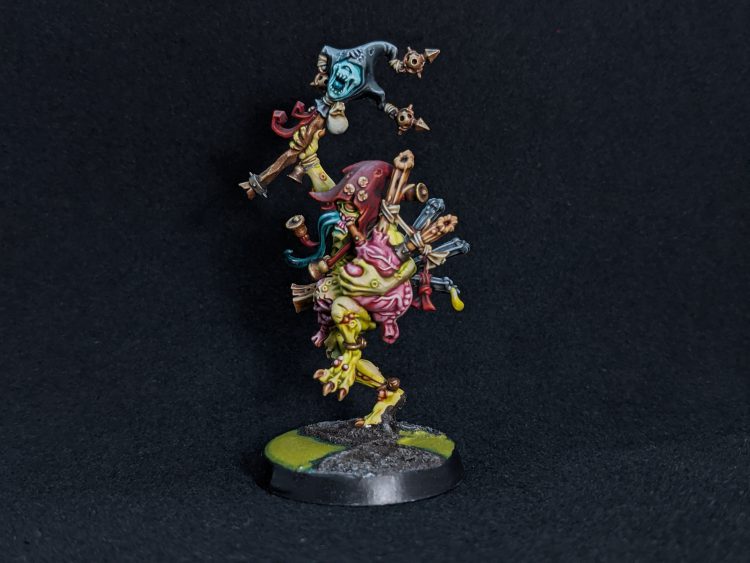
Heralds of Nurgle
Poxbringer
The bog-standard Herald of Nurgle, Poxbringers are basically just bringing a +1 Strength aura and a single cast to the table, but at 75 points, that’s not the worst deal. Plaguebearers aren’t what they used to be, but they’re still durable enough to consider 10-model squads for cheap objective holding and actions, and Poxbringers are just as happy to buff Beasts of Nurgle, which will get a kick out of the +1 Strength bonus and the Locus of Virulence in a Nurgle Detachment (which is the only time you will be running these).
Psychic Powers: These almost always want the Miasma of Pestilence power to make nearby units even harder to kill.
Sloppity Bilepiper
The best-named unit in the entire game, the Sloppity Bilepiper used to be a must-include in Plaguebearer-heavy armies for his ability to allow nearby Nurgle Daemon units to roll 2D6 and drop the highest when making morale tests, substantially increasing the odds of rolling a 1 and getting back D6 Plaguebearers after a rough round of shooting. With 30-model Plaguebearer blobs no longer as viable after multiple points hikes, the Bilepiper is tougher to justify in lists.
Spoilpox Scrivener
The Spoilpox Scrivener boosts the movement of nearby Plaguebearers by 2″ and gives them +1 to hit, plus extra attacks on rolls of a 7+. Not quite as useful as the Bilepiper and ultimately let down by big blobs of Plaguebearers being overcosted but a unit you’ll want to take if you’re planning to run one or more large blobs of them, as you’ll need the movement to get them around the table and +1 to hit (and extra attacks) will do more for you than +1 strength.
Troops
Each god has at least one Troops option, with Nurgle getting an extra (Nurglings), because Ol’ Grampa Nurgle is fun like that.
9th edition tends to favor melee units that can wipe an enemy off an objective and move to capture it in the same turn, ensuring it can be there at the start of your next turn to score. That also means 9th edition favors durable units that can survive through an opponent’s turn once sat on an objective. Some Daemons are better at the wiping part, some are better at the surviving part, and how much they cost is a major factor.

Bloodletters
Let’s start with the group who are, sadly, the worst of the bunch. Bloodletters are essentially glass cannons – very deadly in melee, but also very fragile. They do their best work in large groups (20+), where they can take advantage of their Murderous Tide rule, which gives them +1 to hit. At only 3 Toughness however, they’ll die quickly if something gets a chance to shoot at them or retaliate, so you need to use them either sacrificially to wipe out a key target or have a way to keep them in combat. The bad news is that outside of Skarbrand, there isn’t really a consistent way to do this for Khorne daemons, and Khorne offers very few defensive buffs.
The traditional tactic for Bloodletters is the Bloodletter Bomb: Take a unit of 20, give them a Banner of Blood for 1 CP and an Instrument, then stick them into Reserves with Denizens of the Warp for 1 CP. When they arrive on the battlefield, they can activate the banner and charge 3D6+1”, allowing them to reliably reach almost any charge target ouf of Deep Strike.
Outside of this gimmick, which you really only need one squad for, Bloodletters are only OK They’re too fragile to hold objectives reliably and they lose effectiveness fast once they take casualties and lose Murderous Tide. One Bloodletter Bomb is all you’ll ever really need in most competitive lists unless you’re running mono-Khorne. Going all in on hordes of Bloodletters with a Herald and Crimson Crown buffs is a decent list for semi-competitive play, but just has too many hard counter matchups to get really excited about. The biggest knock on Bloodletters in a mixed god Daemons list is that you’ll typically spend 5-6 CP on your Greater Daemons and relics and after that spending 2-3 CP per Bloodletter squad just isn’t feasible.

Horrors
The shootiest of the lesser daemons, Horrors come in three varieties: Pink, Blue, and Brimstone, with three different points costs. All three have different uses, with Brimstones being your go-to for cheap ObSec units and Pinks being your annoyingly difficult-to-kill objective holders. Pink Horrors come with the ability to do “baby” Smites on a D6 and are capped at 1 mortal wound if they number 10 or fewer, but they can also do a D6 deny and it’s a nice bonus for a unit whose primary value is being cheap and annoying. Their flame shooting attack isn’t particularly great, but with buffs from a Changecaster and Flickering Flames can be quite deadly on a blog of 30 models.
Pink Horrors don’t appear to be particularly tough on the surface, but they have both a 4+ invulnerable save and the ability to split into a pair of Blue Horrors on death, and each of those can further be replaced by a pair of brimstone horrors, provided you pay the reinforcement points. This means that with even 40 reinforcement points, a squad of 30 pink horrors can effectively have an extra 5-10 wounds and get some movement out of its losses. Plus they can still get back their dead models with a good roll for your Morale Test with a Daemonic Icon. On top of that, splitting models lets you place new one within coherency of the others, potentially netting you up to 3” of additional movement off-turn when you’re being shot at while also increasing the number of ObSec models you put on the table..This can be huge when used effectively and if an opponent is dumb enough to shoot a unit of horrors with Overwatch, you can use the split rules to end up 2” closer to your target thanks to unit coherency rules.
Horrors are expensive enough that you’ll rarely run more than one large unit in a soup list, but running a unit of 30 Horrors with an Iridescent Horror and an Icon with 40-50 points in reserves gives you a very difficult-to-kill blob that can still give you some OK shooting by volume and will occasionally net you a mortal wound or two. You can also use the split rules to keep your pink horror count above 20 for longer by allocating new wound to blue and brimstone horrors that you create in the splits.
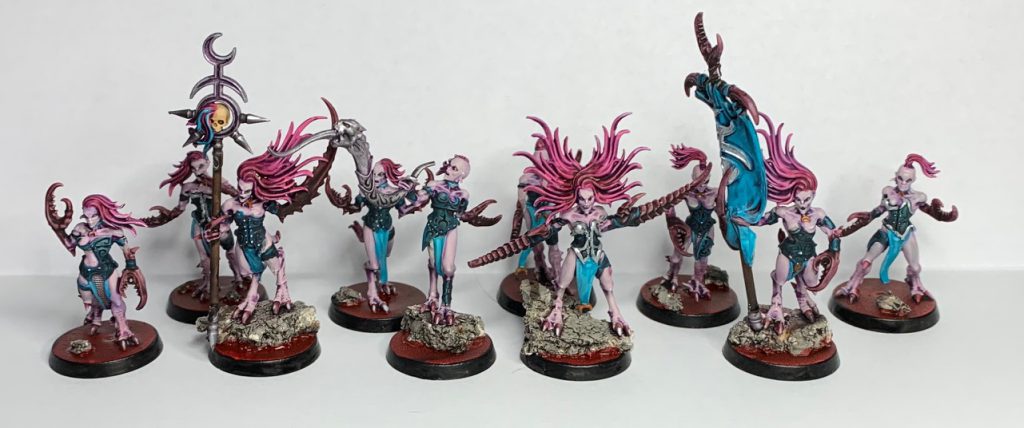
Daemonettes
Daemonettes aren’t as tough as Plaguebearers and they’re not quite as good at fighting as Bloodletters, but they more than make up for that by being the cheapest Troops choice in the army at 7 points per model and having enough tricks to make up for either deficiency.
On the melee side, Daemonettes come with 2 Attacks base (which jumps to 3 when the unit numbers 20+), and AP-1 weapons that jump to AP-4 on Wound rolls of a 6+. This can be further improved with the Razor-Sharp Caress Stratagem from Engine War, which improves their AP by 1 for a phase, which can make them pretty deadly. The downside is that Daemonettes are only 3 Strength, and so they benefit greatly from having a Herald around to get them to 4, which is where Syll’Esske or the Contorted Epitome can be a great help. Daemonettes also really want to have the Locus of Swiftness active (requiring a pure Slaanesh detachment), as it gives them the ability to Advance and charge, letting them rush around the battlefield and get into combat without having to teleport in.
On the durability side, Daemonettes don’t have many ways to get tougher, but you can protect them from shooting by keeping them locked in combat. They can use the aforementioned Locus of Swiftness to close gaps quickly and engage enemy units, and then use the abilities of either the Contorted Epitome or Fiends to keep units locked in combat with Daemonettes and prevent them from being shot. You’ll notice I’ve mentioned the Epitome twice now – it’s very very good. Just be sure to wrap with your Daemonettes in addition to using the Epitome so you don’t end up getting murdered if you roll poorly for Horrible Fascination.
Daemonettes have more cross-unity synergy than any of the other Troops in Chaos Daemons and as a result they’re one of the best Troops choices in the game, combining a lot of versatility and power with a bargain-rate points cost. The only downside is that you’ll need to commit to running them if you want to run large groups, and that will often mean a mono-Slaanesh or nearly mono-Slaanesh army. The upside is that three units of 20-30 Daemonettes can form the backbone of a very competitive list.
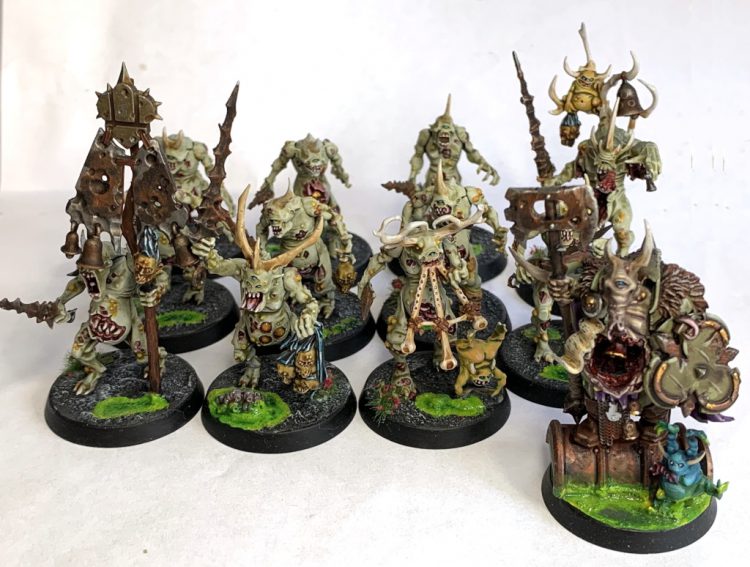
Plaguebearers
Once an absolute menace on the competitive circuit, Plaguebearers are the hardest to kill of the lesser daemons with 4 Toughness, Disgustingly Resilient, and Cloud of Flies to make them difficult to kill and making removing a unit of 30 of them a nightmare, especially if they have an Icon and a Sloppity Bilepiper nearby to give them a good chance of getting models back. The problem is that they’ve gotten points increases twice now, and at 9 points per model they’re a bit too expensive to make running large blobs a competitive strategy. That said, it’s still brutally tough to chew through and you’ll do just fine in more casual games running one.
As-is, there’s still a use-case for taking units of 10 as cheap, tough objective holders for your backfield in soup or Nurgle-heavy lists. Unlike Nurglings, they can also perform actions.
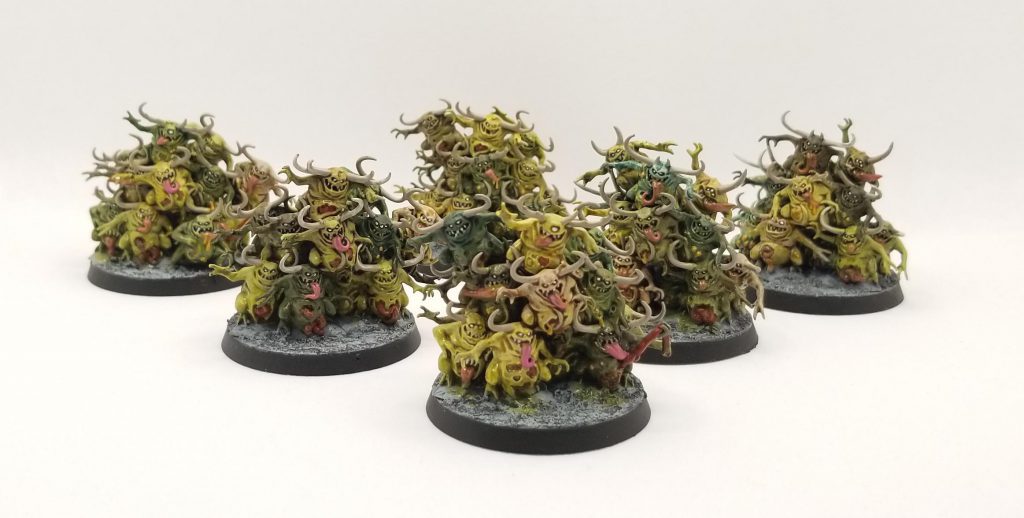
Nurglings
Nurglings were one of the best units in 9th edition until their most recent points increase but even at 22 points per model they’re still alright – you’re just going to be taking squads of 3 instead of 5. At 4 Wounds and with Disgustingly Resilient against 1-damage attacks, they’re pretty tough but where they really shine is in their ability to deploy anywhere on the table more than 9” from enemy models or the enemy deployment zone, allowing you to put ObSec units on objective before the game starts, slowing down your opponent’s attempts to capture them and helping you score primary objective points. At 66 points for a squad of 3 they’re still among the cheaper Troops choices you can take and it’s worth looking at them if you aren’t planning to perform actions.
Elites
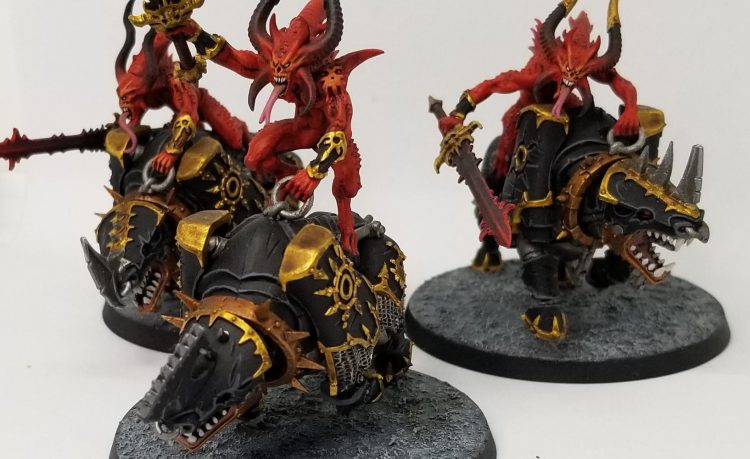
Bloodcrushers
Bloodletters on Juggernauts. Faster and tougher than Bloodletters, but neither fast enough nor tough enough to be a build-around unit. The extra wound they picked up combined with some points drops has made them ever more tantalizing but never good enough to see the table. A big part of this is that they just aren’t durable enough so while they can put out a silly amount of damage as part of a Banner of Blood charge, they won’t be able to hang on to score the objective afterward and they lack Objective Secured to boot. They do make good targets for Warp Surge, if you’re taking them.
Engine War introduced the Brass Stampede Stratagem for these guys and while the notion of charging through one unit, killing it with mortal wounds, and then charging another seems amazing, it’s never going to happen for you, in part because of how big the bases on Bloodcrushers are, limiting your potential output.
Mike P: I so, so badly want to recommend Bloodcrushers. “Angry daemons riding even angrier daemon horses” is everything Khorne fans love about this army. But they are (blood)crushed by the fact they only move 8” and have the Cavalry keyword, which can make it very difficult to actually get clear charge angles since they have to move around terrain. The lack of multi-damage attacks means they can really underwhelm against high value targets. Costing 2 CP to deepstrike for any unit larger than 3 is also rough. They’re one more points drop away from being good, but aren’t quite there yet.
Flamers
Flamers are interesting, durable units that can cover large distances and belt out significant amounts of very respectable AP-1 shooting. They really benefit from being near a Herald in order to bump their shooting up to S5, and like Horrors can benefit from multiple buffs to their Strength and To Wound rolls. Flamers also benefit greatly from both the Flickering Flames spell, which gives them +1 to wound, and the Flames of Mutation Stratagem, which causes 1 mortal wound on a target each time they roll an unmodified 6 to wound (so tragically these don’t stack). A unit of 6 Flamers can do a surprising amount of damage with what will be on average 21 hits causing 3-4 mortal wounds and wounding on a 2+ against T4 targets. That said they’ll do well enough without the extra support, and their having a 12” movement characteristic and FLY means they can travel across the board quickly.
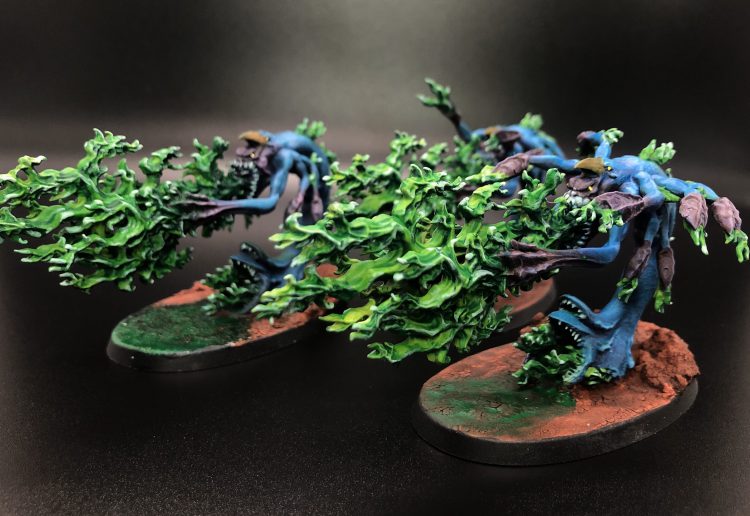
Exalted Flamer
Exalted Flamers pack what in theory could be some of the faction’s best shooting – 18″ S9, AP-4 D3 Damage shots at Heavy 3 and BS 3+ – onto a platform with the CHARACTER keyword. But the low volume of shots and Heavy penalty means you’ll probably get more value out of high-volume options. This unit’s best value is likely being a fast flying character that can still perform the Raise the Banners Secondary Objective action.
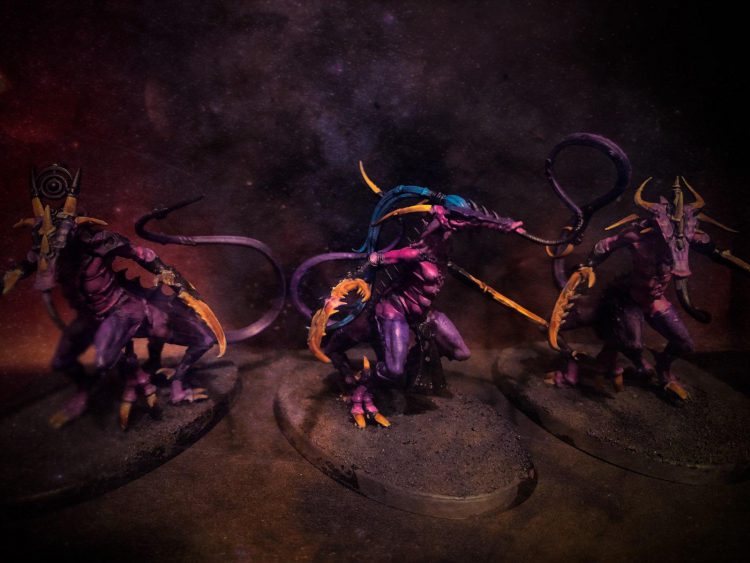
Fiends
Fiends flew under the radar for a long time but thanks to several points drops and a new datasheet are now one of the cornerstone units in a Slaanesh Daemons army. They’re fast, they pack a decent punch, and most importantly, their Soporific Musk rule makes them the most reliable way to trap units in combat in the game. Every Slaanesh army wants at least one and probably 2-3 small units of Fiends to run alongside Daemonettes and Keepers to help protect those units by keeping enemy units locked in combat with them. They’re individually expensive and you’ll find they’re pretty fragile once they start getting attacked, so using Fiends well requires a lot of planning and careful movement, even after you get them into combat – you’ll want to limit their exposure as long as possible.
In addition to their utility as melee trappers, Fiends also have a couple of fringe benefits – Disruptive Song gives enemy psykers -1 to their tests within 12” and is a strong add-on, and Song of Discordant Despair from Engine War can drop a nearby enemy’s Leadership by 2. That BEASTS can move through Breachable Terrain in 9th edition (Read: Ruins) is also a huge point in their favor, and part of why they’ve become common in 9th edition lists.
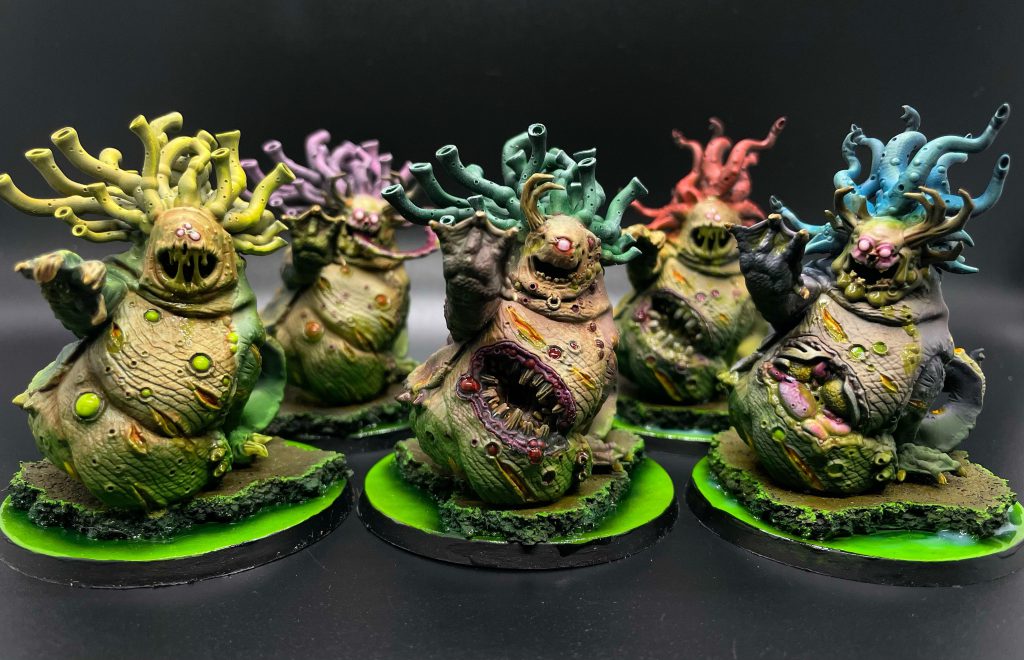
Beasts of Nurgle
Beasts of Nurgle were already trending upward after they got a late 2019 points drop but changes to the game’s core rules and mission structure in 9th edition have made Beasts of Nurgle one of the game’s best units. At T5 and 5 wounds apiece with Disgustingly Resilient they’re incredibly tough. Their ability to Heroically Intervene as if they were a character means that they can control large swaths of the board by forcing your opponent to play around them or end up stuck in combat with a unit that’s difficult to kill, has a 2-damage melee weapon, and causes mortal wounds to units attempting to Fall Back. Engine War was also a huge boon for them, adding the Acidic Slobber Stratagem to boost their damage output.
Large units of Beasts are great mid-table objective holders in competitive play, where their ability to intervene means that ObSec units can’t challenge them for control without ending up getting into melee combat, and they’re big and expensive enough that they make a great target for a Great Unclean One with a Plague Bell. The only downside is that they cost $44 per model, so building an army with 10-15 is going to be stupid expensive.
Fast Attack
Flesh Hounds
Khorne dogs are a solid, but overpriced, harassment unit. For over double the cost of a Bloodletter, you get more speed, higher toughness, an extra wound, an extra attack, and the ability to attempt to deny one psychic power per enemy phase. Unfortunately you give up having AP-3 and the ability to do multiple damage on an attack. Flesh Hounds got an additional boost from Engine War’s The Scent of Blood Stratagem, which lets a unit of Flesh Hounds charge even if it Advanced this turn and you get +2 to the charge if any enemy models have been destroyed this turn, was something they really needed to improve their threat range. With the extra boost and greater durability over Bloodletters, they’re worth looking at in a mono-Khorne army, but they’re not going to crack the lineup in an undivided list.
Also noteworthy is Flesh Hounds’ ability to Deny the Witch can make them useful as anti-psyker units that can cover large distances and disrupt enemy plans, as well as prevent enemy units from completing Psychic Actions.
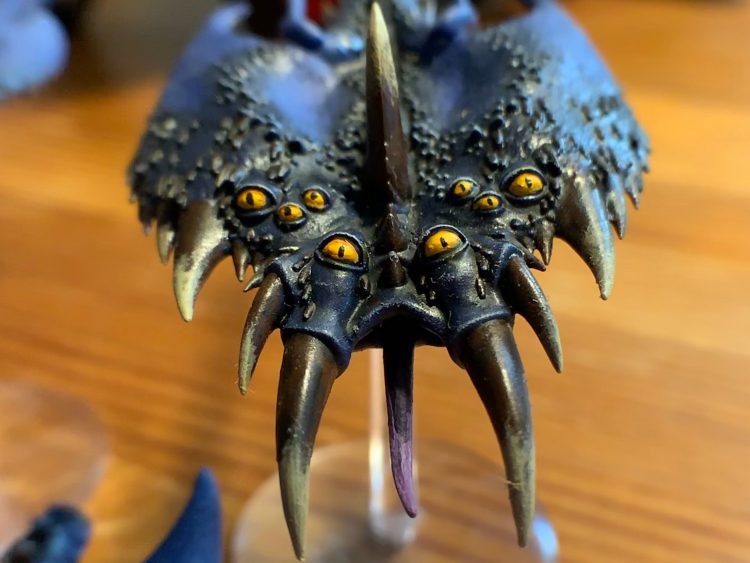
Screamers
Fast and surprisingly deadly, Screamers are an underrated unit in the Codex: Daemons arsenal. They’ve become much more useful in 9th edition as the sudden shift to 2W infantry has made their S6 AP-3 D2 Lamprey Bite much more useful and the ability to upgrade it against vehicles with Engine War’s Warp Jaws Stratagem (+1 to wound against vehicle or monster targets) gives them a lot more versatility. Taking 1-2 units of 3-5 Screamers can be a competitive option in the right list, and they’re a necessity in any mono-Tzeentch army.
Larger squads of Screamers make great targets for Warp Surge if you need to protect them and they’re very good targets for the Boon of Change psychic power, where any one of the three random buffs is actually very good on them. They’re also great targets for a Changecaster or Fateskimmer’s +1 Strength aura, since getting them to S7 will let them mangle vehicles pretty reliably once you fire up Warp Jaws.
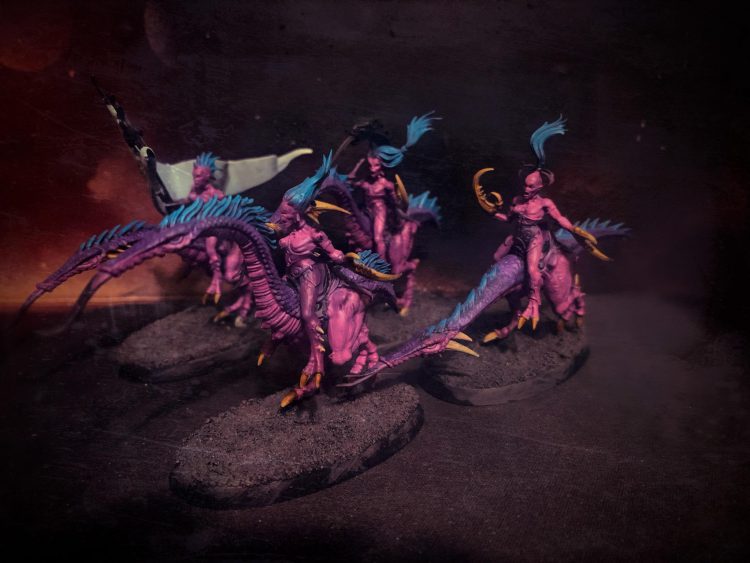
Seekers
Seekers saw some play in mono-Slaanesh lists at the end of 8th edition, but have largely been eclipsed in 9th by large blobs of Daemonettes and Fiends, leaving them without a strong role. They combine the speed of fiends with Daemonettes’ weapons, plus an extra wound and some tongue attacks, but they lack the ability to trap units in melee, meaning you’ll still need Fiends, They also don’t get the buffs INFANTRY daemonettes do, mainly Razor Sharp Caress for additional rending. The free re-rolls on charge rolls and ability to get -1 to be hit with Sinuous Undulation are nice, but not enough to make this unit worth taking in most lists.
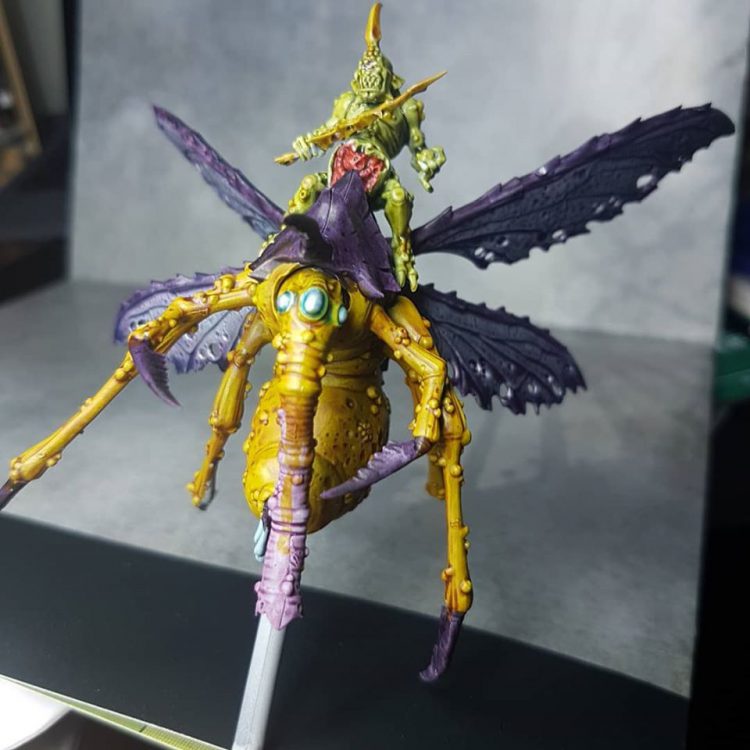
Plague Drones
Plague Drones are tough flying units with 4 wounds apiece and the ability to do some nasty attacks thanks to the 4 attacks they get from their mounts, which are 2 damage each and re-roll failed wound rolls. With the January points update, they’ve dropped in cost to something more on the level with Beasts of Nurgle, making them a much more intriguing option especially in mono-Nurgle lists. In this case, you’re essentially trading one wound and the ability to Heroically Intervene for extra movement, FLY, and some additional attacks. Losing the ability to Intervene is pretty big, but there’s enough upside in the attacks and movement that it may be worth considering these guys in some competitive builds.
Hellflayer
Similar to the Seeker Chariot, the Hellflayer adds D6 additional Sx2 (so 8), AP-1, 2 Damage attacks to the chariot’s profile and is a Fast Attack option. It’s mediocre, and doesn’t really do enough to merit taking.
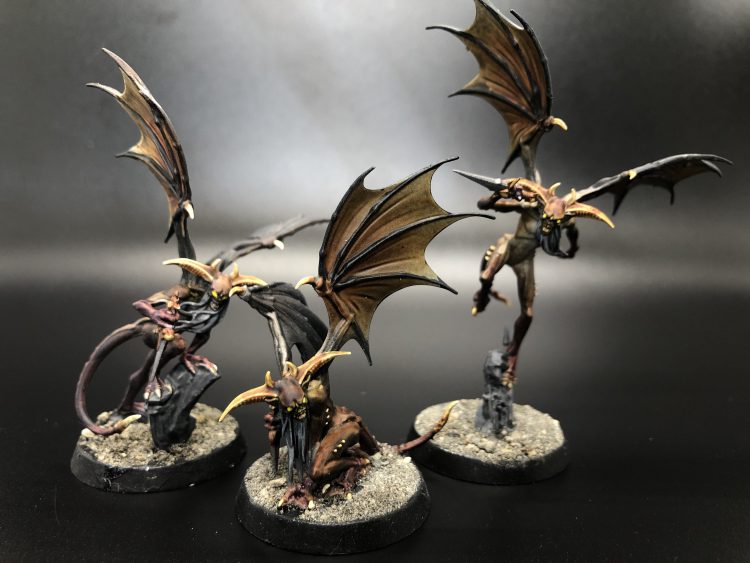
Chaos Furies
Fast little Flying melee units that finally got new models in Warcry of all things, Furies are sneakily one of the most useful units in the codex – they’re fast, cheap, and annoying to deal with. They come with 12” Movement, FLY, and 2 attacks each at S4 and while their weapons aren’t amazing, it’s important to remember that they’re only 9 points per model. Furies get an extra upgrade from being devoted to one of the four Chaos gods; these are just the standard rules that daemons of each god get and so the most useful ones are Nurgle and Slaanesh. The former makes your furies very tough for their cost and the latter gives you the ability to fight first and benefit from a number of good Slaanesh abilities such as Locus of Swiftness. Khorne is also an OK option for the Unstoppable Ferocity ability though Khorne doesn’t really need more melee options, even ones that can fly.
Mike P: Furies are a unit tailor made to play 9th Edition missions, and it’s tough to find a Daemons list that won’t benefit from a unit or two of Furies. 45 point Infantry with Fly that move 12” (and can be deepstruck for 1 CP) make it so easy for Daemons to Raise Banners and Deploy Scramblers. They’re also great for tagging/wrapping shooting units or soaking up Overwatch.
Heavy Support
Daemons don’t have a ton of Heavy Support options, and what they do have tends to be light on actual support.

Skull Cannon
They’re not great, but they aren’t terrible, either. The Skull Cannon has a battle cannon that ignores cover on a fairly tough platform that won’t fold immediately in combat. The big problem is that while the gun isn’t bad, their shooting is just too unreliable – variable shots, mediocre BS, and variable damage make for a gun you just can’t count on. Their biggest upside is that at T7, 7 wounds, and a 3+/5++ save, they can be pretty durable, especially when you add in Warp Surge and Bound in Brass and Bone from Engine War, which halves incoming damage. At 90 points, this can make them somewhat inexpensive backfield objective holders with the upside of having some ranged fire and a base big enough to screen out deep striking enemy units. Taking more than one is probably throwing away points though, and they aren’t important enough targets to need redundancy.
Soul Grinder
One of the big winners of the January 2021 points update, Soul Grinders dropped 15 points, down to 175. That’s a pretty big and welcome drop for a unit that’s still essentially a poor man or woman’s Defiler. Soul Grinders come with 14W and a degrading profile that starts them at BS 4+ and 5 Attacks and drops those to 5+ and 3/D3 as it loses wounds, which isn’t ideal but isn’t as devastating as it could be. They come with two guns – the Harvester Cannon is a 48” Heavy 3, S7 AP-1 D3 damage gun and the Phlegm bombardment is a 36” Heavy D6, S8 AP-2 3 damage attack that combined give the Grinder a decent potential ranged punch, but with only 4+ BS to start you’re going to be a little underwhelmed by the actual results most of the time. In melee the Soul Grinder has some decent weapon options but with only 5 attacks and WS 4+ they’re also not amazing melee combatants.
Like Furies, Soul Grinders dedicated to one of the four Chaos gods get the related ability, which means that the only two options for them competitive are Tzeentch, where they get a 4+ invulnerable save, and Nurgle, where they get Disgustingly Resilient. Either dramatically improves their durability and makes them much more efficient for their points cost. In a Tzeentch army you’ll want to pair one with the Changeling to get that extra 6+ to ignore wounds for maximum durability.
Burning Chariot
Basically an Exalted Flamer riding on a pair of Screamers. Being able to pop off S9 AP-4 D3 damage shots at 18″ isn’t too bad, but it’s not quite good enough, either. Burning Chariots don’t shoot well enough to be a good shooting unit, and don’t fight well enough to be a great melee unit in an army that already has lots, and they aren’t durable enough to survive once they start getting targeted. They’re overcosted for what you get and have virtually no synergy with the rest of the army.
Seeker Chariots / Exalted Seeker Chariots
Large, conspicuous melee units that are likely to be shot off the board before they can do much damage and aren’t much of a threat when they actually do arrive in combat, thanks to having low Strength and AP on their attacks. The Seeker chariot is nearly useless but the Exalted Seeker chariot has some play against hordes thanks to having 16 attacks and the ability to toss out mortal wounds after charging – a good turn can easily net you 10+ kills and that’s before you use the Flensing Impact Stratagem from Engine War to generate additional hits on 6s. That said, whether you actually need a chariot to help with hordes is going to depend a lot on your local meta. A bunch of S4 1 damage attacks aren’t going to do a ton for you against marines.
Mike P: Exalted Seeker Chariots do very little damage despite their 16 Attacks, but that’s not their role in the current codex. At 12W and T5 with a 12” Movement for a mere 80 points, they are the rare Slaanesh unit that can hold an objective or rush up to move block without being blown away immediately. They’re not actively great, and I would always rather have an additional Keeper of Secrets instead of 3 of these, but there are far worse things in the game that you could spend your points on.
Fortifications
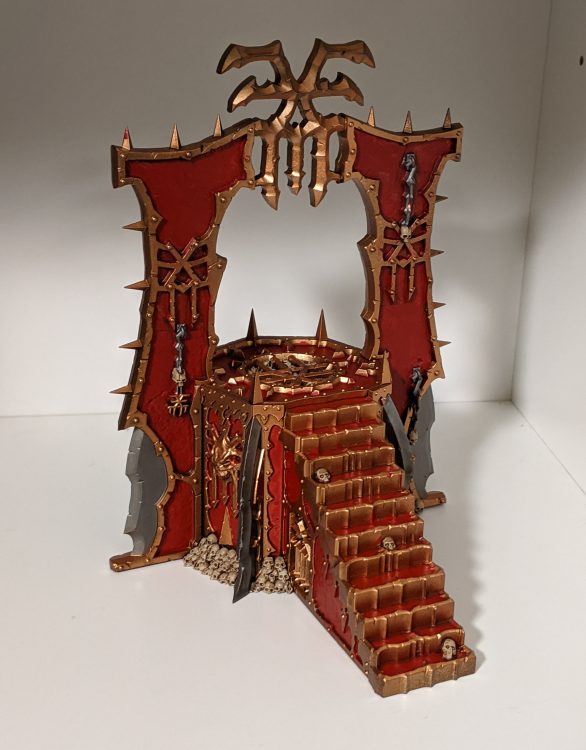
Skull Altar
Fortifications generally aren’t good in 9th edition and this one is no exception. The buffs it gives aren’t bad but 9th edition games, particularly ones where you’re running Khorne Daemons, want you pressing forward and controlling territory not hanging out in your deployment zone where this thing is locked. On top of that 9th edition’s deployment rules are actively hostile to fortifications. The buffs it gives aren’t bad but they aren’t particularly amazing, either – its best use is as a movement blocker for vehicles and other big units without FLY, and that means you probably want to summon it. And by “want to” I mean “do not want to.”
Feculent Gnarlmaw
The Feculent Gnarlmaw has some interesting abilities that potentially making it worth having around despite having to jump through the usual hoops to actually get it on the table. The nature of the bonuses, particularly the extra cover save benefit, are generally more helpful to Chaos Space Marines than Daemons. Iron Warriors Nurgle Obliterators with an effective -1 Armour Save will never not be hilarious, even if that’s not a particularly effective tactic overall.
Forge World
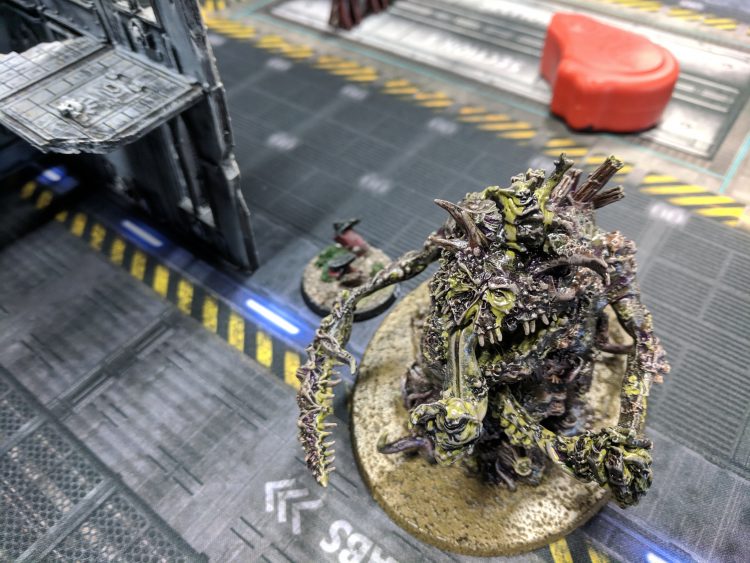
Compared to the other factions of the 41st millennium, Daemons don’t have a ton of resin units to think about. The major ones to consider are the Titanic Greater Daemons with a few unique HQ choices mixed in. These are more of a novelty than true competitive threats, though there are some outside use cases for Scabeiathrax and An’ggrath if you bought the models and are determined to use them. An’ggrath is a flying monster with the combat prowess of a knight (and can fight twice for 3CP) and Scabieathrax is a massive great unclean one that can actually do some real damage in melee. Zarakynel throws out a ton of Mortal Wounds in combat, and is an option for the crazed geniuses who looked at their 3 Keepers of Secrets and Shalaxi and wonder, “How can I fit more Keepers of Secrets into my list?” Mamon Transfigured and Uraka The Warfiend are very aggressively costed alternatives to Daemon Princes, and Cor’bax Utterblight plays the role of a budget Great Unclean One well. Mamon’s a bargain at 130 points and has seen success in competitive play giving Nurgle daemons re-rolls to hit. He’s more durable than a Daemon Prince and combines well with Epidemius to make some real nightmares for opponents.
Playing With Daemons
There’s an entire daemon planet’s worth of content that could be written about playing with Daemons. In this section we’ll try to cover the important basics and the different ways you might try running Daemons. Generally, there are six key aspects of the Daemons army to explore:
- Mono-god Daemons (e.g. running mono-Khorne, Tzeentch, Nurgle, or Slaanesh)
- Chaos Undivided Daemons (running daemons from multiple gods)
- Chaos Soup (combining Daemons with Chaos Knights or Chaos Space Marines)
How you use daemons will depend heavily on how you’re running them and the role they play in your army. We’ll talk about some basic strategies for each setup and some things to keep in mind as you play Daemons.
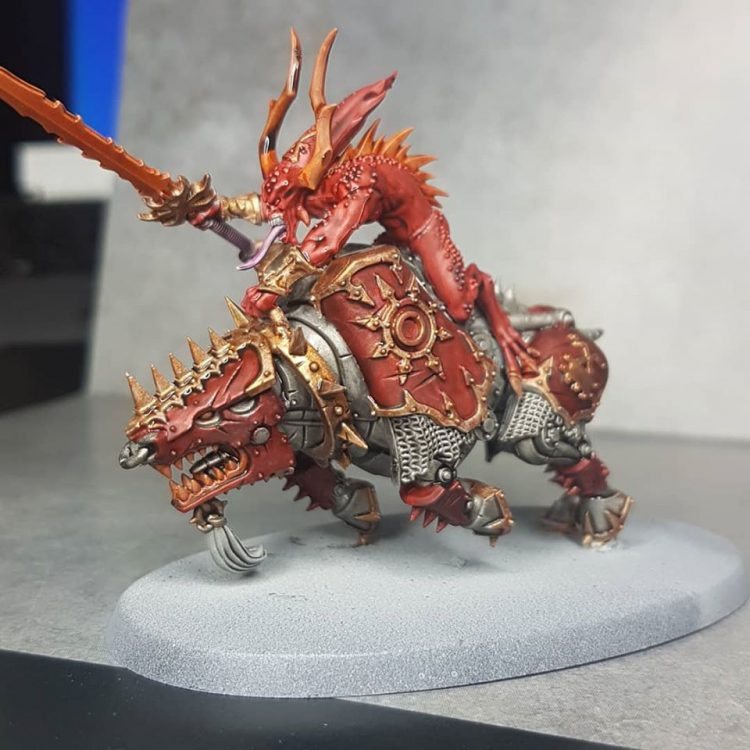
Pure Khorne Daemons
Running Khorne Daemons is a “boys before toys” situation. Bloodletters will be what wins you the game. Investing in 3 or 4 big units of Bloodletters with some support characters (a Herald, Daemon Prince, or Blood Throne with the Crimson Crown is a great start) is the strongest core to a list. You’ll spend lots of CP to upgrade some of the Bloodletter units to the classic “Bloodletter Bomb” setup (a unit with an Icon and Instrument deepstruck with Denizens Of The Warp and upgraded with the Banner of Blood Stratagem for a 3d6” + 1 charge). Putting them into the Warp protects them until they want to arrive and fight and the Banner ensures they’ll make the charge.
From there, you have a lot of room for creativity in filling out the rest of your list. An Exalted Bloodthirster or two to hide behind Obscuring terrain and counter-charge anyone in the midfield isn’t a bad pick, while some Furies to perform Actions and Flesh Hounds to provide some speed can round out the list.
Mono-Khorne is the weakest way to run Daemons, so if you’re committed to dedicating yourself to the Blood God then you have to accept that will simply run into some hard-counter matchups you really can’t deal with. AdMech, Imperial Guard, and Infiltrator-heavy Marines will simply present problems that your toolbox doesn’t have any answers to. But shoving 100+ Bloodletters down an opponent’s throat can certainly overwhelm many other opponents, and you’ll have a good time if you can maximize your Fight phase movement to steal objectives with all of your aggressive ObSec bodies.

Pure Tzeentch Daemons
Tzeentch Daemons are an army that can score lots of Secondaries reliably. You’ll want to start your Tzeentch list with an Impossible Robe/Incorporeal Form Lord of Change, and from there bring in a Changeling to build around that 9” Feel-No-Pain bubble for Tzeentch Daemons. Your 3rd HQ slot if you’re running a single Battalion should be a Changecaster or Fluxmaster to provide the Strength buff that Horrors and Flamers love. You’ll also want to invest in at least one big block of Pink Horrors with some splitting points available to keep them above 20 models for as long as possible.
From there you have a few different options. A second block of 20 Pinks to provide a second wave of shooting out of deepstrike and charge their ObSec bodies onto objectives (remember to split a Blue Horror forwards if they Overwatch for a 6” charge!) will help you play the mission well, as will some MSU Pink Horrors with splitting points left over. A block of Flamers (either 9 to maximize buffs, or 6 so you can deepstrike them for a single CP) will help provide some damage, while some units of Screamers will provide some harassment ability and Marine-crunching 2 damage attacks. A second Lord of Change is not a bad flex pick, but running 3 Lords of Change is probably going too far because you’ll quickly run out of spells to cast.
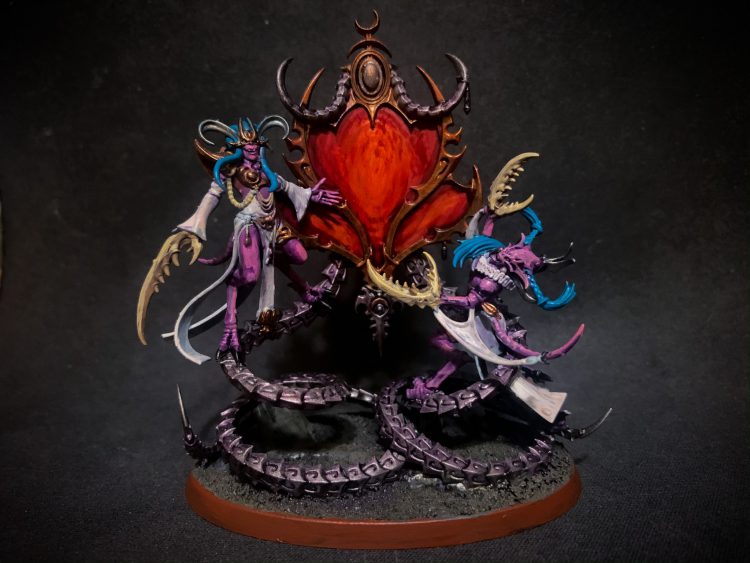
Pure Slaanesh Daemons
Slaanesh Daemons have arguably the strongest suite of HQs in the entire game. In fact, Slaanesh Daemon HQs are so strong compared to the rest of the faction that traditional 9th Edition list-building rules can be thrown out the window. Treating CP as an afterthought and going with 3 Patrols to maximize your HQs and Exalting 3 Keepers of Secrets is a fine way to build your lists.
Keepers of Secrets are amazing units and the best of the large Daemons to spam – running up to 3 Exalted Keepers and Shalaxi Helbane is a great start to a list. The Contorted Epitome and Fiends make great additions to the list by keeping your expensive Monsters locked in combat with the opponent, where they can avoid being shot and then use Quicksilver Swiftness to fight their way out of combat before the opponent gets to swing.
If you’re interested in running a more horde style list focused on Daemonettes (probably in a single Battalion structure or Battalion + Patrol), then Syll’Esske is a near mandatory pick. In addition to being an incredible model, he provides 3 excellent buffs for your Daemonettes while being an absolute beast in combat. Depending on how heavily you’ve invested in Daemonettes, the Masque is also an excellent pick to increase their durability.

Pure Nurgle Daemons
Nurgle Daemons have surprisingly complicated decisions to make when writing their lists. The buffs that you want are split up across a variety of pricey HQ choices, and you need a list that came prepared to play the mission very well because you’re not going to win through killing.
Nurgle Daemon’s strongest units are Nurglings and Beasts of Nurgle, so you’re probably going to stick to a single Battalion as that will provide enough Troops and Elites slots. Nurglings are too pricey to max out on these days, but 3-5 units are still an excellent way to gain early board control. You can also bring a block or two of Plaguebearers. While they are no longer arguably the best Troop in the game like they were for large parts of 8th Edition, Plaguebearers remain a solid choice for sticking around back and mid-field objectives while performing Actions. Large units of Beasts of Nurgle are excellent for grabbing objectives and disrupting enemy plans, and a unit or two of Plague Drones to give you some more mobility and ability to get over Difficult Ground or around non-Breachable terrain quickly is a great idea. And since you’re building a list designed to focus on playing the mission, don’t forget to bring a unit or two of the always useful Furies.
Since you’ll generally only have a few HQ slots and they are all quite pricey for what they do, make sure you bring HQ’s that really synergize with your list. For example, if you only have one big block of Plaguebearers, it’s not worth bringing a Spoilpox Scrivener even though his buffs for that Plaguebearer unit are quite good. A Great Unclean One with the Revoltingly Resilient Exalted reward and the Doomsday Bell to revive dead models is a great pick for most Nurgle armies, along with a Poxbringer for a cheap cast. Horticulus Slimux has some genuinely great buffs and is probably worth bringing if you’re running ~10 or more Beasts of Nurgle. If you want to up your army’s damage output, Mamon Transfigured is quite strong for his points and gives you a durable re-roll aura in the center of your army.
Daemons of Chaos Undivided
Daemons (with rare exceptions like Be’lakor) don’t have any buffs that work across Gods, so playing Undivided Daemons is all about identifying the best units from each of the Gods and bringing them together in the right proportions. Tzeentch, Nurgle, and Khorne units don’t really need their mono-God loci benefits so they play nice in detachments together, while Slaanesh units really benefit from sources of the Advance and Charge loci so they require you to bring at least one mono-Slaanesh detachment. A great structure for an Undivided Daemons list would be along the lines of an Undivided Battalion that mixes Khorne/Nurgle/Tzeentch and a Slaanesh Patrol to bring in some Keepers and Fiends
A single Bloodletter bomb is a great tool even without any other Khorne buffing elements, as they are still deadly enough to require your opponent to expend resources screening them even unsupported. Several units of Nurglings also bring an element of pre-game board control that the other Gods lack, which can be a huge boon when facing armies like Raven Guard. You can also dip into Nurgle to bring some Plague Drones and Beasts of Nurgle to provide some beef on mid-board objectives. Bringing in Tzeentch requires a bit more forethought, as their shooting really relies on synergies with a Herald and Flickering Flames to become dangerous. A big block of Pink Horrors and/or Flamers slots very well into mixed lists, but make sure you’re saving an HQ slot and points for a Changecaster or Fluxmaster to take them to the next level.
Undivided lists are less prone to hard-counters than armies like pure Slaanesh or Khorne Daemons, because your damage is more likely to be a blend of Psychic/Shooting/Melee. You can also lean on the most durable units from several Gods for board control, mainly pairing the Impossible Robe/Incorporeal Form Lord of Change with Nurgle Daemons. Focus on bringing buffing HQ’s only when required (mainly to buff Tzeentch shooting) and invest your points in units like the Lord of Change or Beasts of Nurgle that shine without requiring specific Psychic buffs, and you can build an extremely strong Undivided list.

Daemons in Chaos Soup
Taking Daemons as part of Chaos soup is typically about mixing the best units of the Daemons faction with the best parts of the other Chaos factions and taking advantage of 8th edition rules synergies that work across factions thanks to HERETIC ASTARTES units having the DAEMON keyword (though these synergies’ days are likely numbered). Most of the time this will mean mixing Daemons with Chaos Space Marines and Thousand Sons, though there are some opportunities for mixing them with Death Guard and Chaos Knights as well.
The three Chaos Marine factions each bring different things to the table: Chaos Space Marines proper add ranged attacks and durable midfield objective holders in the form of Noise Marines, Obliterators, and Terminators, and can have synergy with Chaos Daemons through their own Daemon units, notably Obliterators and Daemon Engines. Thousand Sons bring powerful additional psykers to the mix, and both they and Chaos Space Marines give you access to the Dark Hereticus discipline, which has some powerful effects to work with. Death Guard have the least synergy with the faction owing to their new codex, where mixing Daemons and Death Guard will lock you out of their faction’s unique Contagions of Nurgle bonus; however there’s still an argument to be made for mixing daemon engines like Myphitic Blight-Haulers with effects like the Great Unclean One’s Plague Bell and Epidemius’ army-wide buffs to DAEMON units.
For standard Heretic Astartes, the Emperor’s Children are the strongest legion currently, owing to a host of incredibly strong stratagems and access to Noise Marines as troops, and this means that well-tuned Chaos soup armies will tend to get more mileage out of combining Emperor’s Children and Daemons of Slaanesh (though some successful builds run Slaanesh marines from Red Corsairs or other legions). Chaos Marines of all legions also give you access to Chaos Cultists, the cheapest ObSec unit you can take across any Chaos book and capable of performing actions.
That said, unless you’re looking to build a mono-god soup army don’t overthink the synergistic aspects of chaos soup – just taking the best units each faction has to offer and building an army around having the best unit for each role is a very competitive strategy. Most great soup lists incorporate the Exalted Lord of Change as their warlord, liberally use Beasts of Nurgle and Nurglings to clog up the middle of the table, add Daemonettes and Keepers of Secrets for a deadly swift punch, and use Noise Marines or Chaos Terminators as ranged support or add in Thousand Sons sorcerers for extra psychic power.

Choosing Secondaries
Because Daemons can be built a number of different ways, they have a lot of options when it comes to choosing secondary objectives. Generally speaking, when you build an army in 9th edition you should build toward a set of secondary objectives that you plan to score every game – plan around at least two that you can reliably score and have some backups in mind. Additionally you should try and choose secondaries that align with your army’s pre-existing game plan over ones that ask you to do something you wouldn’t otherwise be doing.
Because of the army’s mobility and the ability to put units into the warp/deep strike with the Denizens of the Warp Stratagem, Daemons can cover large parts of the table pretty easily, and so Engage on All Fronts is an extremely solid pick for the army. Because you can cover a lot of ground, have lots of troops, and may potentially have Nurglings sitting on objectives from turn 1, Domination can also be a solid pick for Daemons, particularly against slower armies. For armies running lots of Plaguebearers or Horrors Grind Them Down can be a solid pick since your opponent will be unlikely to tear through those in a single turn. While We Stand, We Fight can also be a decent pick given how hard it is to kill the Impossible Robe/Incorporeal Form Lord of Change and some of the bigger squads of Troops – a 30-model unit of plaguebearers will easily cost more than a greater daemon and be an utter nightmare to take off the table if there are more pressing targets for the enemy to deal with, particularly if you’ve got a Sloppity Bilepiper handy. Raise The Banners High can be a strong pick on tables with several objectives near your deployment zone, as units like Furies and Exalted Flamers can quickly get to forward objectives while your units like Beasts Of Nurgle move up to hold the objective and farm Victory Points.
On the Shadow Operations side, Deploy Scramblers can also be a good pick for armies that are running minimum-size units of troops, but will not typically be something that 30-model blobs want to do. It synergizes well with Engage on All Fronts since it wants you to have units in multiple zones on the table.
Because Daemons have access to a number of Psykers, they’re more readily able to accomplish psychic actions from the Warpcraft category. Unfortunately, these tend to be pretty bad, in part because post-FAQ they can be denied by stratagems and abilities that can deny psychic powers, many of which do so on a 4+. Mental Interrogation remains a solid pick for Slaanesh Daemon armies, which often have Psykers (mainly Keepers of Secrets) in the opponent’s face to perform it and enough Psykers that you are more than happy to trade a single Keeper’s casting for Victory Points.
Finally remember that Nurglings are not INFANTRY, and so cannot perform actions (outside of mission specific ones that don’t require specific keywords).
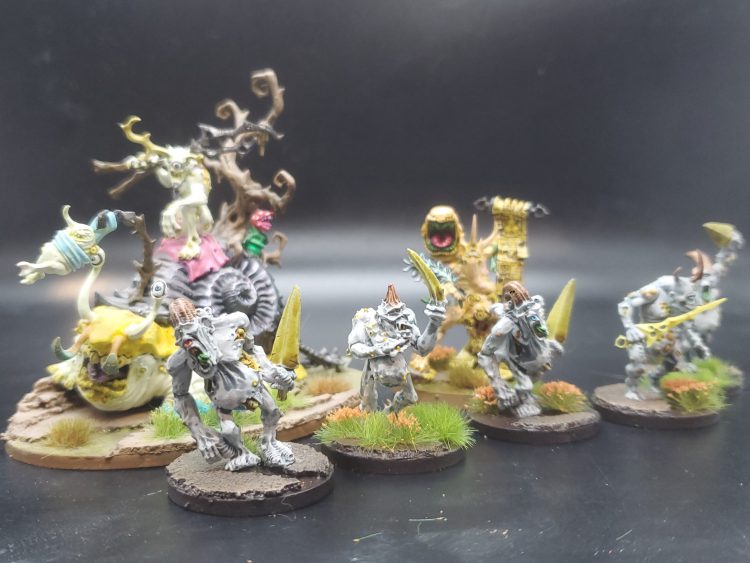
Lists
Nathan Bailey’s Undivided Daemons List
This list, which Nathan took to a 9th place list at the Objective Secured GT in Perth in February, is pretty much a prototypical Undivided Daemons list, running a Slaanesh Patrol alongside an Undivided Daemons detachment as a way to have both best-in-breed daemons from the faction and the Locus bonuses that Slaanesh Daemons depend on.
++ Chaos Daemons Patrol Detachment -2 CP [38 PL, -4 CP, 730pts] ++
Chaos Allegiance: Slaanesh
+ HQ +
Keeper of Secrets [12 PL, -1CP, 230pts]: Delightful Agonies, Exalted Keeper of Secrets, Hysterical Frenzy, Living whip. Random exalt
Keeper of Secrets [12 PL, -1CP, 230pts]: Exalted Keeper of Secrets, Hysterical Frenzy, Living whip, Pavane of Slaanesh. Random exalt
+ Troops +
Daemonettes [4 PL, 70pts]: Alluress, 9x Daemonette: 9x Piercing claws
+ Elites +
Fiends [10 PL, 200pts]: 5x Fiend: 5x Dissecting claws, 5x Vicious barbed tail
++ Chaos Daemons Battalion Detachment 0 CP [56 PL, 0 CP, 1,196pts] ++
Chaos Allegiance: Chaos Undivided
+ HQ +
Keeper of Secrets [12 PL, -1CP, 230pts]: Cacophonic Choir, Exalted Keeper of Secrets, Living whip, Symphony of Pain. Random exalt
Lord of Change [14 PL, -1CP, 270pts]: Bolt of Change, Exalted Lord of Change, Gaze of Fate, Incorporeal Form, Infernal Gateway, The Impossible Robe, Warlord. Random exalt
+ Troops +
Bloodletters [12 PL, -1CP, 249pts]: Banner of Blood, Bloodreaper, Daemonic Icon, Instrument of Chaos, 27x Bloodletter: 27x Hellblade
Horrors [12 PL, 249pts]: Daemonic Icon, Instrument of Chaos, Iridescent Horror, 27x Pink Horror: 27x Coruscating flames
Nurglings [2 PL, 66pts]: 3x Nurgling Swarms: 3x Diseased claws and teeth
Nurglings [2 PL, 66pts]: 3x Nurgling Swarms: 3x Diseased claws and teeth
Nurglings [2 PL, 66pts]: 3x Nurgling Swarms: 3x Diseased claws and teeth
Reinforcement points: 74
++ Total: [94 PL, 5CP, 2,000 pts] ++
The Standout Features
- A Trio of Keepers of Secrets
- The Impossible Robe Lord of Change with Incorporeal Form
- A Bloodletter Bomb
- A massive horror blob with reinforcement points to split them
This list pulls out a lot of the standard Daemon tricks. The Nurglings sit on objectives early and help force an opponent to choose between trying to pry them off objectives and taking care of the greater daemons. Meanwhile two of the Keepers can advance and charge innately and provide the same aura for the third if it’s within 6” of one of them in the Charge phase (be sure to do its Charge move first). The Bloodletters use the Banner of Blood to reliably charge out of deep strike, and the Horrors make use of those 74 reinforcement points to split as much as they can and keep spitting out Assault 3 shots while holding the middle of the table.
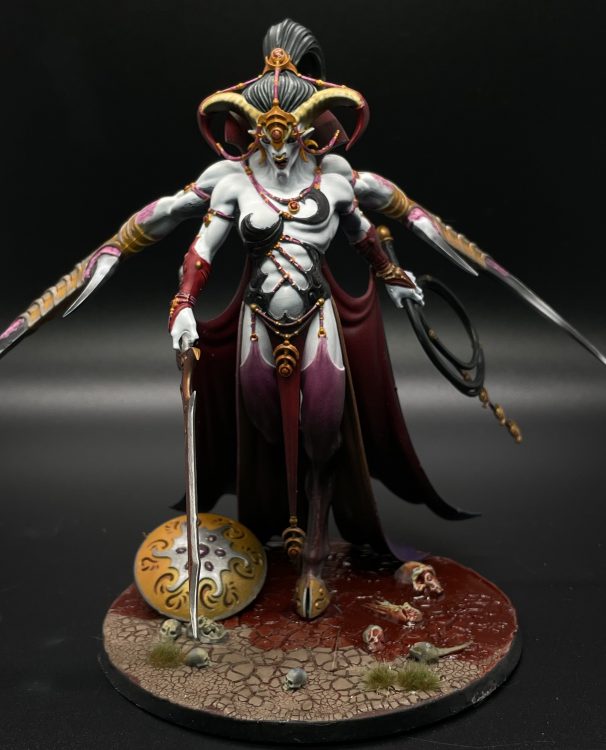
Asa Carlson’s Slaanesh Daemons List
Asa’s been running a version of this list since the new Keeper of Secrets model dropped in December 2019, with varying degrees of success. With 9th edition giving Slaanesh Daemons a huge boost, Asa’s been able to ride that to success at the top tables, and piloted this list to a 1st place finish at the Renegade Mini GT. Asa’s also finished the 2020 season first in faction for Chaos Daemons in the ITC.
++ Chaos Daemons Battalion Detachment (0 CP) [48 PL, -4 CP, 930pts] ++
Chaos Allegiance: Slaanesh
Rewards of Chaos (1 Relic) [-1CP]
+ HQ +
Keeper of Secrets [12 PL, -1CP, 240pts]: Celerity of Slaanesh, Delightful Agonies, Shining aegis, Silverstrike, Symphony of Pain, Warlord, Exalted Keeper of Secrets: 3. Blessing of the Dark Prince
Keeper of Secrets [12 PL, -1CP, 240pts]: Delightful Agonies, Shining aegis, Symphony of Pain, Exalted Keeper of Secrets: 2. Quicksilver Reflexes
Keeper of Secrets [12 PL, -1CP, 240pts]: Exalted Keeper of Secrets, Pavane of Slaanesh, Shining aegis, Symphony of Pain
+ Troops +
Daemonettes [4 PL, 70pts]: Alluress, 9x Daemonette: 9x Piercing claws
Daemonettes [4 PL, 70pts]: Alluress, 9x Daemonette: 9x Piercing claws
Daemonettes [4 PL, 70pts]: Alluress, 9x Daemonette: 9x Piercing claws
++ Chaos Daemons Vanguard Detachment (-3 CP) [53 PL, -3CP, 1,065pts] ++
Chaos Allegiance: Slaanesh
+ HQ +
Contorted Epitome [10 PL, 210pts]: Hysterical Frenzy, Phantasmagoria, The Forbidden Gem
Shalaxi Helbane [13 PL, 240pts]: Hysterical Frenzy, Living whip, Symphony of Pain
+ Elites +
Fiends [10 PL, 205pts]: Blissbringer, 4x Fiend: 4x Dissecting claws, 4x Vicious barbed tail
Fiends [10 PL, 205pts]: Blissbringer, 4x Fiend: 4x Dissecting claws, 4x Vicious barbed tail
Fiends [10 PL, 205pts]: Blissbringer, 4x Fiend: 4x Dissecting claws, 4x Vicious barbed tail
++ Total: [101 PL, 5 CP, 1,995pts] ++
The Standout Features
- Three Keepers of Secrets plus Shalaxi Helbane give opponents many large, fast targets to worry about and add redundancy to the list
- A very heavy Fiend presence to trap mid-table lists
Heavy Keepers lists have been competing throughout 9th edition, but Asa’s list is interesting in the number of Fiends it packs in. They’re a decent response to marine lists dedicated to controlling the middle of the board, and can act as a particularly powerful deterrent to units like multi-melta Invader ATVs and attack bikes, who have to bring themselves into strike range to operate but really don’t want to get tagged and trapped. Marines all having two wounds also makes the D2 claws of Fiends more valuable, but they’ll struggle against Plasma Inceptors or Vanguard Veterans.

Bjorn Cantrell’s Mostly Undivided Daemons
For something completely different, Bjorn took this to a 4-1 fifth place finish at the Warzone: The Dark Times event back in November. It’s notable for being very different form other Daemons lists, with Ahriman backing up a gigantic brick wall of (90) Plaguebearers and (65) Bloodletters, rounded out by the Nurgle buff characters and a Khorne Smash Prince.
++ Chaos Daemons Battalion Detachment (0 CP) [82 PL, -3 CP, 1,830pts] ++
Chaos Allegiance: Chaos Undivided
+ HQ +
Daemon Prince of Chaos [9 PL, 195pts]: Daemonic axe, Khorne, Oblivious to Pain, Skullreaver, Warlord, Wings
Sloppity Bilepiper [4 PL, 65pts]
Spoilpox Scrivener [5 PL, 100pts]
+ Troops +
Bloodletters [12 PL, -1CP, 265pts]: Banner of Blood, Bloodreaper, Daemonic Icon, Instrument of Chaos, 29x Bloodletter: 29x Hellblade
Bloodletters [12 PL, -1CP, 225pts]: Banner of Blood, Bloodreaper, Daemonic Icon, Instrument of Chaos, 24x Bloodletter: 24x Hellblade
Bloodletters [4 PL, -1CP, 105pts]: Banner of Blood, Bloodreaper, Daemonic Icon, Instrument of Chaos, 9x Bloodletter: 9x Hellblade
Plaguebearers [12 PL, 295pts]: Daemonic Icon, Instrument of Chaos, Plagueridden, 29x Plaguebearer: 29x Plaguesword
Plaguebearers [12 PL, 295pts]: Daemonic Icon, Instrument of Chaos, Plagueridden, 29x Plaguebearer: 29x Plaguesword
Plaguebearers [12 PL, 285pts]: Daemonic Icon, Plagueridden, 29x Plaguebearer: 29x Plaguesword
++ Auxiliary Support Detachment -2CP (Chaos – Thousand Sons) [9 PL, -2 CP, 170pts] ++
+ HQ +
Ahriman on Disc of Tzeentch [9 PL, 170pts]: Death Hex, Diabolic Strength, Doombolt
++ Total: [91 PL, 7CP, 2,000pts] ++
The Standout Features
- No Greater Daemons!
- Three units of Bloodletters with the Banner of Blood
- Three units of 30 Plaguebearers backed by a Bilepiper and Scrivener
This list is a bit of a blast from the past, running both the smash DP – a Daemon Prince of Khorne with the Skullreaver axe – and 90 Plaguebearers backed by the bilepiper and scrivener. The Plaguebearers get a huge boost in durability with their -1 to be hit from having 20+ models the Bilepiper compounds that by letting them roll 2D6 and take the lowest result when rolling for morale, giving them about a 1 in 3 chance of getting models back in any turn in which they’ve lost models. The Scrivener shores up their lousy Movement and boosts their damage output significantly. Keep both characters in the middle of at least two of the large blobs and you can methodically move up the table with the game’s strongest horde – just watch out for units that can pick off your characters.
The Bloodletters can all reliably make charges the turn they arrive from being placed in the Warp, and the Daemon Prince works well as a counter-charge threat to take out anything threatening your Plaguebearer blobs. Finally Ahriman is back as well, adding psychic support as one of the game’s best casters. Death Hex helps weaken key targets, Doombolt can help slow down key targets, and Diabolic Strength is there in case Ahriman has to get his hands dirty.
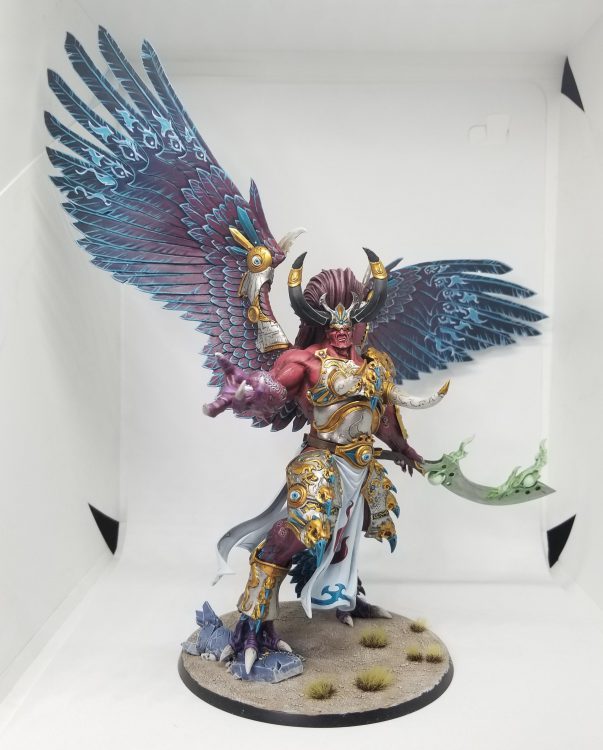
Patrick Persianni’s Chaos Soup
Patrick took this list to a 4-1 finish at the New Year’s Brawl GT in January, combining what’s essentially an Undivided Daemons list with Magnus the Red to have the one-two punch of Magnus and the Exalted Lord of Change. Note that this list predates the January 9th FAQ, and as such has the old points cost for Nurglings.
++ Battalion Detachment -3CP (Chaos – Daemons) [50 PL, 987pts, -6CP] ++
Chaos Allegiance: Chaos Undivided
+ HQ +
Keeper of Secrets [12 PL, 230pts, -1CP]: Exalted Keeper of Secrets, Hysterical Frenzy, Living whip, Symphony of Pain
Keeper of Secrets [12 PL, 230pts, -1CP]: Exalted Keeper of Secrets, Hysterical Frenzy, Living whip, Symphony of Pain
Lord of Change [14 PL, 275pts, -1CP]: Baleful sword, Bolt of Change, Exalted Lord of Change, Gaze of Fate, Infernal Gateway, The Impossible Robe
+ Troops +
NOTE: This list includes Nurglings at 18 points per model; the cost has since gone up to 22
Nurglings [4 PL, 72pts], 4x Nurgling Swarms: 4x Diseased claws and teeth
Nurglings [4 PL, 72pts], 4x Nurgling Swarms: 4x Diseased claws and teeth
Nurglings [2 PL, 54pts], 3x Nurgling Swarms: 3x Diseased claws and teeth
Nurglings [2 PL, 54pts], 3x Nurgling Swarms: 3x Diseased claws and teeth
++ Patrol Detachment -2CP (Chaos – Daemons) [33 PL, 547pts, -3CP] ++
Chaos allegiance: Slaanesh
+ HQ +
Keeper of Secrets [12 PL, 230pts, -1CP]: Delightful Agonies, Exalted Keeper of Secrets, Living whip, Symphony of Pain
Shalaxi Helbane [13 PL, 240pts]: Delightful Agonies, Hysterical Frenzy, Living whip
+ Troops +
Daemonettes [8 PL, 77pts]: Alluress, 10x Daemonette: 10x Piercing claws
++ Supreme Command Detachment +3CP (Chaos – Thousand Sons) [24 PL, 465pts, 3CP] ++
Magnus the Red [24 PL, 465pts]: Glamour of Tzeentch , Infernal Gateway, Warlord, Warptime, Weaver of Fates
++ Total: [107 PL, 6 CP, 1,999pts] ++
The Standout Features
- Magnus the Red as the army’s Warlord gives it a powerful psychic punch
- The Exalted Lord of Change wearing the Impossible Robe backs that up
- A trio of Keepers plus Shalaxi to rush across the table
- Nurglings to hold objectives from the start of the game
Here’s another Keepers-heavy list, though Patrick trades the Epitome, Daemonettes, and Fiends for Magnus, the Lord of Change, and Nurglings, concentrating more of his power in some very nasty characters. Something clever this list does is use a Slaanesh Detachment for Locus of Swiftness; Shalaxi and the Keeper of Secrets from that detachment will both gain the ability, and can use it to give the other two Keepers the ability to Advance and Charge, provided they are within 6” of them in the Charget phase. So as you run this list, think about pairing up your Keepers to ensure they get the bonus.
This list relies on Nurglings to occupy objectives from the start of the game and while it uses the old points values for them – 18ppm instead of 22 – in order to make room for this, you essentially have to cut one of the 3-model squads of Nurglings, which isn’t ideal but still leaves you with three units plus the Daemonettes to hold objectives.
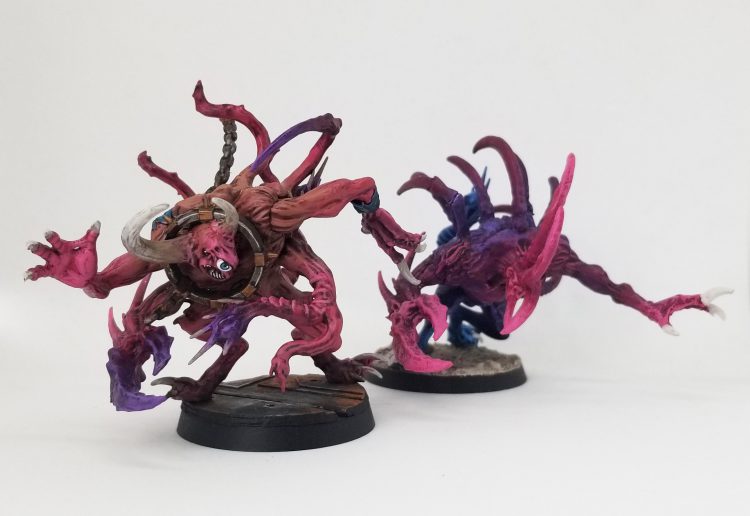
Matt Morosoli’s Chaos Soup
Matt’s list, which took first place at the Adelaide Uprising GT in late January, runs heavy on Daemons with a mixed god detachment and a Slaanesh detachment, and mixes in some Chaos Space Marines for some Terminators and additional psychic punch.
++ Chaos Daemons Patrol Detachment (0 CP) [686 pts, -1 CP] ++
Chaos Allegiance: Chaos Undivided
++ HQ ++
Lord of Change – Exalted Lord of Change -1CP (Exalted Trait: Aura of Mutibility), Powers: Bolt of Change, Gaze of Fate, Relic: impossible Robe, Warlord Trait: Incorporeal Form [270]
++ Elites ++
Beasts of Nurgle x5 [175]
Beasts of Nurgle x5 [175]
++ Troops ++
Nurglings x3 [66]
++ Chaos Daemons Patrol Detachment (-2 CP) [550 pts, -4 CP] ++
Chaos Allegiance: Slaanesh
++ HQ ++
Keeper of Secrets – Exalted Keeper of Secrets -1CP ( Exalted Trait: Blessing of the Dark Prince), Shining Aegis – 10 = 240, Powers: Hysterical Frenzy, Pavane of Slaanesh
Keeper of Secrets – Exalted Keeper of Secrets -1CP (Exalted Trait: Roll 2 & Apply Both), Shining Aegis – 10 = 240, Powers: Hysterical Frenzy, Symphony of Pain
++ Troops ++
Daemonettes x10 [70]
++ Chaos Space Marines Patrol Detachment (-2 CP) [760 pts, -2 CP] ++
Legion: Emperor’s Children
++ HQ ++
Chaos Sorcerer In Terminator Armor, Combi Bolter, Force Stave, Mark of Slaanesh, Powers: Prescience, Delightful Agonies [105]
++ Troops ++
10 Cultists, Autoguns, Mark of Slaanesh [60]
++ Elites ++
10 Chaos Terminators, Combi Bolters, Lightning Claws, Mark of Slaanesh, 2 Reaper Autocannons, Icon of Excess [300]
10 Chaos Terminators, Combi Bolters, Lightning Claws, Mark of Slaanesh, 1 Reaper Autocannon, Icon of Excess [295]
++ Total: [7 CP, 1,996 pts] ++
The Standout Features
- A truly horrific Chaos trifecta – the durable anchor of Beasts of Nurgle, fast hammer blows of Keepers and highly flexible reactive units in Chaos Terminators
- Keepers pay the extra points for the Shining Aegis, skewing this list even further towards durability and giving up no good targets.
- Two 5-model Beast of Nurgle units that can gum up the middle of the table and hold objectives
- Terminators lean on Honour the Prince and Excess of Violence to make themselves into incredibly reliable horde clearers out of deep strike.
Matt’s list opts to support a pair of Keepers and the Lord of Change with an Emperor’s Children detachment – this gives him access to Chaos Terminators and a Sorcerer. Rather than go with Noise Marines however he opts for 10 Terminators, who were already good before January’s FAQ and points adjustments, but now are 3 points cheaper with Lightning Claws that give them +1 attack each and re-rolls to wound, making them an absolute bargain. It gives them 41 S4, AP-2 wound re-rolling attacks that when paired with the Veterans of the Long War Stratagem means they can even put a hurt on T8 targets. Honour the Prince and Excess Violence also make them reliable and deadly melee combatants out of teleport and the Sorcerer can protect them with Delightful Agonies. They end up being extremely effective brawler units, coming down into gaps that need filling and rolling around the board until stopped.
While the Terminators take out hordes and get stuck in to longer brawls, the other hammer units in the list can take out more elite targets. At this point neither Big Bird nor Keepers of Secrets need much introduction – they’re both incredibly potent in their roles, being “unleashing psychic firepower while near indestructible” and “rampaging around the board murdering elite infantry”. They’re best-in-breed units, and combine with the Terminators to mean that this list’s victims are going to have nowhere to hide on the table, forcing a confrontation many will lose.
Even if by some miracle an opponent does chew through the big threats, they’re still going to find any attempt to pull back into primary scoring hampered by objectives being full of Beasts of Nurgle. This disgustingly cost-efficient sacs of wounds are great for providing a stable foundation while more mobile elements get the killing done, and as covered this list has plenty of those. They also provide a great wall for Big Bird to hide behind while throwing spells out if things get a bit tighter, and ensure that the few things that maybe could put one into the bin don’t get a chance. Imagine Nurgle and Tzeentch high-fiving over that one. It’s both disgusting and inscrutable.
Finally, a unit each of Daemonettes and Cultists provide some units that can handle Actions or hold objectives as needed. Although there’s only the two squads here, Tide of Traitors means it’s much more reasonable to swing for Deploy Scramblers regardless, because if there’s a safe ruin to hide in within your deployment zone, they can tick it off there turn one then redeploy elsewhere once the rest of the army have made a hole. And they’re gonna.
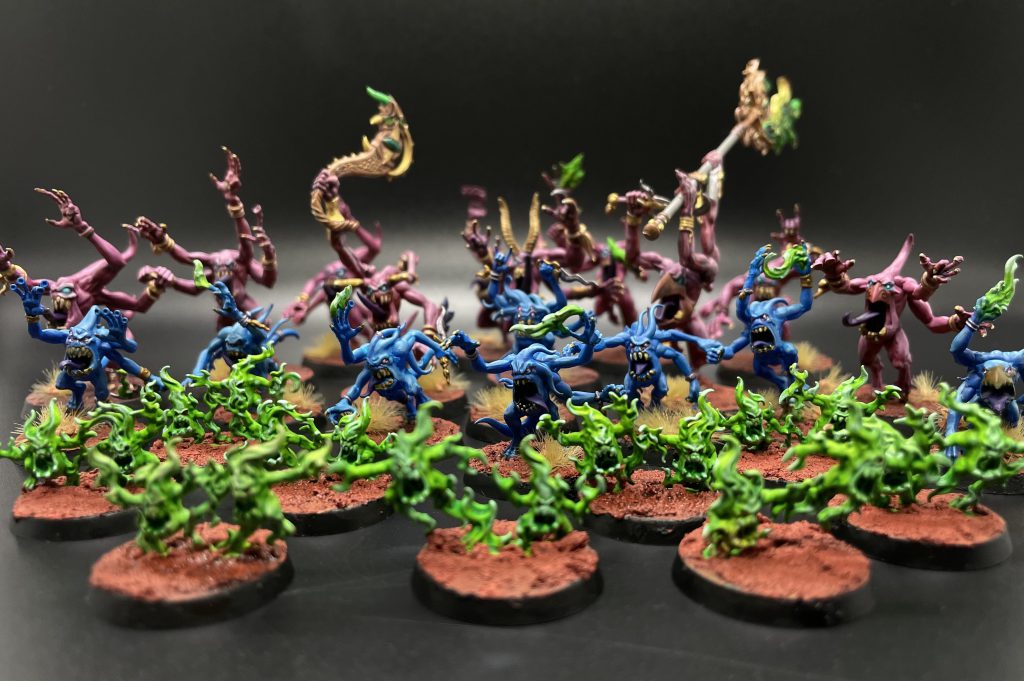
Mike Pestilens’s Recommendation for Pure Tzeentch Daemons
If you’re looking for what a non-Slaanesh mono-God army might look like, this Tzeentch list takes advantage of everything the faction does well.
++ Chaos Daemons Battalion (0 CP) [-3 CP]
Chaos Allegiance: Tzeentch
++ HQ ++
Lord of Change: Warlord: Incorporeal Form, Relic: Impossible Robe, Exalted (-1 CP): Random roll [270]
Lord of Change: Relic: Warpfire Blade (-1 CP), Exalted (-1 CP): Random roll [275]
The Changeling [105]
++ Troops ++
Pink Horrors x29, Incandescent Horror, Icon, Instrument [265]
Pink Horrors x29, Incandescent Horror, Icon, Instrument [265]
Pink Horrors x9, Incandescent Horror [80]
++ Elites ++
Exalted Flamer [60]
Flamers x5 [115]
Flamers x5 [115]
++ Fast Attack ++
Furies x5 [45]
Screamers x5 [130]
Screamers x5 [130]
Reinforcement Points: 145 (85 used to summon Changecaster from The Changeling or Exalted Flamer, rest to split Horrors to retain the 20+ size bonus as long as possible and move towards objectives or emergency summon Furies/Flamers)
++ 9 CP ++
The Standout Features
- Two Lords of Change, giving you a Warpfire Blade on the second
- Two units of Screamers and a unit of Furies give you lots of mobility
- Two huge horror blobs with points to split them
This list doubles up on the Lord of Change, which makes a lot more sense in a mono-Tzeentch list and gives you cause to take the Warpfire Blade. With The Changeling to provide the 6+++ Feel-No-Pain aura, both Lords of Change have the flexibility to roll for their Exalted rewards instead of one of them picking Aura of Mutability.
The Horrors are going to be key to controlling objectives in the middle of the table and you’ll be using reinforcement points to split them in order to keep more than 20 pink horrors in the unit for as long as possible (keep allocating new wounds to blue horrors) to keep your Assault 3 flames. The Furies, Exalted Flamer, and Screamers give you a lot of options in terms of Secondaries. You won’t table many opponents (although Custodes certainly want nothing to do with mono-Tzeentch Daemons!), but you’ll be able to score Secondaries like Raise The Banners High, Deploy Scramblers, and Psychic Secondaries often.
For the Dark Gods!
Daemons are the rare faction that is incredibly fun to both paint and play, while also being very strong on the tabletop. While their comparative power level has slipped slightly as other factions received updated 9th Edition codices, Daemons remain a force to be reckoned with on the competitive scene and are one of the game’s best armies. Have any questions or feedback? Email us at contact@goonhammer.com.
